An Insider’s Look: MOHAU MODISAKENG Making Waves In the International Art Scene Challenging the Status Quo BLACK-OWNED


TROORAMAGAZINE.COM ISSUE 1 VOLUME 6 | SPECIAL ‘23
THE BLACK HISTORY ISSUE
BRANDS WE LOVE Gifting Guide
Partnership Helping BLACK ENTREPRENEURS & Marginalized Diverse Creatives SEIZE THE AMERICAN DREAM Bridge to Success
Troo Gifts New



 Lucid Motors Luxury mobility company reimagining what a car can be.
Lucid Motors Luxury mobility company reimagining what a car can be.



 Lucid Motors Luxury mobility company reimagining what a car can be.
Lucid Motors Luxury mobility company reimagining what a car can be.


@vicnateng
Art Of Wearing
Ig
The




@vicnateng
Art Of Wearing
Ig
The


@vicnateng The Art Of Wearing
Ig





Instagram: @mabelchongjewelry
Facebook: mabelchongjewelry Twitter: @mabelSF


Pinterest: @mabelchongsf mabelchong.com

CRAFTED TO REFLECT THE NATURAL BEAUTY OF EACH FEATHER
brackish.com


GREENE
Green and gold peacock pair perfectly with deep green pheasant feathers for an iridescent and festive holiday bow tie style.
Band collar wrap with an adjustable strap and hook closure - fits neck sizes 11" to 20".
Bow tie dimensions are 2.5” tall and 4.5” wide.
Each feather used in production is all-natural and sustainably sourced. Feathers for bow ties are hand-selected, giving each finished piece unique coloring. Each bow tie is hand-crafted in Charleston, South Carolina and takes approximately five hours to make, start to finish.

FREE SPIRIT DROP EARRING
Crafted in burgundy and beige turkey feathers with a statement-making golden pheasant stripe, the Free Spirit Drop Earrings are sure to be a jewelry box staple throughout the season.
Feathers for each pair of earrings are hand-selected giving each pair a unique coloring. Each earring is 3” long and 1.125" wide. 24k Gold Plated stud with post push back. Suitable for sensitive ears (nickel-free and lead-free).

CRAFTED TO REFLECT THE NATURAL BEAUTY OF EACH FEATHER
brackish.com


eightroyale.com



 Founder Carla Truitt
- GabriellleGabrielle shoes are made of Sumptuous suede and daring good looks for slipping out on a midnight adventure.
Founder Carla Truitt
- GabriellleGabrielle shoes are made of Sumptuous suede and daring good looks for slipping out on a midnight adventure.


Every chocolate has a story.™ We are experts in designing chocolate gifts of appreciation that capture your love story or showcase the sheer elegance of your event.


phillipashleychocolates.com





Monday Gin™ ZERO CARBS | NO SUGAR | 0 CALORIES | VEGAN Stay Sharp Stay Sober Free Of Alcohol Full Of Spirit @drinkmonday | drinkmonday.co
celebrating us, the strong, resilient, and radiant women in our communities who inspire the world with our diversity and beauty
cocoacentric.com



celebrating us, the strong, resilient, and radiant women in our communities who inspire the world with our diversity and beauty
cocoacentric.com




TALLEYANDTWINE.COM TALLEYANDTWINE.COM

The Black History Issue
Happy New Year, World! We are thrilled and delighted to share TrooRa’s first Black History Issue with you. We are so excited for everyone to experience this special issue. Our entire staff worked hard on these pieces, but we would like to give special thanks to Andres Maldonado and Sherdellah Anunciado, our Design Editors, for their outstanding leadership and creative abilities.

In this special issue, we highlight and celebrate the accomplishments of tremendous individuals, the heroic history and extraordinary achievements of Black people in general within local and global communities. Whether through spotlighting their exceptional work in many categories, including founder stories and struggles of innovative emerging brands, art, travel, tech, home design, culinary, fashion, and more, or highlighting celebrities and politicians' notable efforts to advance black education, health, and wealth.
It is an absolute dream to publish a full issue showcasing black excellence. In Home Design, we showcase the exquisite work of three beloved Interior Designers, Courtney McLeod, Leah Alexander, and Corey Damen Jenkins. In Culinary, we share Bertony Faustin’s story of how he came to create Abbey Creek Vineyards and spotlight some of the best chefs changing the narrative and our taste buds with their innovative cuisines and ingredients.
Our cover feature focuses on the story of contemporary artist Mohau Modisakeng making waves in the international art world. This feature brought us some sleepless nights at TrooRa Magazine and has been one of the most difficult decisions we’ve had to make as a team. Choosing this cover was a robust undertaking. The images are all so stunning, breathtaking, meaningful, and poignant that we decided to give you the option of Three Covers, a first for TrooRa Magazine. We have new features in Fashion, Beauty, and Wellness, as well as Health & Fitness and Science.
In Troo Gifts, our new gifting guide, Black Owned Brands we love will aid you in discovering some rare gems.
As you know, our goal is to continue to bring our digital issues to life with print, but we’ve had to make some concessions. The thought of having to reduce the number of pages to help with printing costs is always challenging, but I find myself at a crossroads, especially with this special issue… So many delightful stories to share that we could not diminish or scale down on this astounding issue.
You will be engulfed with the images, stories, and our first two videos in this issue. Yes, I said videos… We hope you are as excited as we are to be introduced to new brands and support them not just during Black history month but every day. With each issue, our goal is to continue to inspire, innovate, and bring you the latest and greatest in the world of publishing today. We believe we have done it here. A delightful surprise can be found on pages 150 and 220. We know you will revel in it!
Trystanne Cunningham Editor-In-Chief Creative Director Founder Charles Schoenberger

EDITOR’S NOTE
TROORA MAGAZINE 30
Special 23



troora.com Create, Inspire, Grow Discover TrooRa SIX - MONTH DIGITAL FREE TRIAL Scan me to Play Video


TrooRa’s Sustainability Efforts



TrooRa is committed to building a sustainable business model promoting and protecting the environment. Our digital platform on troora.com offers a conscious approach, creating an immersive space.
With your help in building robust online support, TrooRa will print fewer magazines to ensure we remain a leader in the industry. However, when TrooRa produces print issues, we will uphold the highest quality in sustainable standards.
The magazine you are reading is:
printed on fully recycled paper
printed with vegetable-based ink and biodegradable laminates
printed in close proximity to our markets in an effort to reduce distribution emissions




benjaminbabadi.com
Premium quality Tuscan leather, hand-stitched, features brass hardware designed and produced in Tuscany
To uplift, inspire, and empower women all over the world, playing any variety of roles, and at all ages through clothing and community that helps you feel like your best self and reach your highest potential.


madisonsavile.com



A great Blazer can only go so far...
Founder
TRYSTANNE CUNNINGHAM
CREATIVE ART DEPARTMENT
Creative Director TRYSTANNE CUNNINGHAM
EDITORIAL DEPARTMENT
Editor In Chief TRYSTANNE CUNNINGHAM
Copy Editor AMANDA ORAHA
Editorial Design Director SHERDELLAH ANUNCIADO
Creative Art Director ANDRES MALDONADO
Proofreading CRISTINA DEPTULA
Proofreading MICHAEL DAKS
ART DEPARTMENT
Graphic Design Director SAMMY CAMPANER
ADVERTISING DEPARTMENT
Global Brand Outreach KATIE LISTER
European Brand Outreach MANSOUR NDIAYE
HUMAN RESOURCES DEPARTMENT
HR Director PETA-GAYE WILLIS
OPERATIONS DEPARTMENT
Operations Director TRYSTANNE CUNNINGHAM
ADMINISTRATIVE DEPARTMENT
Executive Administrative Assistant RONA MAGLINES

Virtual Administrative Assistant INNAH MARIE ALMARENIA
MARKETING DEPARTMENT
Marketing Director KWESI DONTOH
SOCIAL MEDIA MARKETING DEPARTMENT
Social Media Director JUSTICE ANN CUENCA
FINANCE DEPARTMENT
Finance Director RONA MAGLINES
WEB & SYSTEMS DEPARTMENT
Web Design & Development MATT SCHULER
Web Maintenance AMANDA POWELL
Systems & Operations Director ALESSIO MONINO
PRESS DEPARTMENT
Press & Public Relations BARBARA WICHMAN
LEGAL DEPARTMENT
Legal CHINWE OHANELE
WRITING DEPARTMENT
Contributing Writer MICHAEL DAKS
Contributing Writer NIZIE LOKMAN
Contributing Writer JESSE ADUMA
Culinary Contributing Writer CARY WONG
Contributing Writer CRISTINA DEPTULA
Travel Contributing Writer FILIPA ARAÚJO
Fashion & Beauty Contributing Writer STELLA POLIZOIDOU

Beauty Contributing Writer NEHA SURADKAR
Contributing Writer GEORGE DIKE
Contributing Writer KEVIN JEFFREY JAMES
Contributing Writer ROBYN ALEXANDER
Contributing Writer VICKI SLEET
Contributing Writer GREG COX
Contributing Writer MANDY ALLEN
Contributing Writer TUDOR CARADOC-DAVIES
Contributing Writer ELSA YOUNG
Contributing Writer GRAHAM WOOD
Contributing Writer TARA SLOGGETT
STYLING DEPARTMENT
Styling Contributor SHELLEY STREET
Styling Contributor MICHELLE RIVET
Styling Contributor EMILY PAYNE
Styling Contributor INGA TARELAITE
PHOTOGRAPHY DEPARTMENT
Contributing Photographer MICHAEL DAKS
Contributing Photographer GAELLE BELLER
Contributing Photographer WARREN HEATH
Contributing Photographer KWAME ACHEAMPONG
Contributing Photographer COURAGE MUEGBEYOGHO
Contributing Photographer GILBERT ASANTE
Contributing Photographer CHARLES SCHOENBERGER
FOLLOW US @TROORAMAGAZINE • INSTAGRAM • PINTEREST • FACEBOOK • LINKEDIN • SPOTIFY • YOUTUBE • TIKTOK TROORA MAGAZINE, MEDIA AGENCY, CREATIVE ADVERTISING AND DIGITAL MARKETIG FIRM • A FORTUNEST GROUP LLC PO BOX 152 • BRISBANE CA 94005 • 833∙755∙7273 HELLO@TROORAMAGAZINE.COM • TROORAMAGAZINE.COM © 2023 TROORA MAGAZINE LLC. ALL RIGHTS RESERVED. RECYCLED PAPER 100% PCW. PRINTED IN THE UKTHE BLACK HISTORY ISSUE SPECIAL ‘23 ISSUE 1 VOLUME 6
TROORA MAGAZINE 38
DURABLE FOR PERFORMANCE COMFORTABLE FOR EVERYDAY WEAR
A SPECIALTY LINE OF UNDERWEAR AND HOSIERY MADE IN 12 SHADES OF NUDE TO REFLECT THE FULL SPECTRUM OF SKIN TONES. NUDEBARRE.COM



IG @NUDEBARRE




estellecoloredglass.com
JEWELS FOR YOUR TABLE



Thiscollection:AmberSmoke&Yellow
vintage-inspired yet refined and modern colored glass collection that starts a revival of colored glass that is reminiscent of a past time


Armenian brandy made from Armenian white grapes and spring water
en.araratbrandy.com


ARARAT ENCOURAGES RESPONSIBLE DRINKING

Home Design & Decor 76 HISTORICAL INSPIRATION FOR AN INNOVATIVE HOME 88 RIGHT MEETS LEFT INTERIOR DESIGN 100 BEAUTY IS ABUNDANT Culinary 116 CHANGING THE WINEMAKING GAME 124 FOOD FROM THE SOUL 134 LIFE IS A CIRCLE 144 REAL LIVE WILLY WONKA! Right Meets Left 88 COURTNEY MCLEOD SAYS “GET BEYOND THE BEIGE!” CONTENTS Travel 154 ENRICHING BLACK WOMEN 162 TIME-TRAVELING THROUGH HISTORY 170 MELANIN ON THE MAP 180 JESSICA NABONGO TROORA MAGAZINE 44



180 Jessica Nabongo MAKING BLACK HISTORY UNFORGETTABLE 144 Real Live Willy Wonka!
45 TROORA BLACK HISTORY ISSUE 2023
CHOCOLATIER PHILIP ASHLEY RIX
ethically grown, certified-organic hemp and essential oils



organic certified CBD* made in the United States sustainable packaging made in Italy



LUXURY
MANAGEMENT SYSTEMS
ADVENTURE
INTO THE SOCIAL TRADITION OF THE HOOKAH EXPERIENCE Transform To Transcend kaloud.com
HEAT
IMMERSING
SEEKERS
Krysalis Eltheria
They’re not hookahs, they’re better. Krysalis are Hookahs Evolved. Kaloud’s Krysalis Eltheria offers the best smoking experience. It combines high quality materials, jaw-dropping aesthetics and state-of-the-art technology to create tastier, smoother, cleaner clouds from each shisha puff.




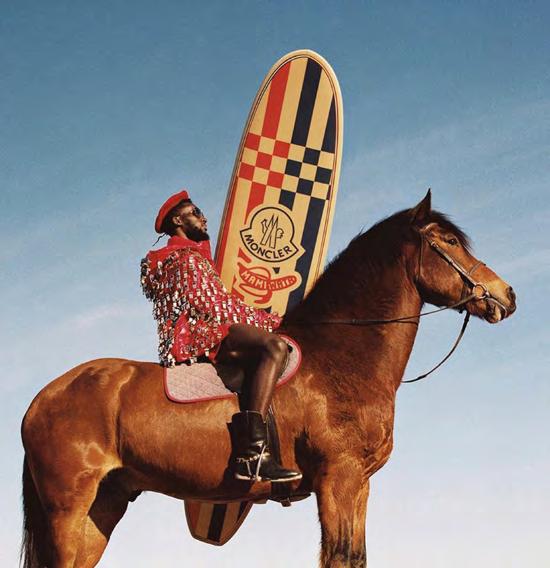
240 250 Flesh-Tone Required Mami Wata 190 INVISIBLE BORDERS 200 REBUILDING CHICAGO 232 BLOG TO STREETWEAR 240 FLESH-TONE REQUIRED 250 MAMI WATA IS THE SPIRIT OF AFRICAN SURF 258 WEARABLE MODERN ART Fashion & Accessories Challenging the Status Quo 210 ERIN CARPENTER IS BREAKING BARRIERS THROUGH NICHE FASHION WITH NUDE BARRE THE FIRST AFRICAN SURF BRAND IS MAKING WAVES THROUGHOUT THE GLOBAL SURF CULTURE AN INSIDER’S LOOK INTO MOHAU MODISAKENG’S WORLD AND ALL ITS INTRICACIES Art, Music, & Film TROORA MAGAZINE 50


270 FROM CJ WALKER TO RIHANNA 280 STAND IN LOVELAND Beauty Wellness 270
CJ Walker to Rihanna
BEAUTY INDUSTRY 51 TROORA BLACK HISTORY ISSUE 2023
From
BLACK WOMEN WHO TRANSFORMED THE




The World’s Finest, Consciously Made Handbags behno.com



Personalized guidance that’s unparalleled.
aylabeauty.com

Healthy beauty that works.
Founder Dara Kennedy

290 LOGGING ON TO HEALTHY LIVING 294 BLACK HEALTH MATTERS Health & Fitness 302 54 GENE Science & Innovation 310 BRIDGE TO SUCCESS 316 BLACK GIRL MAGIC 322 BLACK HISTORY MONTH 328 COLOR OF LOVE 334 NOMADIC PRESS 340 TOWARDS WAKANDA 344 POCHINO PRESS Special Interest Troo Gifts 350 BRANDS WE LOVE TROORA MAGAZINE 56


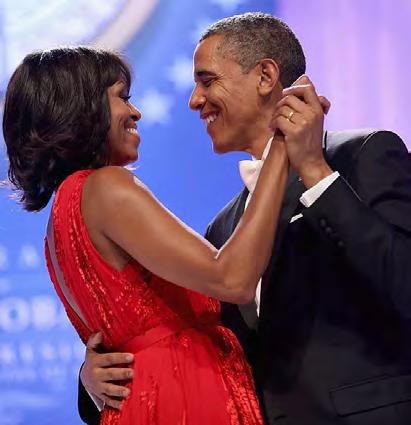
302 54 Gen EQUALIZING PRECISION MEDICINE AND BUILDING DIVERSE DATA SETS ACROSS AFRICA 328 Color of Love INSPIRATIONAL BLACK POWER COUPLES Black Health Matters 292 A DIVE INTO THE LIVES AND ACCOMPLISHMENTS OF THE FOUNDERS OF BLACK HEALTH MATTERS, A BLACK-OWNED ORGANIZATION. 57


dlish.us


A carefully chosen selection of items for people that enjoy “the finer things in life.”
Sustainable Luxury

Designed In London
Crafted In The UK
laurapitharas.com


@ABBEYCREEKWINE
@AFLAVIANTRINDADE
@ALAFFIA
AMERICAN_BEACH_OLD/
AMERICAN_BEACH_NEW
AMINE M’SIOURI
@ASHLEY_MILANI
ATIKH BANA UNSPLASH
BALANDA ATIS
BEALE_STREET_OLD/
BEALE_STREET_NEW
BLACK GIRLS TRAVEL TOO
BRANDON STANCIELL
BRONZEVILLE_OLD/ BRONZEVILLE_NEW
CLARKE SANDERS

CLAUDE PICHE
UNSPLASH
CLAUDE PICHE
COREY DAMEN JENKINS
COURTNEY MCLEOD
DANILO ANDJUS
DANNY RIVERS
DAVID CLODE ON UNSPLASH
DAZZLE JAM
DELMAINE DONSON
DORCHESTER_1 AND DORCHESTER_2
@EVAROEFS
FANM MON
E-I N-R
INVISIBLE BORDERS TRANSAFRICAN ORGANISATION ISTOCK
JAANUS JAGOMAGI UNSPLASH

JACOB LUND
JACOB OWENS ON UNSPLASH
@JAQLINMEDLOCKPHOTOGRAPHY
JASMINE CLARK
JASON HAFSO UNSPLASH
@JESSICANABONGO
@JETANDREED
JOSH SWINNEY
@_JOSH_BX
@CHAVIE.ALLIE
JOHNSON PUBLISHING COMPANY
LAB_1 AND LAB_2
LEAH ALEXANDER
LOVELAND FOUNDATION
@MAMIWATASURF
@MELANINONTHEMAP
GODISABLE JACOB ON PEXELS A-B I-J C-D L-M
MIA YAJEL
MOHAMMAD MASAAU
UNSPLASH
MOHAU MODIKASENG
MYLES LOFTIN
S-W
NATE TYLER
NOMADIC PRESS
@NOEMIEMARGUERITE
POCHINO PRESS
@RAHHELWOLDU
RANKIN
RICHARD GRAY GALLERY
RUDY BALASKO
@SANCHOSSHOP
SARA POOLEY
TAYLOR HILL @THELIFEOFDANMBO @THEJUNGALOW THE PAT MCGRATH LABS
TOM HARRIS @TOMTEBET
@TRADESTJAMCO
TURNBO FAMILY
WOODSON_NEW WOOLWORTH_OLD / WOOLWORTH_NEW
54GENE
photographers IN THIS ISSUE














contributors IN THIS ISSUE 1 TRYSTANNE CUNNINGHAM Editor-in-Chief 2 SHERDELLAH ANUNCIADO Editorial Design Director 3 AMANDA ORAHA Copy Editor 4 CLARE CORBOULD Contributing Writer 5 NIZIE LOKMAN Travel & Wellness Contributing Writer 6 CARY WONG Culinary Contributing Writer 7 CRISTINA DEPTULA Contributing Writer 1 2 3 11 4 5 6 7 8 9 8 NEHA SURADKAR Fashion and Beauty Contributing writer 9 FILIPA ARAÚJO Travel Contributing Writer 10 STELLA POLYZOIDOU Fashion and Beauty Contributing Writer 11 GEORGE DIKE Technology Contributing Writer 12 JESSE ADUMA Health and Fitness Contributing Writer 13 KEVIN JAMES JEFFERY Sports Contributing Writer 12 13 10 63
The Black History Issue Special 23
PHOTOGRAPHED BY: MOHAU MODISAKENG
WRITTEN BY: FILIPA ARAÚJO
This issue caused quite a dilemma for our team in choosing a cover. These were the images and their stories from which we had to choose. Which would you choose? Tag us on IG with the hashtag #BHICover23Mohau and tell us your favorite.
INZILO
“Inzilo is an isiZulu word meaning ‘mourning’ or ‘fasting’. As in many of his films and images, Modisakeng’s body occupies center stage in this work. He enacts a mourning ritual by sitting, standing, and rotating slightly, all the while throwing a burnt, ashy substance into the air. Extreme close-ups of his body begin to suggest the shedding of a skin, as though the ash is falling from his limbs as the ritual proceeds. He performs an elaborate rite of passage in which the initiate seems to draw the material for his transition from within his own body. In the absolute purity and focus of the moment, Modisakeng is turned inwards but gesturing outward, undergoing a mysterious transformation that is at once a private ceremony and a public declaration.” - Mohau Modisakeng Studio
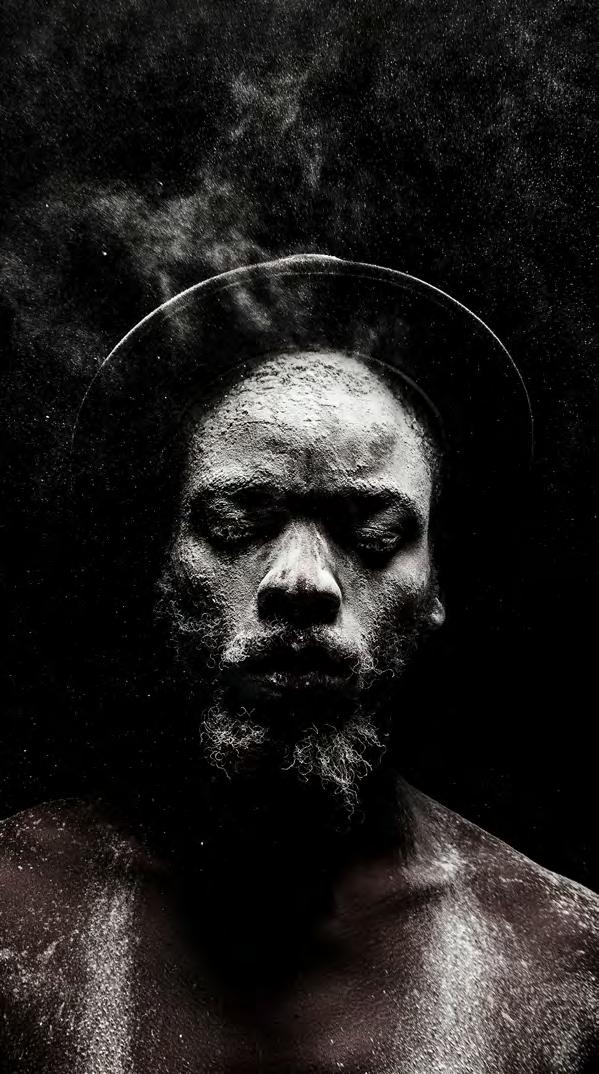

STORY BEHIND THE COVER:
INZILO
64
UNTITLED (METAMORPHOSIS
6)
PASSAGE
“Passage is a three-channel projection that meditates on slavery’s dismemberment of African identity and its enduring erasure of personal histories. In each of the artwork’s three projections, we are confronted with a character – a woman with a hawk perched on her arm, a young man in a Trilby hat and a woman wrapped in a Basotho blanket. As the passengers lie motionless on their backs looking up at the sky they begin to perform a series of actions that move between gestures of struggle and resignation. A pool of water slowly forms beneath their bodies. The rising water gradually floods the well of the boat eventually leaving the passengers submerged while the boat is slowly sinking and eventually disappearing.



In Passage, the ebb and flow of water, as both life-giving and deadly, symbolizes the many who have arrived or departed from South Africa in trade, as cargo or as transient bodies belonging to no particular state. In Setswana the experience of life is referred to as a ‘passage’. The Setswana word for life, botshelo, means ‘to cross over’. As such, all human beings are referred to as bafeti (‘voyagers’), a word that points to the fact that the experience of life is transient; it has a beginning and an end, as with any voyage.”
Mohau Modisakeng Studio
LAND OF ZANJ
“The hope with a work like Land of Zanj is to continue to restore the lost place of black histories as a means to reclaim the power of each and every individual who were forced to flee their homes, or taken to be sold into slavery, or confined and controlled, as in South African history. A work engaging such themes attempts to draw on the many similarities in the experience of black bodies under the oppressive regimes everywhere throughout history. In all these historic migrations there are traces of our humanity with stories that have the potential to restore that which for centuries has been misplaced.”
Mohau Modisakeng
-
-
LAND OF
65
PASSAGE
ZANJ
YEARLY PRINT SUBSCRIPTION

For less than $3 a day receive quarterly digital & print TrooRa Magazine and TrooRa Living issues + one additional special issue yearly - Unlimited access to troora.com & complete digital & online archive.

Discover emerging brands, products, and stories, championing innovative leaders and entrepreneurs, gain access to resources for diverse equity campaigns educating and enriching BIPOC communities.


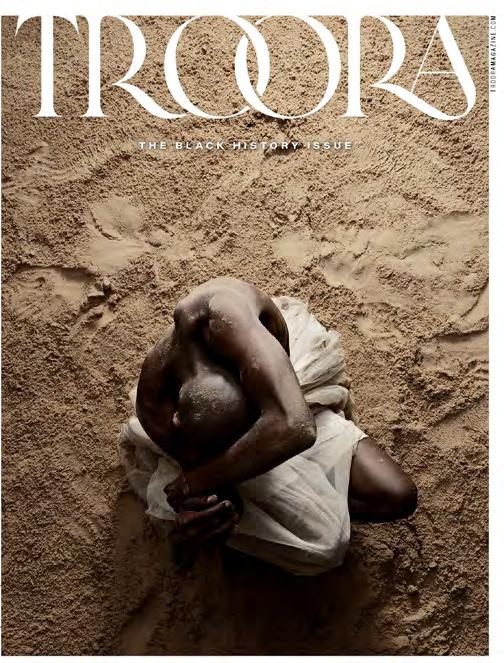


67 TROORA BLACK HISTORY ISSUE 2023






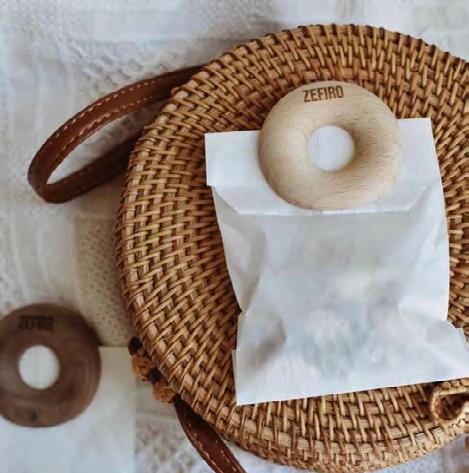
yoursustainablehome.com
Plant-based designs bringing the outside in & celebrating the natural world



fableandbase.co.uk


 Founder Francesca Baur
Founder Francesca Baur



THE WORLD’S FINEST HIDE RUGS
kylebunting.com
Home Design & Decor
76
HISTORICAL INSPIRATION FOR AN INNOVATIVE HOME COREY DAMEN JENKINS CLASSIC INTERIORS WITH NO EXPIRATION DATE BY: CRISTINA DEPTULA

88
RIGHT MEETS LEFT INTERIOR DESIGN COURTNEY MCLEOD SAYS “GET BEYOND THE BEIGE!” BY: CRISTINA DEPTULA
100
BEAUTY IS ABUNDANT EXPANSIVE DESIGN LEAH ALEXANDER SEEKS TO ELEVATE YOUR SPACE BY: CRISTINA DEPTULA
TROORA MAGAZINE 74

75
Historical Inspiration for an Innovative Home
Corey Damen Jenkins: Classic Interiors With No Expiration Date
PHOTOGRAPHED
BY:
COREY DAMEN JENKINS
WRITTEN BY: CRISTINA DEPTULA
Innovative Home N
YC-based designer Corey Damen Jenkins, winner of HGTV’s Showhouse Showdown, loves to mix vivid colors with layered patterns for an inventive and unique look. His inspirations come from both old and new: classic design elements such as dark brown wooden furniture and the haute couture runway.

“My goal is to ensure that my clients’ projects are always classic, livable, and without an expiration date,” Corey states.
His new book, Design Remix: A New Spin on Traditional Rooms, showcases what he calls his “colorful, youthful traditionalism.” In the book, he illustrates how to reimagine vintage interior decor for modern tastes. This includes techniques such as pairing light and dark colors, accessorizing with couture-inspired decor, highlighting a traditional interior with minimalist accessories, and creating a salon-style wall to showcase artwork.
76
TROORA MAGAZINE

77
Corey Damen Jenkins

TROORA MAGAZINE 78
PROFESSIONAL RECOGNITION
Corey is an inducted member of Elle Decor’s A-List and Architectural Design’s AD100 List. He’s served as a guest expert on the Rachael Ray show and Open House TV and has been featured in the Wall Street Journal, Vanity Fair, House and Garden, the New York Times, and the Detroit News. Traditional Home magazine also awarded him the New Trad Rising Star of Design. Invited to teach a MasterClass, he produced a program teaching viewers how to craft their visions with lighting, color, patterns, and furniture.
“Corey’s magic is in making any space feel polished, inventive, and timeless while still making design accessible to everyone,” said David Rogier, founder and CEO of MasterClass.
Corey was invited to design the formal “Lady's Library” in 2019 and Dining Room in 2021 for the renowned Kips Bay Decorator Show House. His goal in 2021 was to showcase the “point where antiquity and modernity meet in a post-pandemic world.”
Starting with the tented room style made famous by Napoleon, Corey surrounded two modern tables with Louis XVI chairs, brass lamps, and a Versailles parquet floor. He considered that the tables could be used for modern purposes that took off during the pandemic, including supervising children as they study or running a home office. Also, in keeping with his repurposed vintage sensibility, he was chosen to design the speakeasy for Flower magazine’s first-ever showhouse.

79
“My goal is to ensure that my clients’ projects are always classic, livable, and without an expiration date,” Corey states.
It celebrates the merging of Art Deco, Neoclassicism, and modernity, with a palette of blush, creme, black, robin’s egg, merlot, sage green, and gold. This was unveiled in Atlanta in September, and according to Corey, was a statement that one can design underground rooms that are fresh and light, not stereotypically dark and moody like a “man cave.”
In his regular work, Corey loves to incorporate and repurpose historical elements, including Regency mirrors, wood-carved flourishes from centuries ago, and entire homes built in the 18th century. He incorporates bright colors, including yellows, and modern furniture comfortable for lounging, making the places livable and elegant.


TROORA MAGAZINE 80

81

TROORA MAGAZINE 82
OTHER ARTISTIC EXPRESSIONS
Corey also creates lead and ink portraits, and his most recent series, “Mouths Wide Open,” showcases people of various race and gender vocalizing. These include an Asian opera singer, a Jewish rabbi, and a breast cancer survivor expressing her determination.
In addition, in a partnership with Aria Stone Gallery, Corey carves pieces that highlight and accentuate the natural beauty of the marble and quartzite raw materials he uses, formed over thousands of years. Also, he designs art nouveau fabric through Kravet Couture and furniture through Hancock and Moore.
He is a major supporter of the Boys & Girls Club of America and founded a mentorship and scholarship program with the New York School of Interior Design. Through giving back to up-and-coming designers, he hopes to carry the long tradition of beautiful living spaces into the future.

INSTAGRAM.COM/COREYDAMENJENKINS FACEBOOK.COM/COREYDAMENJENKINSASSOCIATES
83



Designed and hand-produced stoneware ceramic table lamps from the Catskill Mountains of New York

STONEANDSAWYER.COM
lunasundara.com

 Peruvian Wall Mirror - Black Sunburst
Peruvian Wall Mirror - Black Sunburst

Right Meets Left Interior Design
Courtney McLeod Says “Get Beyond the Beige!”
PHOTOGRAPHED BY: COURTNEY MCLEOD
WRITTEN BY: CRISTINA DEPTULA
Interior designer Courtney McLeod says it’s time to “get beyond the beige.” Based in NYC, she showcases a variety of home and business interiors full of vibrant pinks, oranges, greens, blues, grays, browns, and yellows.

Her work suggests that people are moving away from simple and subdued looks toward bolder interiors.
In a November 2022 interview with Architectural Digest, McLeod says she’s “seeing an embrace of maximalism over minimalistic styles. Sofas drenched in color, pattern, trim, fringe, and pillows. Velvets continue to be a popular fabric choice, as well as bold prints.”
TROORA MAGAZINE 88

89 TROORA BLACK HISTORY ISSUE 2023
Courtney McLeod

TROORA MAGAZINE 90
Some of the interiors she showcases on social media include balloons, huge floral arrangements, intricate paintings on living room walls, and touches of whimsy, such as bananas painted over an entire hallway near a child’s bedroom.

To McLeod, there isn’t one singular look that screams “good taste.” The ultimate luxury, as she says, is the ability to personalize your space.
HOW FINANCE PREPARED HER FOR FULL-BRAINED DESIGN
Courtney McLeod’s business handles a wide range of projects, from an interior decor refresh for a client’s apartment to a full-scale commercial project, working in consultation with architects to design a building from the ground up.
The name comes from her concept of combining right-brain aesthetic sense with left-brain analytical concerns for detail, analysis, and return on a client’s investment.
McLeod worked in finance for 15 years before becoming a
designer, earning a business degree from the Wharton School of the University of Pennsylvania and becoming a leading portfolio manager in real estate private equity. She brings the rigor and logic she learned from that into her current line of work. Also, having managed finances for real estate developers gave her a sense of how to speak their language and provide effective assistance with staging commercial properties for sale.
McLeod says that she’d have made the career transition into her true passion earlier if she’d known how well her background would prepare her for entrepreneurship. She also suggests that other aspiring designers learn the basics of business accounting before opening their studios.
Born and raised Creole in New Orleans, McLeod says her background has informed her taste, along with her extensive travels throughout Europe and Asia. Although she currently lives in Harlem, she says she’ll always be a Southerner at heart.
91 TROORA BLACK HISTORY ISSUE 2023
“Pattern and color are such powerful tools to create emotional moments in your home—don’t be afraid to use them.”

TROORA MAGAZINE 92
PROFESSIONAL RECOGNITION
McLeod debuted on the Elle Decor A-List as someone who “does not fear a yellow wall or quake at the sight of an orange sofa.”

She received the Rising Star Award from Decoration and Design Building in 2022, was named an Emerging Designer To Watch by Luxe Magazine in 2019, and made the 1stdibs Top 50 Interior Designers List in 2022.
House Digest considers her one of the most inspiring Black interior designers to watch and encourages people to follow her on Instagram. NBC’s Open House NYC featured some of her interiors as part of a series on “homes that aren’t afraid to take chances.”

Also, one honor that makes McLeod extremely grateful is her recent election to the Board of Trustees of the New York School of Interior Design.
“I look forward to making the most of this opportunity to open doors in the industry for students and designers of color. A decade ago, an introductory course at this school was my first baby step into the industry and a new life. This is a true full-circle moment. I hope to make all those who have opened doors for me along the way proud.”
93 TROORA BLACK HISTORY ISSUE 2023


TROORA MAGAZINE 94
“We utilize a kaleidoscopic toolbox of texture, pattern, and color to create a singular and cohesive expression of each client’s unique personality and lifestyle.”
BOLD, BESPOKE INTERIORS

McLeod’s favorite clients are new homeowners and empty-nesters, people looking to move into a new phase of life. She loves to work with people in transition to create bespoke interiors that fit their lifestyles and reflect their personalities.

She explains, “We utilize a kaleidoscopic toolbox of texture, pattern, and color to create a singular and cohesive expression of each client’s unique personality and lifestyle.”
She encourages clients to get out there, take risks, and boldly express their personal styles.
McLeod says, “Pattern and color are such powerful tools to create emotional moments in your home— don’t be afraid to use them.”

FACEBOOK.COM/RIGHTMEETSLEFTINTERIORDESIGN INSTAGRAM.COM/RIGHTMEETSLEFTINTERIORDESIGN
95 TROORA BLACK HISTORY ISSUE 2023
A VESSEL COMPANY

TIMELESS AND UNIQUE VESSELS. MODERN MINIMALISTIC CERAMICS AND PAPER MACHÉ VESSELS HANDMADE TO FILL YOUR HOME.

SPARSANDMINIMAL.COM




desserto.com.mx


 The world’s first highly sustainable and environmentally friendly organic material made of Nopal cactus, also known as the prickly pear.
The world’s first highly sustainable and environmentally friendly organic material made of Nopal cactus, also known as the prickly pear.
Beauty Is Abundant Expansive Design: Leah Alexander Seeks to Elevate Your Space
 PHOTOGRAPHED BY: LEAH ALEXANDER
WRITTEN BY: CRISTINA DEPTULA
Leah Alexander
PHOTOGRAPHED BY: LEAH ALEXANDER
WRITTEN BY: CRISTINA DEPTULA
Leah Alexander
To Leah Alexander, interior design should make you feel as if you’re showing up as your best self.
“My mission with Beauty Is Abundant is to make our clients feel like they’ve made it. When you hire us to serve you, you have made it.”
Her firm serves commercial and residential clients, so her online portfolio regales us with a mixture of elegant home offices she describes as “feminine,” fun children’s bedrooms with hanging chairs and giraffes, and luxury hotel suites. They have also worked with a salon, whose interior is showcased to reveal classy black seating, touches of pink on the walls and in signage, and eclectic lighting.
Always practical, she recommends storage solutions in her blog so clients can effectively display the items they have collected over the years. She suggests kitchen upgrades for homeowners on a budget, which reflect class with a touch of minimalism. Also, she offers a $15 e-book titled “Starter Kit” on her website, designed to share her insights with those who have fallen in love with her sensibility.
TROORA MAGAZINE 100

101 TROORA BLACK HISTORY ISSUE 2023

TROORA MAGAZINE 102
In an interview with HGTV, Alexander points out three elements she works into just about any interior she designs. These are multiple sources of lighting, plants, and any interesting objects the home or business owner already has in the space.

She appreciates color and inspiration from nature, bringing in nature-themed artwork alongside houseplants in several of her kitchen and living room designs. And she encourages decorators to create cohesive color palettes between the indoors and outdoors for spaces such as sunrooms and lanais.

CELEBRATING DIVERSITY IN STYLE
Based in Los Angeles and Atlanta, Beauty Is Abundant brings an international, crosscultural design sensibility to the table.
“We support diversity in the design community by collaborating with underrepresented artists and vendors who contribute talent, culture, and worldviews along with us,” Alexander says. These include many vendors who explicitly seek to amplify and celebrate Black talent.
“We are agents of change,” she says. “And if you work with us, so are you.”
She showcases some of these vendors in blog posts on her site, particularly those who can “trick out” a kid’s playroom with fun paintings and stuffed animals.
103

TROORA MAGAZINE 104
She loves to visit museums whenever she can and attends furniture conventions, including the giant High Point Market, which regales visitors with miles of furniture, fabric, upholstery, lighting, and art.

As a Black designer, she gets asked how to make the industry more welcoming to Black designers and clients. As she explains in her interview with HGTV, “There’s never been a lack of talent. I think featuring and celebrating Black designers on TV, in magazines, in showhouses and creating that exposure is simply going to make people aware that some Black designers have been creating excellent spaces for decades.”

105 TROORA BLACK HISTORY ISSUE 2023
PROFESSIONAL RECOGNITION
Beauty Is Abundant designed the laundry room for the first-ever virtual show house from Architectural Digest and the Black Interior Designers Network, known as The Iconic Home.

“I really wanted anyone in this space to feel expansive and abundant, to be able to open their mind and relax in this little space that I designed,” said Alexander. She also created a unique bathroom concept for House Beautiful’s Kips Bay Decorator Show House, displayed in Dallas in 2022. Here, the words “your beauty is abundant, forever and ever, amen…” in neon cursive take the place of a mirror in her star-speckled, red, white, and marble Intergalactic Superstar room. Those words have become a mantra for Alexander, joyfully repeated throughout her social media.
Alexander has been featured in Atlanta Magazine’s HOME section, Curbed Atlanta, and Designers Today She just finished a six-home development in West Midtown, Atlanta, and is currently renovating a 1930s home.

Critics describe Leah Alexander’s work as “clean and contemporary.” She refers to her basic principles as “shifting paradigms” and “unifying in diversity.”
After just over five years in business, she’s come a long way toward her mission to help her clients “thrive and live the beautiful lives they want to live!”
FACEBOOK.COM/BEAUTYISABUNDANT INSTAGRAM.COM/LEAHDALEXANDER_
TROORA MAGAZINE 106

107 TROORA BLACK HISTORY ISSUE 2023




REGENERATIVE AND JUST. zero-waste, fair fashion tonle.com


dlish.us


A carefully chosen selection of items for people that enjoy “the finer things in life.”

LOPEZFAMILYVINEYARDS.COM
CLONE CANDLE COLLECTION

100% NATURAL SOY WAX
FREE OF DYES 7 SYNTHETIC FRANGRANCE


PREMIUM BLEND OF FRAGRANCE OILS & ESSENTIAL OILS
HAND-POURED IN SONOMA COUNTY, CA
116
CHANGING THE WINEMAKING GAME THE RULES DON’T APPLY TO BERTONY FAUSTIN OF ABBEY CREEK VINEYARDS BY: KEVIN JEFFERY
124
FOOD FROM THE SOUL HOW CHEF DEBRA VANTRECE TRANSCENDS MULTIPLE BOUNDARIES BY: CARY WONG
134
LIFE IS A CIRCLE CHEF JEROME GRANT AND HIS FAMILIAL CULINARY JOURNEY BY: CARY WONG
144
REAL LIVE WILLY WONKA
CHOCOLATIER PHILIP ASHLEY RIX BY: CARY WONG

Culinary TROORA MAGAZINE 114

115
Changing the Winemaking Game
The Rules Don’t Apply to Bertony Faustin of Abbey Creek Vineyards

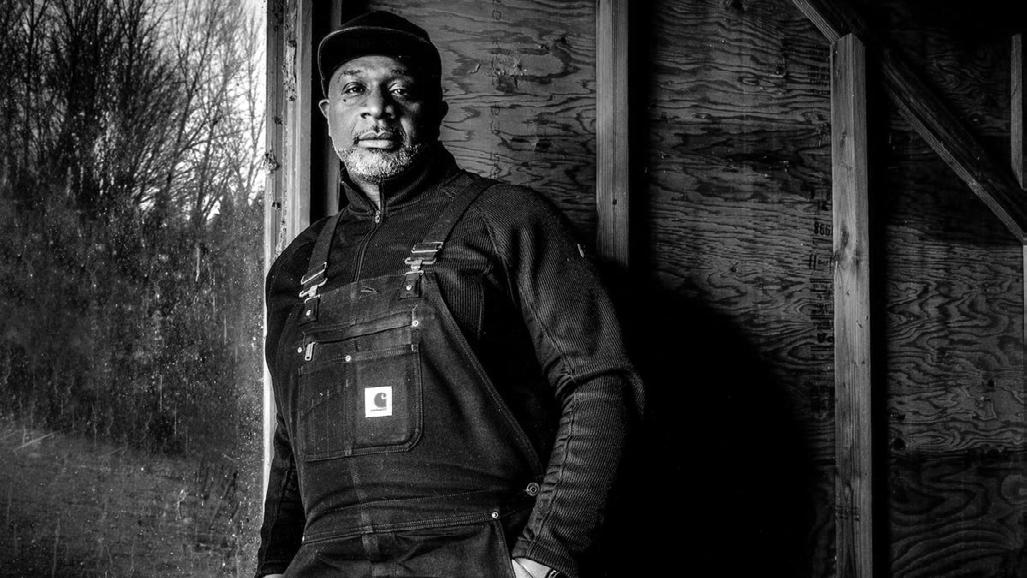 WRITTEN BY: KEVIN JAMES JEFFERY
P HOTO CREDIT: @ABBEYCREEKWINE
WRITTEN BY: KEVIN JAMES JEFFERY
P HOTO CREDIT: @ABBEYCREEKWINE
hat began as unused wine grapes in 2007 has now become Abbey Creek Vineyards. Founded, owned, and operated by Oregon’s first Black winemaker, the operation is now a full-fledged winery that’s taking in visitors from the Portland area and wine connoisseurs from throughout the world. This entire project began from an unlikely place. Ready to begin anew after the passing of his father, Bertony Faustin, who’s of Haitian descent, completely changed the course of his life after deciding to make wine from the grapes his father-in-law was growing. He was done playing it safe as an anesthesia technician and wanted to do something unique—something his way.
W
TROORA MAGAZINE 116
Bertony Faustin

117 TROORA BLACK HISTORY ISSUE 2023
Because Faustin had no prior knowledge of the wine business and the exclusive club that it was, he sought to create a business that was like no other—one that abided by no rules and didn’t compare to anything else. “I decided, you know what? I’m not going to try to fit in. I’ll just go ahead and take this and make it my own,” he said in Forbes last year.

At “The Crick,” the name Faustin has given Abbey Creek Vineyards, you’ll find all the usual suspects popularly grown west of Portland in the Northern Plains. You got your Chardonnays, your Pinot Gris, and of course, the sought-after Pinot

TROORA MAGAZINE 118
Noir. But if you’re looking for those rare finds that make Faustin’s products stand out from the pack, check out the #ReadyToDie red blend. This one is inspired by Faustin’s desire to “Wake up each day and move with intention and passion. Absolutely no regrets.”
If those don’t pique your interest and you’re one of those people that wants something to sip while puffing a cigar, you can’t go wrong with the P.O.P.s ruby port. Named after the capital of Haiti, Port-au(of)-Prince, P.O.P.s is a homage to Faustin’s father, who came from the island and worked hard in the U.S. to provide for his family.
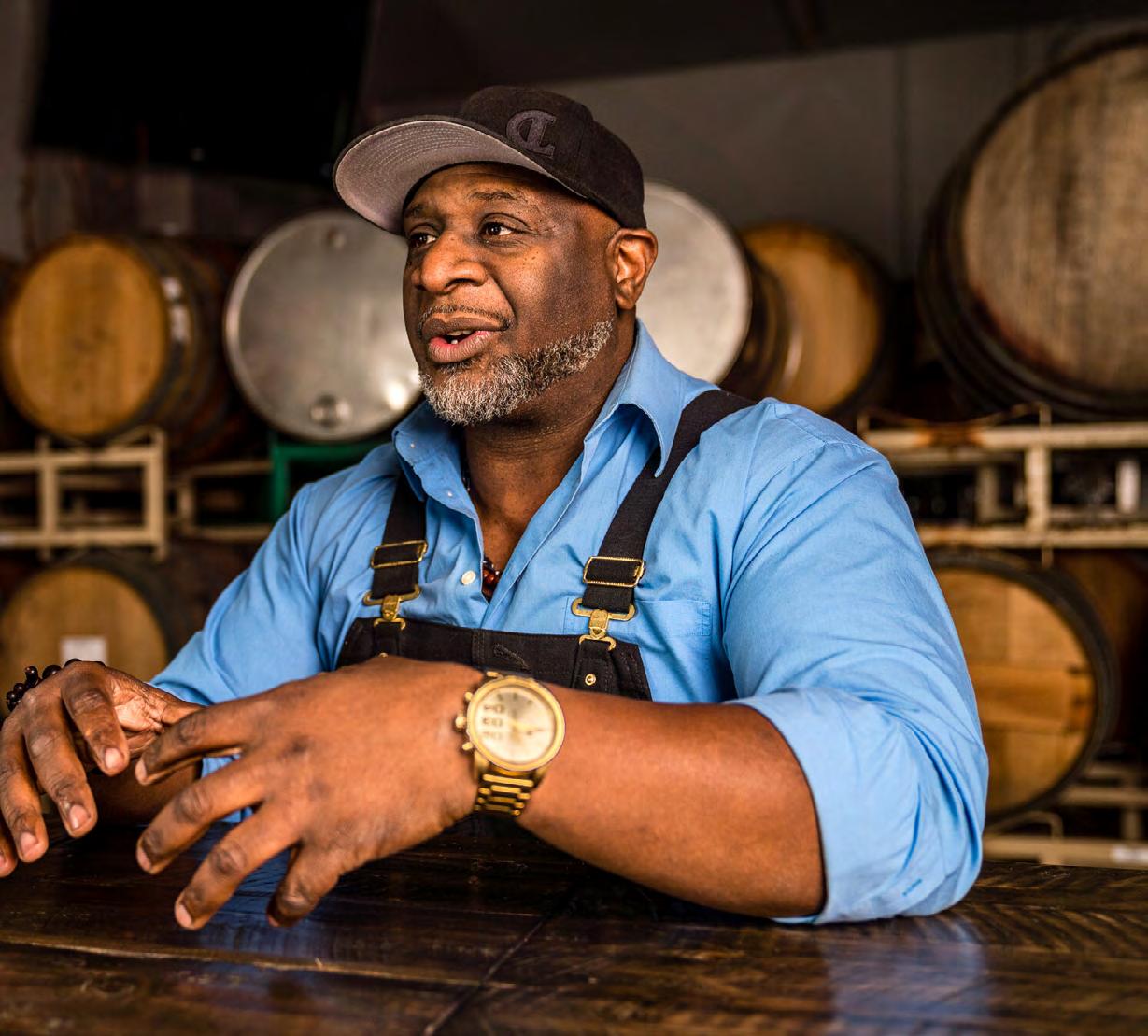
But it’s not just in The Crick’s ruby port that you can find Faustin’s Haitian roots. From the moment you walk
through the doors of the winery, it shows. “From the colors of the Abbey Creek logo being red and blue to represent the Haitian flag, to the spices and twists we put on each of the dishes we serve,” he mentions in his description of P.O.P.s.
If you’re coming from Portland, known as the world’s greatest beer city, and want something to quench that thirst, look no further than Us Against Ourselves. In collaboration with Great Notion Brewing in Portland, The Crick has married Nelson Sauvin hops with their Gamay Noir to create a beer that’s surprisingly light, dry, and fruity. However, it does sell out fast, so don’t expect it to always be in stock.
119 TROORA BLACK HISTORY ISSUE 2023

When you think about wine culture, the type of music that comes to mind probably doesn’t include hip-hop. Well, throw those preconceived notions aside, because Abbey Creek has fully embraced Faustin’s love of the genre. You’ll find the hip-hop theme sprinkled throughwout the winery and his wines. According to Crickism #108, when he sings, “I’m sorry, Ms. Jackson,” you better respond with “Ooooo, I am for real.” Otherwise, you ain’t friends, according to the winemaker.
If none of the above has convinced you that Faustin is shaking up the wine game, how many winemakers do you know who have filmed their award-winning documentary? His film Red, White, and Black showcases minority winemakers in Oregon and shines the spotlight on their accomplishments. Faustin knows all too well the hurdles and challenges it takes to get noticed in the wine industry. And through his film, he could grab the attention of his viewers and give some of his fellow winemakers the praise they deserve.

Known as The Change Maker, Faustin says, “It’s great that I’m the first, but what’s most important is that I’m not the last.” Since breaking out on the scene, others have joined the Oregon mix, including Donna Stoney of Stoney Wines, Eunice Chiweshe Goldstein with her winery, and André Hueston Mack of Maison Noir Wines. Not only are their wines getting noticed, but winemakers like Faustin are doing it on their terms. “I wanted to build this space as if I was the only one who would ever see it. I built it for me,” he says. It’s his terroir, and you’re all invited to see what he has in store next!

121 TROORA BLACK HISTORY ISSUE 2023

AFFORDABLE LUXURY WINES WITH MINIMAL INTERVENTION
CONSCIOUSLY-MADE CANNED LUXURY WINES FROM AROUND THE WORLD THAT TELL A STORY
archerroose.com


Food From The Soul
H ow Chef Debra VanTrece Transcends Multiple Boundaries
PHOTOGRAPHY BY: MIA YAKEL & JOSH SWINNEY
WRITTEN BY: CARY WONG
Chef Debra VanTrece. That fact may be rather unexpected for those who have seen her lively appearances on various TV programs. It was, however, not the only transformation she had gone through in her life.
 Chef Debra VanTrece
Chef Debra VanTrece
124
“I was a bit of an introvert—which comes as a complete surprise to those who know me now,” says
TROORA MAGAZINE
Born and raised in Kansas City, she worked as a model and a flight attendant. Eventually, she became a culinary student at Atlanta’s Art Institute, graduated as a valedictorian, and settled in the city. There, she started working as an executive chef for a catering company. During the 1996 Olympics, she cooked for the VIPs and opened her first restaurant, Edible Art.
Since then, she has started more ventures, including Twisted Soul, The Catering Company by VanTrece, Oreatha’s, and Serenidad—all as parts of the VanTrece Hospitality Group that she founded. She has also published The Twisted Soul Cookbook and was showcased at the James Beard House, among other honors. From a personal perspective, she also transitioned from being a daughter, a wife, a mother who came out as a lesbian, to coowning businesses with her wife, Lorraine Lane. Through all the changes, the pleasure of gathering individuals to enjoy great food has never changed. “I learned early on that food was something that brought people together, no matter what the occasion,” she says. “My family was not rich or poor, just somewhere in the middle. But we considered ourselves blessed because there was always good food on the table. Not necessarily expensive food–but good food.”

125 TROORA BLACK HISTORY ISSUE 2023
Since she was young, her family created magic on the dinner table from paltry ingredients. The biggest feast was on Thanksgiving when all her family gathered and shared their best dishes. That tradition continued even when she grew up and moved away from home, as she would spend hours on the phone with her mother to discuss their menus and recipes.
Fast forward to current times, Chef VanTrece is still working on menus and recipes—only now they are in the context of a restaurant group. For her, it is an exercise to balance her sensibility and creativity. She follows some basic rules, such as seasonality, ingredient combination, pricing, and considers the needs of those with special diets such as vegans, vegetarians, pescatarians, the gluten-free, and others for an inclusive menu. After that, “comes the time for fun. This is when I really get to utilize all my knowledge from living, traveling, and reading to create something a little different but still familiar,” she says. “This is how I put a little of myself and my story in each dish.”
Having been trained in classical French cooking techniques, she could have focused on any cuisine. However, she decided to focus on the dishes at the heart of her upbringing. As she traveled to different places, she also realized that the soul of a country is defined by the soul of its cuisine. With that in mind, she wants to celebrate the food that tells those ageold stories.
“I understand my version of soul food was often going against tradition,” she says. “But I believe traditions were meant to be used as a foundation to build on. And as we evolve, so should our traditions.”
In the beginning, she received strong push-back and faced lots of obstacles, from the assumption that soul food was all that she could make to the idea that soul food or comfort food was simply unimpressive, not to mention the false narrative that soul food was deadly to one’s health. The negative sentiments surrounding comfort cuisine were irrational. In her opinion, it is more challenging technically to make less-heralded ingredients—like hog intestines—taste as good as

TROORA MAGAZINE 126
Serenidad Chef Deborah VanTreces Second Restaurant in Historic Cascade Heights Now Open
expensive ones. She takes pride in being innovative and creative with products that some consider castoffs. Nowadays, with the sustainability movement, more people are jumping onto the bandwagon. At the same time, more chefs are experimenting with soul foods of different cultures and accepting the diversity of good food in general.
Being a Black female chef and a member of the LGBTQ+ community, her experience in the kitchen was a unique one.
“Quite frankly, when I started this journey, I was simply a Black woman, not a lesbian Black woman,” she says. “I found out that my male counterparts were more concerned with what was between my legs instead of my culinary acumen.”
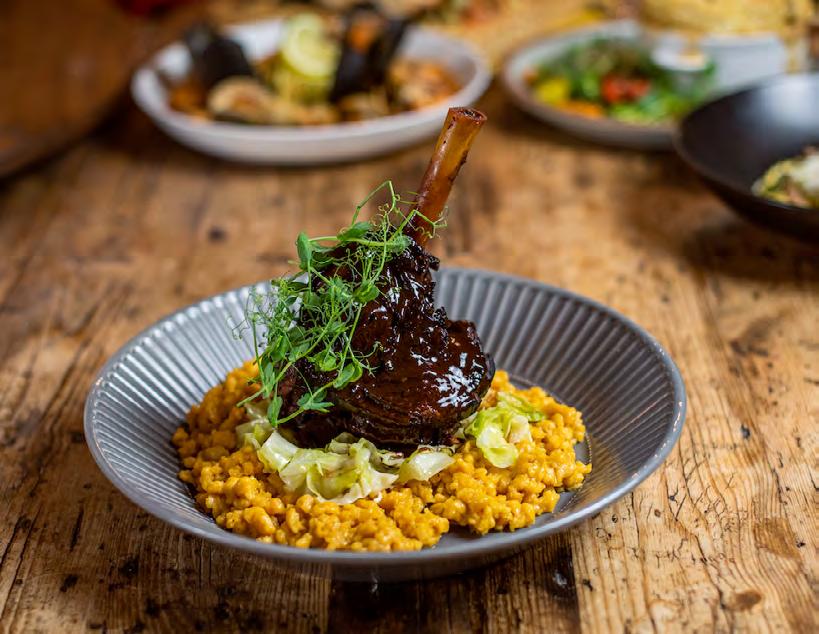
 Paella Grits
Lamb Shank
Paella Grits
Lamb Shank
127
PHOTO CREDIT: JOSH SWINNEY
It was a daily reality for her to deal with rampant sexual innuendos, inappropriate comments, and name-calling. As a Black woman, she was passed up for promotions, talked-down to, and ridiculed for wanting to do “that kind of food.” Once she came out as a lesbian, in addition to losing customers, she was subject to harassment that came in the form of gossip.

She was constantly told that she did not look like a lesbian. “I’m still trying to figure out what a lesbian is supposed to look like and how that plays into my ability to cook,” she says. “I can’t say that these experiences changed my view of the kitchen because I’ve never seen it from any other space... I can only share the perspective from my eyes.” In addition to dealing with the toxic environment in the kitchen, it is also difficult for minorities to access capital. It has always been and continues to be a problem. She does not believe that there is any easy fix. Though it could start with not just listening but truly hearing the cries for equitable opportunities within the system, and
 PHOTO CREDIT: MIA YAKEL
PHOTO CREDIT: JOSH SWINNEY
PHOTO CREDIT: MIA YAKEL
PHOTO CREDIT: JOSH SWINNEY
TROORA MAGAZINE 128
Agua De Vida
asking what we can do to make things better. To Chef VanTrece, marginalized communities are called that for a reason, and it is our responsibility to help find solutions to these real-life issues. There need to be better resources and platforms for true engagement with financiers. Minorities themselves must take the initiative to learn how to establish relationships with banks and know when to cut ties if the relationships are no longer mutually-beneficial. She does think improvements are being made by many organizations to remove barriers, to educate, and to mentor. And even though things are moving in the right direction, there is still a long way to go.
Despite all the obstacles— with neither a roadmap showing her the way nor counselors steering her in the right direction— she does feel she has accomplished a lot. For that reason, she is committed to providing mentorship and helping the next generation.
As far as her business empire goes, the next step is to expand outside of the Atlanta area. The exact locations are yet to be decided, but the process has already begun. In addition, another cookbook is in the making.
When asked about her favorite cuisine, she says she simply loves good food and does not have a strong preference. However, when she feels down, her go-to is always the traditional African American soul food. “Like my mother would make,” she says.

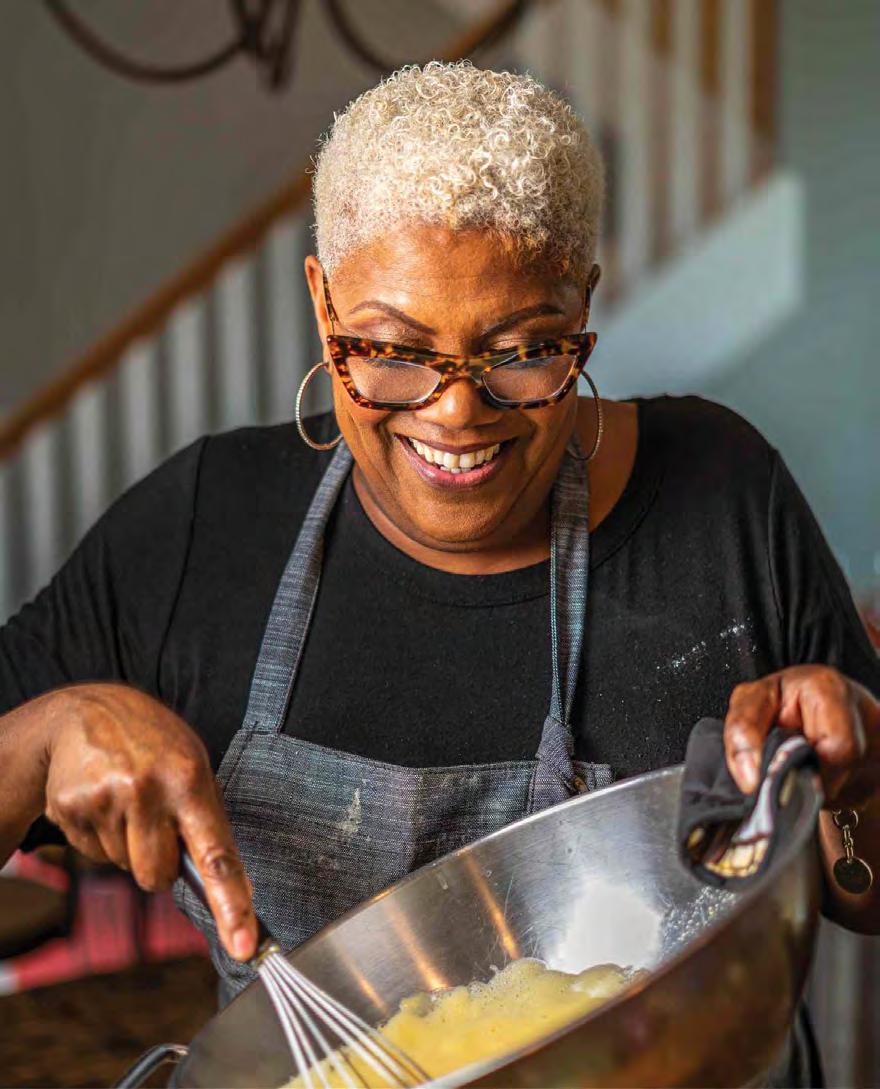
@CHEFDEBORAHVANTRECE @TWISTEDSOULCOOKHOUSE @OREATHASATTHEPOINT @RESTAURANTSERENIDAD
WRITTEN BY: @DIGITALWONG
129 TROORA BLACK HISTORY ISSUE 2023
Duck Pot Pie
Healthy Eating Tasteful, Playful & Beautiful
Certified organic, 100% vegan Real Food Dressings

Carefully selected Blends of premium oils & Ingredients
From artisan producers committed to sustainability
Gluten-free, soy-free, nut-free, dairy-free, no garlic.

farmhouselab.com

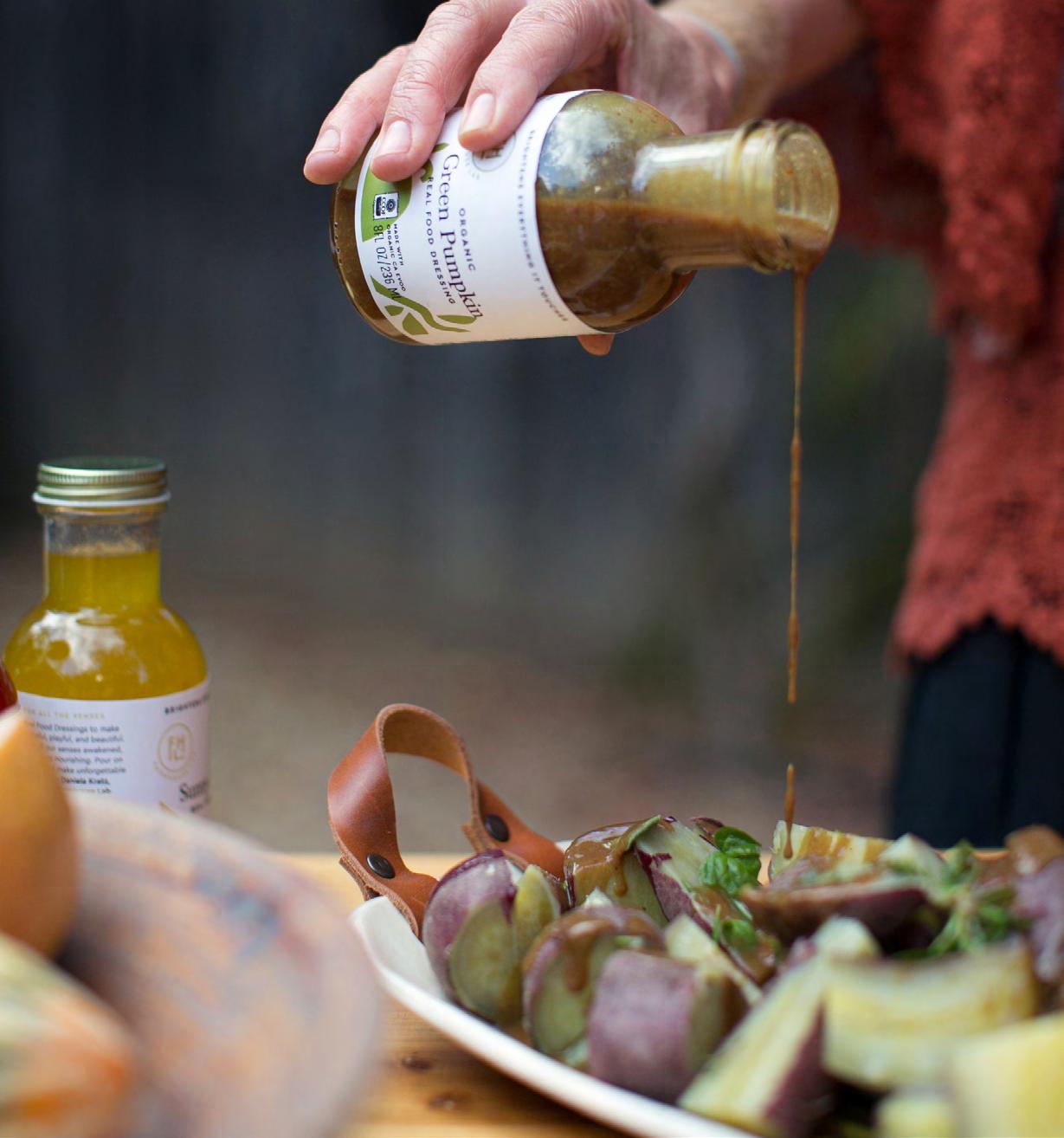

WE PRODUCE ALL OF THE BEERS USED TO MAKE OUR WHISKEYS & ARTISAN SPIRITS

sevenstills.com

Life Is A Circle
Chef Jerome Grant and His Familial Culinary Journey
 WRITTEN BY: CARY WONG
WRITTEN BY: CARY WONG
For some people, it takes a long time to figure out where their talents lie and become stars in their chosen field. For Chef Jerome Grant, however, it seems as if he were destined to walk this path as a culinary master.
Born in the Philippines, he came from a mixed background. His paternal Jamaican grandparents worked in the hospitality industry when they arrived in the United States. His Filipino mother got her start working—and learning English—in fast food restaurants. To add to the mix, his stepfather was stationed at various U.S. Air Force bases. As a result, he had the luxury of living in different places within the United States, like upstate New York, Oklahoma, and Idaho.
TROORA MAGAZINE 134
Chef Jerome Grant

135 TROORA BLACK HISTORY ISSUE 2023
Apple Sambal Roasted Pumpkin
As a child, he hung around the restaurants with his mother and sometimes went to the back to help out, as he enjoyed doing it. He also spent summers with his paternal grandparents in Philadelphia, where he got early exposure to the Caribbean flavors. Last but not least, traveling opened his eyes to different cuisines. He had a taste of everything: from apple pie to Native fried bread, from maple syrup to ethnic foods, and more. It was something that the family emphasized. “My parents and grandparents never really skimped on (food)… we will pay the premium for great food and experience,” he says.
It was not only restaurant food, however, that Chef Grant remembers. Coming from a family of mixed heritage, one of

the things they enjoy is entertaining. As a result, he has lots of fond memories surrounding big feasts. It could have been a child’s birthday, an engagement, or a graduation. Even for something as small as his mother’s mahjong games, food was paramount. “The ladies would play all night,” he recalls. “And that’s how I learned how to cook. I learned how to make rice and shave coconuts,” so he could earn a few dollars to buy GI Joe action figures. In any case, the family table was massive, and it was always full of great food.
After attending the Pennsylvania Culinary Institute in Pittsburgh and working in the Virgin Islands, he returned to the US mainland and began working at a string of rather unusual locales, museums. Specifically the prestigious Smithsonian
TROORA MAGAZINE 136
Roasted Chicken
Institution. One of his first jobs was at the National Museum of the American Indian. It is an important place that presents an underserved cultures, the true native culture of the Americans. He had to showcase different types of products used in different ways. However, there were no recipes or cookbooks available. Everything was passed down verbally. So, the only way to understand that process was to learn firsthand with the tribes. Working with the people, hunting down the items, figuring things out—these were all done through conversations. The journey opened Chef Grant’s eyes to how tight the Natives’ bond was with food.
“I want to learn so much more about the people, their culture, their heritage, where they’re from, why they do
certain things. Why you hold a knife (a certain way) versus me holding a knife (another way),” he says. “Believe it or not, that speaks (volumes) to a chef.”

After that, he worked at the National Museum of African American History and Culture, also part of the Smithsonian Institute. And even though the goals of serving great food to the guests and ensuring they have a great time are the same, cooking at a large institution versus a smaller location requires completely different ways of thinking. A small restaurant may have thirty people on staff—including front and back of the house. In contrast, an institution as big as the Smithsonian could have more than one hundred people on staff. It had multiple venues and satellite locations running simultaneously. Not to mention catering responsibilities and a cafeteria that welcomes 2000-3500 guests daily. It is exponentially more complex.
To Chef Grant, it ultimately comes down to identifying a team who will help drive success. As lucky and blessed as he was to be the “driver” of the entire operation, he needed a great team to achieve the goals. To that end, he always respects those he works with and aims to be a trusted leader who can help others get to where they want to be.
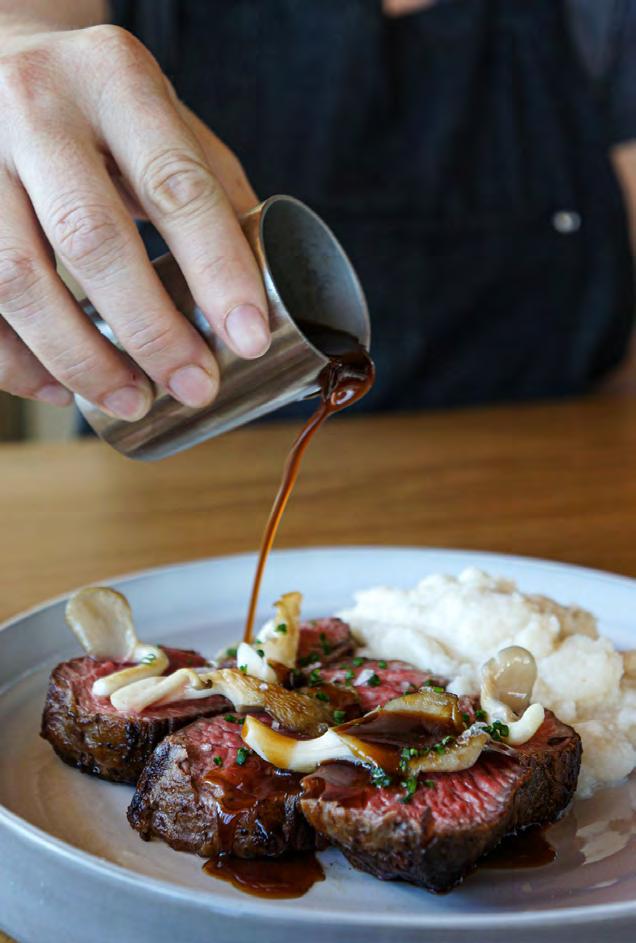
137 TROORA BLACK HISTORY ISSUE 2023
Strip Steak
His experience at the Smithsonian Institute was inspirational in more ways than one. He saw the beautiful interaction between food and culture every day. It also made him stop and realize that he did not know much about himself, his culture, and what he represented. As a result, he went back and started learning more about Caribbean food, African American food, Native American food, and Filipino food. He had to learn what made him who he was. During the pandemic, he started cooking for his family and sitting down for dinner with them every night. And he picked up the hobby of starting fires, learning how to burn wood and various types of coal. It brought him back to open-fire cooking and his roots in Pampanga, Philippines, where many of his uncles often roast entire pigs. It gave him the idea of starting Mahal Open Fire BBQ, which was literally born in the fire.
One of the things he loves to do is to show people the traditions of both sides of his heritage. Going deeper than the well-known and easily-identifiable things like chicken adobo or oxtail and serving lesser-known items such as bikol or festival. Educating others about the differences between Jamaican ginger and those grown in the United States; or how Filipinos grind chicken livers into sauces for added depth of flavor. He wants people to understand and get used to these ideas.
At the beginning of his career, when he first started working at French restaurants, he was always told he should never cook the food he grew up eating. He did not understand it then but eventually realized it was derogatory. It belittled his background and showed how little the workplace knew about him as an individual.

In today’s politically charged environment where the rights of minorities in the kitchen are front-and-center, Chef Grant thinks there
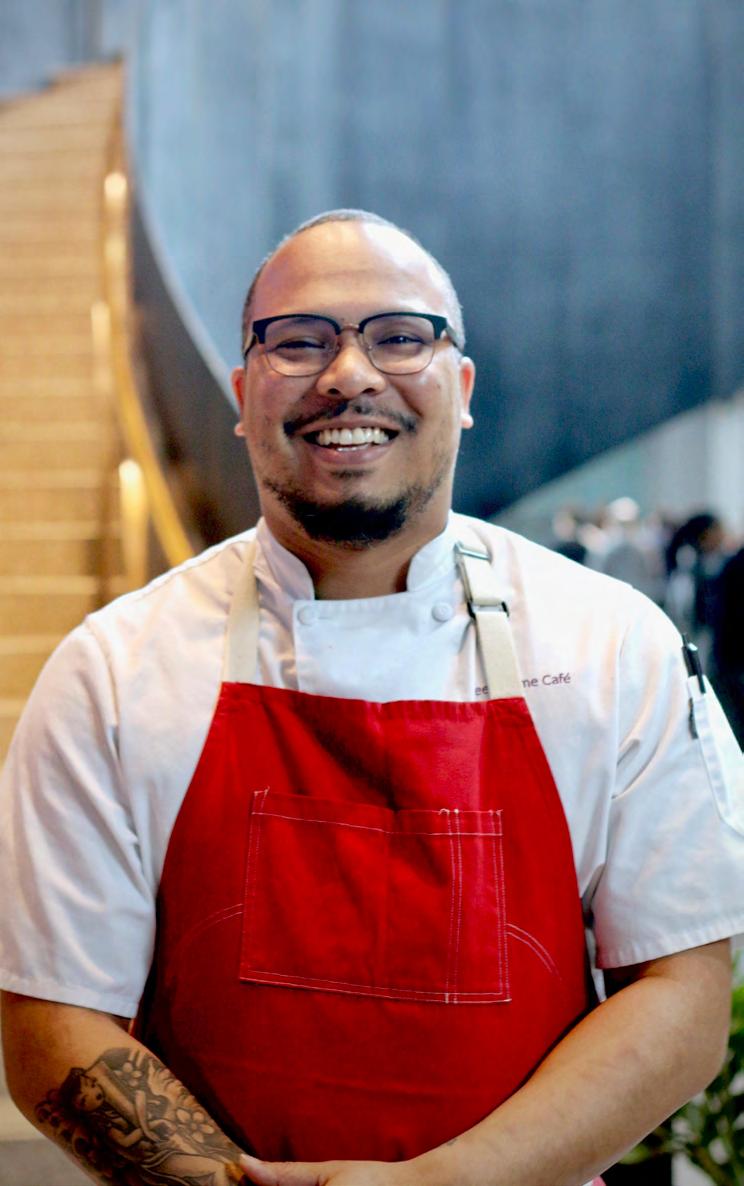
TROORA MAGAZINE 138
needs to be a reasonable understanding of equity amongst cultures and different people. He has seen and heard many things first-hand, like how some people can easily get whatever deal they want or any funding they need. For a racialized person like him, those same opportunities are hard to come by, nor are they publicized.
Furthermore, the days of being seen as a culinary novelty should long be over. We should do away with adding an ethnic restaurant “because the demographic here loves it” or “sprinkling in a token (exotic) eatery.” Instead, we should give people genuine opportunities to help them excel. Everyone should get the proper opportunities and equality that others have.
In his mind, his food is analogous to modern America. His dinner table is an American dinner table. He grew up in a military household with a lushly diverse background. Yes, there is Filipino lumpia, there is dumpling, there is roast turkey, jerk chicken, and all these awesome things on the table, but that represents who Americans are in 2023.
Despite having won his share of awards, such as the 2012 RAMMY for “Best Casual Restaurant” and the 2016 James Beard Award nomination for “Best New Restaurant’,’ he thinks
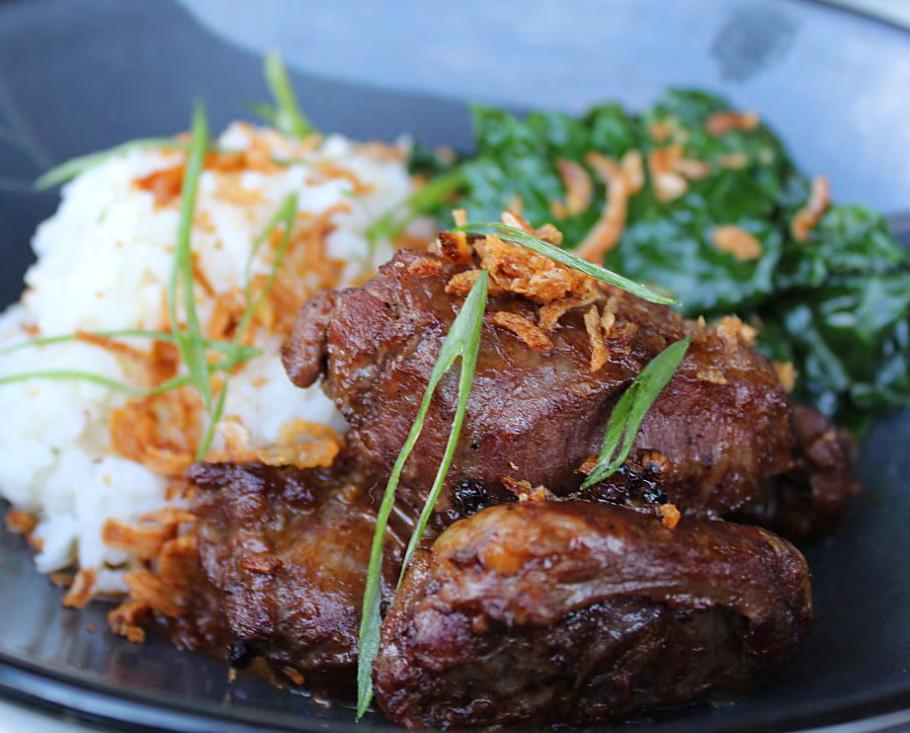
that “the biggest gold star a chef could have” is when a guest can sit back, enjoy the dish, and reveal a glimpse of who they are—“and you take all the other crap and throw it out the window.” To him, a meal is a snapshot of a person’s life. Everyone has bad days and good days. We get married, have children, and all these other wondrous or miserable things. For someone to go back and reminisce about these details, those little gestures, as well as the beautiful dish, they will forever be on the hunt for that. It is not just the steak or the pasta but the experience and the moment they want to relive. They will remember the taste or the aroma of something on the table. And his goal is to create these snapshots in the lives of others. Chef Grant, his wife (whom he half-jokingly says he works for), and his family are now getting ready to open up the first Mahal Open Fire BBQ outlet in Washington, DC. They are pouring everything into it to make sure the build-out is correct, and the operation is in tip-top shape. “Mahal is our family business. Mahal is our family restaurant… I want my kids to work at the restaurant and to have their hands in any area possible,” he says. “(We want to build) something really, really great.”
From the days of Chef Grant hanging out at the fast-food restaurants where his mother used to work at, it seems like life has come full circle.
139 TROORA BLACK HISTORY ISSUE 2023
Pork Cheek Adobo




No... seriously, you’ll drink it and crave it, but don’t worry... we can send it to your home or office monthly, so you’re good! tayst.com



DISCOVER A COFFEE YOU WILL CRAVE


Real Live Willy Wonka!
Chocolatier Philip Ashley Rix
WRITTEN BY: CARY WONG
It was one of those things that was probably so common that it did not stick out at the time, until he opened Phillip Ashley Chocolates. Growing up in Memphis, Tennessee, Chef Phillip Ashley Rix was not only influenced by the city’s rich culture and diverse culinary scene, but he was also exposed to art, music, sports and of course food, thanks to his parents’ support. As a child, he loved hanging out with his grandmother Jean - despite taking him away from his friendswho was a great gardener as well as a skilled chef. He learned how to process what they grew, how to use the kitchen tools and create dishes with love.
Despite always having a sweet tooth, his culinary career only began after his education in chemistry and work in the marketing and sales field. And it literally came from a weird dream in 2007, in which he visited a Godiva chocolate store with his mom. “When I woke up, I knew
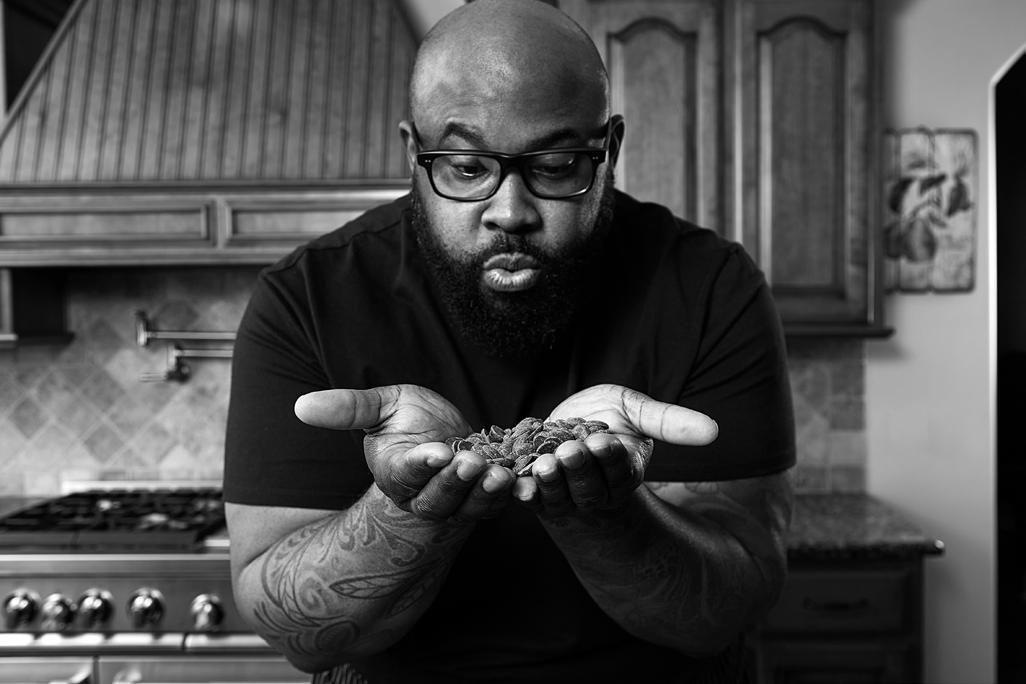
TROORA MAGAZINE 144
that I would make chocolate for the rest of my life,” he says.
Chef Rix started doing research and learned that comfort food - especially sweets - is fairly insulated from tough economic times, as people always want to soothe themselves and a great dessert or confection is often the chosen remedy. After teaching himself how to make chocolates and run a confectionery business, he started to experiment with different flavors and combinations.
Ingredients that do not appear to be a good match, like blue cheese and white chocolate, would often find themselves paired together in his work. These ideas often come from his keen sense of observation. “I am always looking, listening, smelling, and tasting, so I can learn and discover what is out there in the world that I can translate into chocolate,” he says. “The way different cultures eat and live often gives him the next vision.
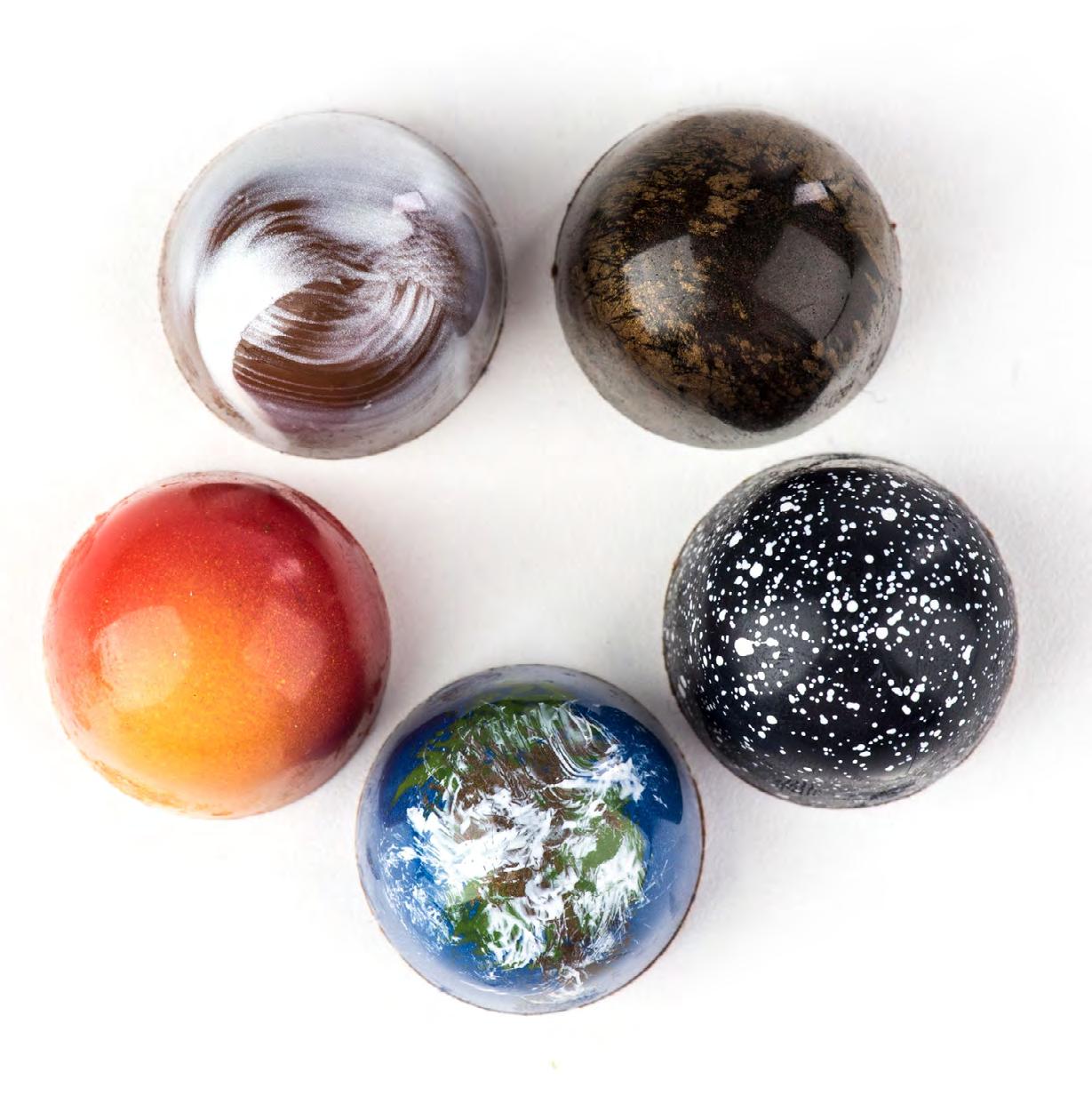
145 TROORA BLACK HISTORY ISSUE 2023
He says his travels have played a major role in his works because the world is filled with nuance and traveling allows him to seek out and uncover inspiration through the food, art, and especially the people of a particular place or region.
For example, he created a collection called Taste of America, which consisted of 50-piece red- and white-striped limited-edition boxes of chocolates; each representing a state and its flavor. For example, there was the iconic Peaches and Cream for Georgia. Old Bay was made for Maryland. Virginia had PB&J while Iowa’s Sweet Corn Basil paid homage to the local maize production. That collection was but one of the many steps in his desire to be an encyclopedia of flavor - to understand food, beverage, ingredients, spices, herbs and oils. Knowing their growth, regional impact and all other aspects would allow him to tell expansive stories with chocolate.

It should be clear as he was granted the title “The Real-Life Willy Wonka ‘’ by Forbes, that his inspirations are not limited only from the culinary world. He also loves translating other sensory experiences into edible form. An example is his

TROORA MAGAZINE 146
partnership with Cadillac to create a collection for the brand’s first ultra-luxury electric car CELESTIQ; as well as chocolates for the launch events tied to the 2023 Lyriq and Escalade V-Series. They allow his imagination to run wild. He can imagine what a specific car of a luxury brand would taste like and create chocolates that are tailored specifically to that. The value he brings to the table led to these successful partnerships. And for Chef Rix, creating a balance between client expectations and his deliverables is key to building great relationships. He is currently working on numerous objectives at the same time, such as creating a seven course fine dining meal into a chocolate-and-wine-tasting series and playing with the idea of making a chocolate mix-tape that takes inspiration from different musical
genres and artists: what would a Prince song taste like? Or how complex would a chocolate born from a Kendrick Lamar verse be?
On top of those projects, he will go on an eightcity chocolate tasting tour this spring, write his first cookbook while developing new collections and refreshing the brand. To top them all off, he is also a proud new dad - how is that for a list of to-dos!
“I spent a lot of time looking at what the industry and other chocolatiers were doing and I decided I wanted to do the opposite,” he says. He is a relentless taste tester whose inspiration often comes from dreams yet is still trying to find that elusive ultimate creation. In addition to making magic happen in his own kitchen, he also competed on Food Network’s Chopped Sweets TV challenge. It was a nerve-

147 TROORA BLACK HISTORY ISSUE 2023
wracking experience as the results were unknown and the time pressure was constant. With so many ingredients, options and tools available, he confirmed his ability to be agile and nimble in a high-stress environment. He enjoyed the challenge and also learned a lot from it. On the business side, it is often challenging for Black owners to raise capital and get buyins during the early stages. He thinks that it is essential to have a clear vision of their businesses and not wait for the perfect moment to launch. “There’s never a perfect time other than now,” he says. “Just get started, you’re going to make mistakes and that’s okay. Learn from your mistakes, put the right people around you, and make sure that you’re really paying attention to the business side.”
In order to stand out, it is important to do the research, know the industry as well as the customer. With all that said, one has to be nimble enough to know when and how to pivot to enhance your business. “Set goals and then 10 or 20X them,” he says. “Most importantly, your product or service has to be impeccable.”
Speaking for himself, Chef Rix thinks that his past marketing and sales experience was the edge that helped him thrive early on. In his mind, it is imperative to spend the money on marketing. To be successful, this is one area that cannot be skimped on. All aspects of the business – whether it is production, creative, strategy or tactical - have to tell a cohesive story to the public to truly succeed in today’s competitive environment. He reminds us, however, the most important aspect for any business is to have a great product or service that people would want. It is the most crucial part of starting up a new business.
“At the end of the day, the product or service has to be great. And then it’s about finding the right people who can support it, sell it, and scale it. Before going to market, make sure that the product is excellent and it’s the best version at that time,” he says.
Phillip Ashley Chocolates is one-of-a-kind and could not be compared to any other product on the market.
“That’s been my whole goal: to create things that no one else would have thought of, that no one else would have dared to put into chocolate.”

TROORA MAGAZINE 148
 @PHILLIPASHLEY @PHILLIPASHLEYCHOCOLATES
@PHILLIPASHLEY @PHILLIPASHLEYCHOCOLATES
149
WRITTEN BY: @DIGITALWONG
THIS IS WHAT FREEDOM TASTES LIKE




kubenicecream.com
Artisanal, Vegan, Full-Fat Coconut Ice Cream
Scan me to Play Video

154
ENRICHING BLACK WOMEN ONE GLOBAL EXPERIENCE AT A TIME MEET DANNY, THE WOMAN BEHIND THE BLACK GIRLS TRAVEL TOO COMMUNITY
BY: KEVIN JEFFERY
162
TIME-TRAVELING THROUGH HISTORY SHOWCASING SOME OF THE MOST MEMORABLE PLACES IN BLACK HISTORY
BY: FILIPA ARAUJO
170
MELANIN ON THE MAP UNIQUELY UNITING PEOPLE OF COLOR THROUGH TRAVEL
 BY: NIZIE LOKMAN
BY: NIZIE LOKMAN
180
JESSICA NABONGO MAKING BLACK HISTORY UNFORGETTABLE
BY: NIZIE LOKMAN
Travel TROORA MAGAZINE 152

153
Enriching Black Women One Global Experience at a Time
Meet Danny, The Woman Behind the Black Girls Travel Too Community
WRITTEN BY: KEVIN JAMES JEFFERY
Named the 2022 Best Black Travel Group by Travel Noire, Black Girls Travel Too (BGTT) aims to show Black girls that they are deserving of a jet-setting lifestyle and pages of passport stamps. What began as an Instagram passion project by travel lover Danielle (aka Danny) Rivers- Mitchell is now a fastgrowing business that caters to young women of color.
Danny’s love for travel and commitment to helping other women of color see the world started in Mobile, Alabama. With many underserved and overlooked communities throughout the port city, not many people from Mobile have aspirations to stray off the beaten path. But for Danny, all it took was a single field trip to Washington, DC with her peers to catch the travel bug. She recalled that it was like going to London for a Black, marginalized youth from Mobile, AL.

TROORA MAGAZINE 154
Danny Rivers Mitchell
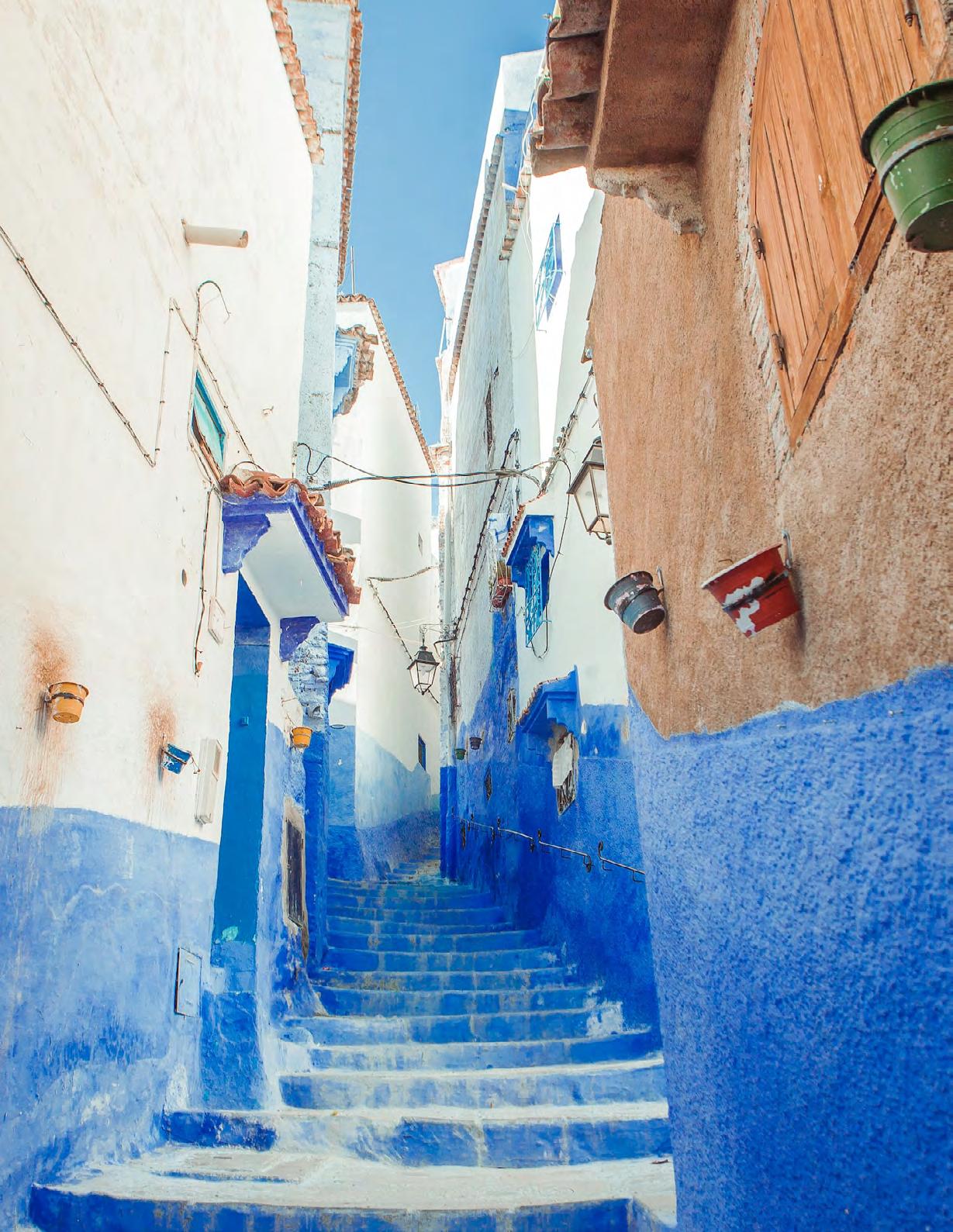
155
From then on, Danny understood the power of travel and the effect it can have on changing perspectives and revealing a new purpose in life. After that seed was planted early on in life, Danny went on to have a family and become a corporate career woman, but she never forgot the power of travel and eventually started Black Girls Travel Too. Since then, thousands of young girls of color have gotten to explore faraway places, and you can see all those happy faces on the BGTT Instagram account, which has over 132,000 followers.
While trips to South Africa, Barbados, and Thailand have been the main attractions for Black Girls Travel Too customers, there are many more destinations in the works. This year, the community is planning trips to India, Australia, London, Paris, Spain, Ghana, and Bermuda. Existing trips take around 10 days with travel days included. Those interested can sign up or join the waiting list on the company’s website.

More Black women travel communities have emerged in recent years due to higher demand. For many women of color, the opportunity to expand their horizons and see the world is enticing but intimidating. There are often hesitations regarding potential dangers and stories about terrible things that happened to people. While those misfortunes are usually rare, a lot of young women of color would prefer traveling with a group to ensure everything goes smoothly and to plan.

TROORA MAGAZINE 156
The best benefit of traveling with a group is the opportunity to make new friends along the journey. When traveling alone, it can be intimidating to walk up to a stranger and start a conversation. Oftentimes it requires extra effort and signing up for group activities to get to know people and eventually exchange contact information. With Black Girls Travel Too, all that extra effort is taken care of. For the inexperienced adventurer, this can relieve some of the anxiety of planning a trip. Especially when young unpractised travelers are so far from home, every bit of planning can be overwhelming. From booking accommodations to exchanging money, bargaining for taxi prices, and planning day outings, it can no longer feel like a relaxing getaway. When young women book a trip with BGTT, each day is planned to the tee, from the day of arrival to the day of departure. The only part of the trip that needs to be booked is the international flight.



157 TROORA BLACK HISTORY ISSUE 2023

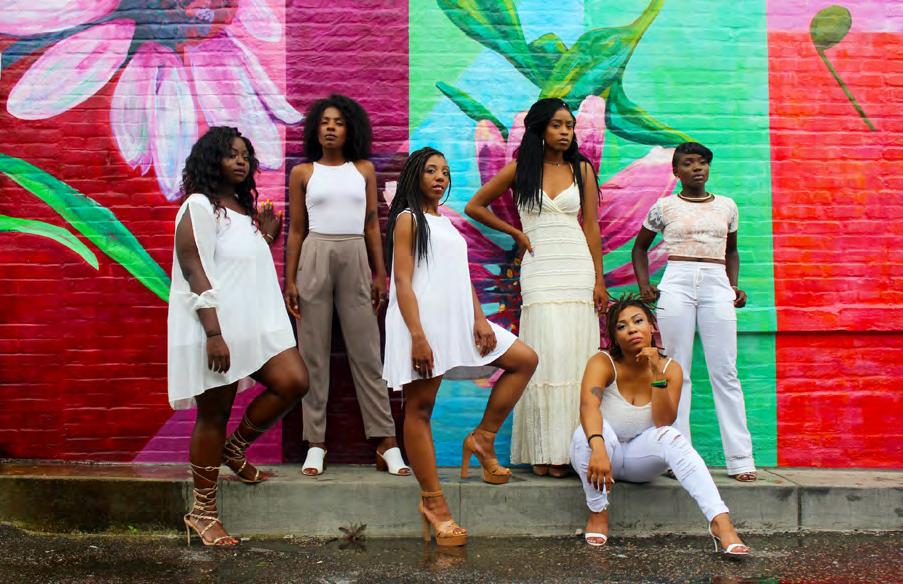
TROORA MAGAZINE 158
The company’s South African 12-day tour, for example, includes accommodation, breakfast every day, some lunches and dinners, walking tours, a safari, domestic flights, a Zulu language class, private transportation, and much more. All of these activities are done as a group, and customers can sleep in shared or private rooms (limited availability). That means there is a great deal of time to connect with fellow travelers and create everlasting memories.

As someone who has traveled the world and made friends along the way, I’m obliged to say those adventure buddies are some of the best friends I still keep in contact with. It’s one thing
to see new places, cultures, and try new foods and hear new languages alone. It’s an entirely different experience to share those once-in-alifetime occurrences with people you’ve bonded with, especially when you are both experiencing it together for the first time.
What’s advantageous about booking a trip with a community like Black Girls Travel Too is that first-time international travelers can see firsthand how to see a new place. They can learn how to navigate a developing country and use that knowledge for future trips. Even more, young women of color will gain confidence knowing they have what it takes to explore a place they’re unfamiliar with. When people travel, they will inevitably have to overcome hurdles; each time a challenge is overcome, more self-assurance is gained. That’s what happened to Danny, and that’s why she’s in a new chapter of her life.
Over the years, Danny traveled to many places and met many people. But nowadays, if you were to catch up with her, you would find her volunteering abroad or at home. She calls it “voluntourism,” a chance to go on a working holiday and give time towards a worthy cause. Right now, BGTT is seeking opportunities to help disadvantaged communities that speak to the heart of who they are.
That’s what Danny does during her free time. But during the day, she’s building her empire and helping young women of color broaden their horizons through travel. Why? Because Black Girls Travel Too!

INSTAGRAM.COM/BLACKGIRLSTRAVELTOO
PHOTO CREDIT: BLACK GIRLS TRAVEL TOO, DANNY RIVERS, JAKOB OWENS ON UNSPLASH, PHOTO BY DAVID CLODE ON UNSPLASH, GODISABLE JACOB ON PEXELS, CLARKE SANDERS UNSPLASH, ATIKH BANA UNSPLASH, JAANUS JAGOMAGI UNSPLASH, MOHAMMED MASAAU UNSPLASH, JASON HAFSO UNSPLASH.
159 TROORA BLACK HISTORY ISSUE 2023
FRESH CRAFT COCKTAILS
drnxmyth.com



Time-Traveling Through History
WRITTEN BY: FILIPA ARAÚJO
The history of Black America is full of unforgettable moments and iconic places. Some remind us of the sacrifices and the struggles that generations endured. Some remind us of the bright, joyful moments that made the darkness easier. Some remind us of the resilience and strength it took to make changes and start a revolution. And some places… well, some places simply put a smile on our faces when we daydream about cultural masterpieces born from all these moments in history.

TROORA MAGAZINE 162
JOIN US AS WE EMBARK ON A JOURNEY THROUGH AFRICAN AMERICAN HISTORY, SHOWCASING SOME OF THE MOST MEMORABLE PLACES IN BLACK HISTORY.
BEALE STREET, MEMPHIS

The first stop on our journey is none other than the home of the Blues, Beale Street in Memphis. If Beale Street could talk, it would have us all sitting around in a cozy little bar downtown, with an exclusive Muddy Waters vinyl playing in the background, while we listen to the many stories that have taken place here throughout the years, all packed together in one street.
Beale Street was established in 1841, right before the civil rights movement took off. With a history of ups and downs, the neighborhood started as a promising place for Black business and culture. But when yellow fever struck in the 1870s, it took a big chunk of Memphis’ population. Later on, in the midst of the civil rights movement, Robert Church was one of the most important entrepreneurs that helped bring Memphis back to life. As his contributions to the community and his investments grew, so did the Black-owned businesses on Beale Street. Beale Street quickly became the hot spot for shopping, art, culture, and entertainment, gathering musicians from across the country to play on the street and the center stage of Robert R. Church Park. This was also an actively political area, where former slaves congregated, where headquarters of anti-segregation newspapers made home, where people fought for their rights, and where the sanitation workers’ strike took place in 1968.
Today, Beale Street continues to be a hub for art and culture and a historical gem of Black history. When you walk down Beale Street today, you can still feel the energy of those who came before, whose blood, sweat, and tears helped build.


163 TROORA BLACK HISTORY ISSUE 2023
Beale Street, early 1900s Beale Street, 2022
AMERICAN BEACH, JACKSONVILLE, FLORIDA


In times when nature was a privilege and beaches were racially segregated, this land in Florida was an oasis for many African Americans in the south. The American Beach was established in 1935 by the Afro-American Life Insurance Company (AALIC). They acquired a piece of land to build a beach resort and create a community that could provide a safe space for African Americans at the time, in an area where all the beaches and resorts around it had signs that screamed: “for whites only.” An oceanfront resort that was a “place for recreation and relaxation without humiliation” was how the founder, Abraham Lincoln Lewis, liked to describe American Beach. For nearly 30 years, the American Beach prospered, bringing thousands of African Americans from all over to enjoy high-quality entertainment and experience the beauty of summer by the shore. Sadly, large areas of the island were destroyed in the hurricane of 1964, and many homes and small businesses never recovered. This quaint seaside town in Florida has been gaining interest again in recent years, and a museum called “The American Beach Museum” was founded in 2014 to preserve this piece of golden sand history.
 American Beach, 2021
American Beach, 2021
TROORA MAGAZINE 164
American Beach, 1937
WOOLWORTH ON 5TH, NASHVILLE
Another historical site that has played a significant role in Black history is this eatery in Nashville. It was the center stage of the lunch counter sit-ins that took place during the civil rights movement in the 1960s. One of the first “five and dime” stores in Nashville, Woolworth included a lunch counter where Black people were forbidden to eat. A group of college students, among them John Lewis, decided to challenge the status quo by simply sitting down at lunch counters like Woolworth and refusing to leave. Little did they know that their action was a vital piece in the revolution and sparked the desegregation process at downtown lunch counters in Nashville and other places in the south.

Fast-forward to the present day, this building has transformed into the “Woolworth Theater” and recently opened its doors, preserving the historical entrance, of course, and allowing you to sit back, enjoy the show, and breathe in a little history.

 Woolworth Theater, 2022
Woolworth Theater, 2022
165
Woolworth on 5th, 1960
BRONZEVILLE, CHICAGO
Bronzeville was once one of the liveliest business neighborhoods in Chicago and home to many influential people and important landmarks. A self-defined community that defied all odds, with thriving enterprises like the infamous Regal Theater, the Overton Hygienic Company, and the Chicago Bee newspaper. A “cultural powerhouse,” as it is often called, Bronzeville allowed the expansion of the economy and living standards of many African Americans that moved here in search of a better life during the Great Migration in the early 1900s.
Nowadays, you can tour the classic buildings around the neighborhood that have been restored and repurposed and watch Bronzeville as it flourishes again with the recent expansion of new housing developments, restaurants, and Blackowned businesses in the hopes of revitalizing this heritage gem.


 Bronzeville, 1940s
Bronzeville, 1940s
TROORA MAGAZINE 166
Bronzeville, 2022
CARTER G. WOODSON NATIONAL HISTORIC SITE, WASHINGTON DC

And, of course, we can’t speak about Black Heritage without speaking of Dr. Carter G. Woodson. Nationally recognized as the “Father of Black History,” Woodson made some important contributions to the country. He educated people on the role of African Americans in history during a time when African Americans did not exist in the history books. In 1915, he founded the now called “Association for the Study of African-American Life and History,” which proved fundamental for what we know today of African American history. He launched multiple publications that featured Black scholars, preserved historical artifacts, and documented discoveries, as well as establishing the first celebration of African American history in 1926, the “Negro History Week”. Inspired by the birthdays of both Frederick Douglass and Abraham Lincoln, this celebration during the second week of February transformed into what is today Black History month.
The beautiful Victorian house where Woodson lived and ran his association is now a declared National Historic Site that people can visit and learn about the role of Woodson in our history. Woodson’s mission, which started over a century ago, continues to inspire and educate generations to this day.

@FINDING_FILIPA 167 TROORA BLACK HISTORY ISSUE 2023
Carter G. Woodson National Historic Site, 2017

icelandicglacial.com




The Purest Tasting Water on EarthTM
Melanin on the Map
Uniquely Uniting People of Color Through Travel

PHOTOGRAPHED BY: @MELANINONTHEMAP, @ASHLEY_MILANI, @_JOSH_BX, @CHAVI.ALLIE, @AFLAVIANTRINDADE, @JETANDREED
WRITTEN BY: CRISTINA DEPTULA
shley McDonough, a 25-year-old entrepreneur and visionary, made history in the travel industry for the global Black community. She not only built a global community for travelers of all backgrounds but created the world’s first app, Melanin on the Map, dedicated to connecting people of color. It also provides a platform for travel professionals to build their own businesses as an income generation stream. TrooRa Magazine, intrigued by this new venture, shares Ashley’s story.

A
TROORA MAGAZINE 170
Ashley McDonough
SEEING THE WORLD THROUGH A DIFFERENT LENS

Ashley, born and raised in Queens, New York, has been traveling since she was a child. She was exposed to travel early when she ventured to the Caribbean to visit family members with her parents. She believes that seeing the world herself allows her to see the truth in real-time.
Her passion for travel kept growing while she was studying at Howard University in Washington D.C., and traveling apart from school. She had the opportunity to study abroad in Spain as a college sophomore and continued her journey into Italy, Morocco, and London. By 25, she had already visited 10 different countries. Her never-ending footsteps throughout America, Europe, and the rest of the world opened up more real connections. She loved that she got to explore the diversity of new experiences, new cultures, new languages, and more. Travel became part of her life, and she wanted to share that with others.
While on her many travels, she noticed that she could count on one hand the number of Black travelers that she encountered, and they were all from her school. This was also the case in other destinations that she visited. From that moment, she knew that creating a platform for Black travelers was something that she would eventually do.
She wanted to help Black people traveling abroad see that they were not alone and that others shared that passion. When Black travelers connected with each other, they would be able to share tips and insights for making travel interesting, safe, and workable.
171
FROM FEELING OVERWHELMED TO BEING TRAVEL OBSESSED



Then, the global pandemic happened and made traveling impossible. The whole world was confined to their homes. Ashley became overwhelmed again.
“I remembered my time being overwhelmed as a former fulltime journalist and producer,” Ashley said. Working around the clock at many sites and locations, she was overwhelmed with many things to do. Travel somehow gave her balance, peace, and solace, connecting with other travelers also journeying to many countries and cities.
Ashley decided to shift the adversity she felt into a golden opportunity for travelers. She knew she needed to find a way to reconnect with people who were isolated at home. Her strong spirituality and connection to God allowed her to turn her noble intention into meaningful action.
She decided to look at the global pandemic as an opportunity to capitalize on travel with technology. Embracing technology with storytelling was the secret sauce, considering she was an expert in storytelling in content creation, and her experience as a journalist and producer in various media in the past helped her make a mark in the hearts of many. Her mission to reconnect with humanity during the difficult economic times Covid-19 had created turned her intention into action. For the longest time, she dreamed of being more and doing more for people of color. She wanted to build a community to share their voices and stories. So, while confined at home, she finally fulfilled her lifelong dream, her app to connect Black travelers.
TROORA MAGAZINE 172



173
BUILDING A COMMUNITY WHO BELONGS
Ashley conceived her idea on July 1, 2019, one month before her 25th birthday. Then, amid Covid, Ashley launched the first ever global travel app for the Black community, Melanin on the Map. “While I found that Black travelers contribute significantly to the travel industry, we are often being left out of the conversation.”

“I’m not Black. Can I be part of the travel tribe of Melanin on the Map?”

Ashley explained that she gets this question a lot. The birth of her baby, the travel app, was born to provide inclusion, diversity, and equal opportunity to minority travelers. The initial intention is to start with the Black community and expand to all communities of color.
Ashley emphasized to TrooRa, “No one needs to be alone. This community serves as a safe space for Black and Brown travelers to engage, network, and learn travel income-earning tactics in various sectors of the industry.”
TROORA MAGAZINE 174
OPENING DOORS TO INCOME OPPORTUNITIES FOR TRAVEL PROFESSIONALS

Besides running her own business, Ashley is a Branded Content producer for Essence Magazine, a Black culture publication for news, entertainment, and lifestyle aimed at Black women. She says, “I saw how travel positively impacted me, so I decided to help regular people who love to travel experience it for themselves. How can we monetize travel in the fastest way? By using a technology app that brings together a community with stories from travel professionals and influencers. As a production journalist trained and experienced in the digital world, I understand how social media works in technology. I realized that I could touch people quicker using a platform like this compared to writing a book or hosting a podcast. Coming from my experience in the social media space and with viral content, I utilized all my skills from my career and put them into my business. And it worked.”
Astonishingly, in just a short period, the travel app has greatly impacted the travel space, building an organic travel-loving community of over 49,000 people in under two years. Currently, there are more than 200 travel agents under Melanin on the Map that capitalize on business opportunities beyond booking hotels, flight deals, and vacation packages. In this travel community, professionals learn how to run and launch a lucrative business from influencing to entrepreneurship and more.”
With this amazing community Ashley has built, influencers, professionals, and travelers will find many ways to connect. She addresses those who want to capitalize on their influence on social media while connecting with niche communities such as entrepreneurs who travel, parents, female travelers, male travelers, solo travelers, LGBTQ people, and more.

175 TROORA BLACK HISTORY ISSUE 2023
LAUNCHING TRAVEL BAES/BESTIES FOR TRAVEL CONSUMERS


Besides focusing on travel professionals looking for business opportunities and

TROORA MAGAZINE 176
finding ways to earn a lucrative income stream, Ashley also focuses on Travel Bae & Travel Besties, the travel consumers. Launched in October 2022, travel lovers can explore many exciting deals, trips, tricks, and learn where to go and what to do. “We have speed-dating travel speakers on various topics. It’s all about the real human connection, interacting while having fun.”
Melanin on the Map also provides a membership program, Travel Bae & Bestie Connect. This initiative allows travel lovers a guaranteed opportunity to promote themselves and their brand directly to the 49,000-person audience of Melanin on the Map. Ashley excitedly explained, “Our audience loves to travel and experience themselves. So we want to capitalize on our strength in community building outside social media and build meaningful connections and travel experiences.”
Ashley also mentioned there is flexibility for travelers who want to explore the move from travel consumer to travel professional. “It’s a click of a button on any topic, from brand building, making new friends, as well as traveling as a business. It’s all on the Melanin on the Map app.”

Melanin on The Map connects travel lovers across the globe while showing, not just telling, how to take advantage of income opportunities while traveling. It’s time for everyone to come and explore this app, especially when the holiday season is around the corner.


MELANINONTHEMAP.COM @MELANINONTHEMAP 177 TROORA BLACK HISTORY ISSUE 2023






saltresorts.com
Jessica Nabongo Making Black History Unforgettable
 PHOTOGRAPHED BY: @JESSICANABONGO
WRITTEN BY: CRISTINA DEPTULA
PHOTOGRAPHED BY: @JESSICANABONGO
WRITTEN BY: CRISTINA DEPTULA
Black Resistance & Resilience. The theme of 2023’s Black History Month depicts a powerful remembrance of significant events and people in the history of the African diaspora. Black History is an important month of recognition of the great efforts made by global Black communities. At TrooRa Magazine, we believe it is a great opportunity for people to be aware of the efforts being made and the impact these efforts have around the world. In the spirit of Black History, we will take you through the journey and inspiring story of Jessica Nabongo. Her contribution as the first Black woman to document her travels to each of the world’s countries and making her mark on the global map. Jessica quit her corporate job and moved to Japan to teach English and has been on the move traveling the world since. In October 2019, she completed her goal while making history and gaining global recognition for traveling to all 195 countries and 10 territories. Recently, the 38- year old world traveler recently added the title of author to her resume and released her book titled The Catch Me If You Can: One Woman's Journey to Every Country in the World, published by National Geographic. TrooRa Magazine shares Jessica’s inspiring story and her five best tips and life lessons that are too sweet to keep from our readers and followers
TROORA MAGAZINE 180
Jessica Nabongo
DREAMS DO COME TRUE
Forbes reported, “With 13 months on the clock, Jessica Nabongo has set herself up for a lofty goal: to visit every country in the world. This millennial Black woman who earned her Master’s in Economic Development from the London School of Economics first went abroad when she was four years old and has since lived on four continents in five countries.
Nabongo, a first-generation American of Ugandan descent, is known as someone driven by curiosity and freedom. Traveling to every country in the world was Jessica’s epic challenge that she’d wanted to undertake for at least a decade before she attempted it in 2017. In her interview with CNN Travel, she mentioned she wanted to do it on her 35th birthday. She ended up leaving five months later, the month of her late father’s birthday.
The Ugandan-American travel influencer touched on her experiences traveling as a Black woman in her book memoir, The Catch Me If You Can: One Woman's Journey to Every Country in the World, released June 14, 2022, noting that representation is hugely important.
Jessica was curious to see what it would feel like as a Black woman to travel the globe, considering she would be one of the few Black women on board most flights she took. She learned that it was possible, although not without challenges, and she learned from and enjoyed the experience. And she would like to share wisdom to inspire others.

“I wrote my memoir not to inspire you to travel the world, but to let you know that your biggest dreams are possible,” Jessica mentioned on her Instagram.
Essentially, the valuable lesson we learn from Nabongo’s life and memoir is that we can achieve great things if we do something meaningful that will help us live, learn, and grow in a larger way. Adopt a growth mindset, and understand that the big dream you end up fulfilling may be one you never even considered but discovered along the way. But you’ll never get to that big dream if you do nothing in your life to commit to expanding and experiencing yourself in a new and bigger way.
Ask yourselves, “What am I doing today to get me closer to where I want to be tomorrow?”

181 TROORA BLACK HISTORY ISSUE 2023
SEE THE WORLD YOURSELF & LET GO OF THE FEAR
“We are so used to seeing the world through the lens of white men,” Jessica mentioned in her interview with CNN Travel. She was referring to the uniqueness of everyone’s experiences and how we exist in the world. We may come from the same species, Homo sapiens sapiens, but we all have a unique collection of knowledge, experience, talents, and passions.
She had a beautiful experience traveling to countries fewer travelers visit, including Yemen, Afghanistan, and South Sudan. “There are so many places that people don't think are valuable in terms of tourism where I had an amazing time,” she mentioned in her interview with CNN Travel.


“I never felt afraid. It was a reminder that you should take everything you hear from people with a grain of salt,” said the globetrotter at heart.
Jessica experienced various cultural experiences as a traveler, from visiting the community near the Hazrat Ali Mazar mosque in Afghanistan, crossing a border late at night in Guinea-Bissau, making traditional octopus balls in Japan, and learning to lasso with Black cowboys in Oklahoma.
She found much that fascinated her even in countries not known as tourist destinations and found most places less scary than she’d been led to believe from the news.

“Travel is my heartbeat.”
TROORA MAGAZINE 182
-JESSICA NABONGO
BECOME A CONSCIOUS GLOBAL CITIZEN & SHOW MORE CARE FOR OUR WORLD


According to Global Citizen, it is predicted that by 2050 there will be more plastic in the world’s oceans than fish. Serious action is needed to keep the planet clean and healthy for all life to enjoy. As a member of the world population, each and every person must take action to support the environment.
“It was in Nauru where it really clicked for me that we’ve got to stop using all this plastic. Nauru is the world’s thirdsmallest country in Micronesia. It is tiny—it takes about 45 minutes to ride around the island on a motorbike, and it’s one of the world’s least-visited countries. But there was all this waste underwater. When you go to other countries where the West is sending their waste, you really see the damage all that single-use plastic is taking on waterways, lakes, rivers,” Jessica mentioned in her interview with Adventure.
It was during her visit to Nauru she decided she needed to speak out against the widespread use of plastic.
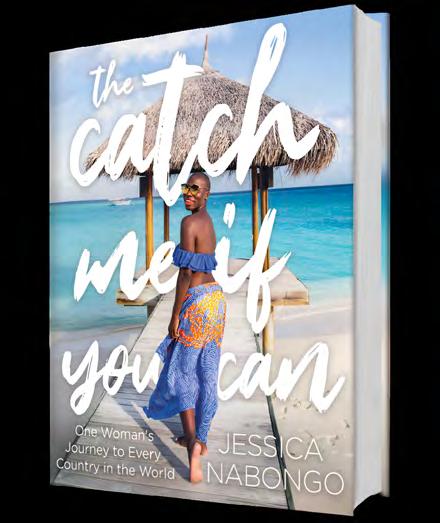
Since then, Jessica has become conscious of sustainability. “I fly with a reusable cup. I don't ever use plastic on airplanes, and I always have my water bottle, and I fill it at the airport before I get on the plane. Little things, like carrying your cup with you, can really help to reduce that waste, which ultimately leads to more sustainability for the planet.”
Jessica explained that curbing the planet’s plastic waste problem is one thing individuals can start working toward, even at home, through small changes in their everyday actions.
183
GIVE HUMANITY A CHANCE WHEREVER YOU GO
In an interview with National Geographic UK, Jessica encourages us to travel with kindness and positive energy and without fear.
“I think what holds people back a lot of the time is fear of the unknown.
What I've learned throughout my travels is that most people are good, and because of that, there's no reason to have an innate fear of a stranger. Most people really want to help you. A lot of the time, people are just really happy that you're in their country.”
“What I'm seeking is humanity. I'm seeking love. So I went anyway.”
Turns out that Jessica had more positive travel moments as a Black traveler than she expected. She mentioned in Forbes that an immigration official in Indonesia asked to take a selfie with her because he thought she was beautiful.


“Those are amazing experiences. There is racism in the world, there just is. That is what history has left us with,” says Nabongo. “But throughout my travels, I am left with the fact that most people are good.”

TROORA MAGAZINE 184
YOUR MENTAL HEALTH MATTERS
Aside from traveling the world, Jessica has faced her toughest life challenge: depression. She mentioned in her interview with Strut in Her Shoes that she felt she didn’t fit in, yet she resolved that being herself and doing what she loved was the key to happiness.
In addition to honoring her truth, Jessica took action to maintain her mental health, such as seeing a therapist.
“That’s incredibly helpful, [and] honestly, it’s about the energy you allow into your life.” Inspired by Marie Kondo, Jessica also makes sure everything in her life brings joy. “My space is always bright because that makes me feel alive. I wear bright colors, drink a lot of water, and try to eat healthy. Everything you’re allowing into your life is going to contribute to your mental health.”
Perspective is a way of seeing. Your way of seeing doesn't change the world, but it shapes your approach to the world in how you want to take action. To sum it up, how you see yourself is how you see the world. See yourself as someone that can shine a light on the world in your own meaningful way.
To read about Jessica Nabongo’s travels in more detail, you can purchase her book The Catch Me If You Can: One Woman's Journey to Every Country in the World, available in Book Shop, Barnes & Noble, Target, and UK Amazon. The audiobook can be found on Audible.

185 TROORA BLACK HISTORY ISSUE 2023




“Someone is sitting in the shade today because someone planted a tree a long time ago.”
— Warren Buffett

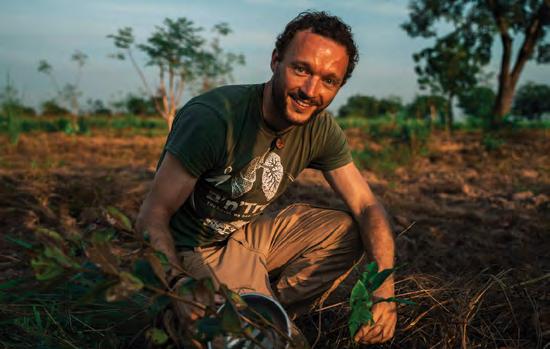



Art, Music & Film
190
INVISIBLE BORDERS IN CONVERSATION WITH EMEKA OKEREKE, WE FIND OUT HOW BORDERS CAN BE CONNECTED THROUGH THE POWER OF ART BY: FILIPA ARAUJO
200
REBUILDING CHICAGO AN INNOVATIVE PROJECT THAT IS REDEFINING HOW WE LOOK AT URBAN SPACES AND REINFORCING THE TRANSFORMATIVE POWER OF ART BY: FILIPA ARAUJO

TROORA MAGAZINE 188

189
Invisible Borders
In Conversation With Emeka Okereke, We Find Out How Borders Can Be Connected Through the Power of Art

Borders are an interesting concept. An invisible line that divides our land. A line that separates us. It defines us, limits us, shapes our cultures, and sets a false notion of self. Emeka Okereke is a multidisciplinary artist who focuses on borders and movement. There are no borders within the mediums that Okereke uses. The artistic director of Invisible Borders uses photography, video, writing, performative intervention, and music to navigate the concepts of movement and the dynamics of society. Okereke’s art is an immersive experience. In conversation, we explored his journey, from art to the road, in every sense of the word.
 PHOTO CREDIT: COURTESY OF INVISIBLE BORDERS TRANS-AFRICAN ORGANISATION
WRITTEN BY: FILIPA ARAÚJO
A moment, a pause. Agbokim Waterfall, Ikom, Nigeria
PHOTO CREDIT: COURTESY OF INVISIBLE BORDERS TRANS-AFRICAN ORGANISATION
WRITTEN BY: FILIPA ARAÚJO
A moment, a pause. Agbokim Waterfall, Ikom, Nigeria
TROORA MAGAZINE 190
Emeka Okereke, Founder and Artistic Director of Invisible Borders


191 TROORA BLACK HISTORY ISSUE 2023
Dilemma of the New Age. Aba, Nigeria Highway. Addis Ababa, Ethiopia
INVISIBLE BORDERS
The Invisible Borders Trans-African Project is an artist-led initiative and a non-profit founded by Okereke.
The Trans-African Road Trip project is the heart of the organization and the core of its missions. A project where a collective of artists, amongst them photographers, videographers, and writers, join together to embark on a journey set in a van that will lead them across the African Continent, to explore, reflect and engage with the environment that surrounds them, and the people they encounter along the way.
The project started in 2009, with the first road trip from Lagos to Bamako, in a black Volkswagen minibus. The use of various mediums is central to the project, as it aims to create a performative experience where the road path guides the project’s path. Okereke believes that the collaboration of mediums allows us to expand them greatly, and he believes that we need more writers to put photography into context, as these two types of art complement each other and allow the work to become performative.
The truth is, if you put a bunch of talented artists in a van, traveling the roads of different countries for a long period of time, you have a recipe for some pretty amazing things. There’s no need to plan a theme as this naturally unfolds. Okereke understood this early on, “I realized that all you have to do is get people on the road first, then everything else will happen. It’s a long body of work that has lasted for over 10 years now, where the theme can simply be what the road offers.”
A simple concept with a powerful message. In his eyes, we are a manifestation of a changing world, a world that calls out for a planetary way of thinking, so for Okereke, the work naturally deals with the idea of movement. The idea of art becoming a bodily experience is a central part of the project, and Okereke embodies his work in a way that the borders between his personal life and his work blend as one. He reflects on the importance of the work developed, “I don’t do this just for the play of it; I really believe that it has the possibility of changing the course
of humanity. It’s not about how we do it or the scale of it; that’s only relative. It’s the consistency, the honesty of it. These things are powerful enough to change the course of humanity. It’s in this light that we look at such a project like the Trans-African Road Trip, knowing that this is a place where artists come, get nurtured, and then they carry this to the atmosphere of action and manifestation.” For each road trip, the team at Invisible Borders promotes an open call for artists, and lets talent find them. This is part of the essence of the organization, amplifying and elevating emerging local talent.
Naturally, there are challenges that come with this type of project, where former strangers spend a lot of time together, sharing a different reality outside of their own contexts. Handling logistics, managing expectations, and dealing with different types of personalities, can be a challenging aspect of the work, but for Okereke, the sets of challenges presented are also what allows the project to be open to different possibilities.

TROORA MAGAZINE 192
Waiting. Rosso (border between Mauritania and Senegal)
We all have a story. Cross-River,
THE JOURNEY THAT STARTED IT ALL
Okereke’s artistic journey started 21 years ago, but in hindsight, it started long before.
His first road trip was, in fact, at a very tender age and fundamental to where he is today. As a young child, he suffered a severe illness, and his mother made the decision to travel across Nigeria to take young Okereke to his grandmother, a powerful healer that saved his life and continued to strengthen his body. He reflects on how meaningful this moment was, “Without this body, there’s nothing. Part of the initial healing has also partly sustained me artistically and as a person.”


He also reflects on his father’s impact on his personal and artistic development.
From a young age, his father instilled the importance of being useful to the people around us and taught him to question the real reasons why we work and what we work toward. From his father, he learned that work could be utilized as a self-manifestation tool.

With these two grand inspirations in his life, art followed naturally. “When I met photography, my dad and grandma had already laid the foundation,” he says.
Another instrumental piece of his artistic development was his desire to conceptualize a world through his eyes. There was a need to move this conceptualization process to materialization, and since he never picked up a paintbrush, photography gave him the tools to complete this process. Naturally curious and able to effortlessly correlate concepts, Okereke soon understood his strength as an artist. “It is not so much outside the box as it is between the boxes. It’s not about inventing grand ideas but rather how you move between spaces. With a sense of multiple identities, you can go forward and backward, and yet, this would still mean moving forward.”
His next journey expanded his sense of self-identity and allowed him a more expansive perspective of Africa since he was no longer looking from within. Studying at the Ecole Nationale Supérieure des Beaux-Arts in Paris provided him with training at an infrastructural level but simultaneously
Between El Gadarif and El Galabat, Sudan
Is it a couple in love, or is it like in Nigeria, a love-hate relationship?
193 TROORA BLACK HISTORY ISSUE 2023
Nigeria-Cameroon border
limited his imagination. There were no references to the artists that he grew up loving and admiring or space to explore the real extent of the history of art.
He reflects on the limitations of western teachings, “There’s a paradox in the sense of knowledge we see in the western world. There’s an apparent abundance of knowledge; museums, schools, libraries, but the approach and the way we digest, engage, and utilize knowledge is limiting.”
There was a deep desire to be part of something big, and Okereke understood that if he wanted to grow as an artist, he needed to get to know himself, step out, and access a whole world of available knowledge back home. This was the moment that prepared him for the journey that would shift the course of his life, the first trans-African road trip.

THE PURPOSE OF ART
Okereke is not a man of catchwords. Achievement is not part of his dictionary, as he aims to manifest.
So, when asked if he hopes to change the narrative around contemporary African art, he tells us that he’d rather focus on the process of creation and movement. Okereke prioritizes creating a space where young artists can absorb knowledge and learn how to stand by their perspective and logic, and then change will happen naturally, “Knowledge comes in many forms and places, but there’s a lot of ignorance attached to it. So the goal is to create a space for artists to redefine and reshape how we connect with the world around us. Change might not happen in my time, but that’s not the point, right? Because we are a manifestation of so many journeys of evolution… and when you think about it that way, it is beautiful that we’re able to do these things. Others will come, and narratives will change.”
Okereke also takes some time to reflect upon the importance of collaboration. He likes to look at collaboration in the broadest sense of the word. Okereke believes that we are in a constant state of collaboration that transcends time and space. We collaborate with our ancestors and the spiritual world; we collaborate with the authors of the books we read and the people that pass through our lives.
He urges us to beware of collaboration out of fear of putting ourselves out there alone and defends that collaboration should come from a place of sharing knowledge and expanding perspectives. “It’s about the uncomfortable moments, the shifts of perspective, the processing of insights, the reaching of new conclusions. It is messy, yet it is the only way of effective collaboration.”
Dream Chamber. Enugu, Nigeria
TROORA MAGAZINE 194
HOW TO SUPPORT THE PROJECT
With Invisible Borders, the goal is to put knowledge out there and make art accessible to everyone, with the intention of people grabbing the project naturally. Art does not belong exclusively in grand places. It belongs in our spaces, our homes, in our minds. It is meant to be shared.
To support the projects of Invisible Borders, you can donate at: invisible-borders.com/donate


@FINDING_FILIPA @INVISIBLEBORDERS
Bus Road
195 TROORA BLACK HISTORY ISSUE 2023
Lugard House Nigeria









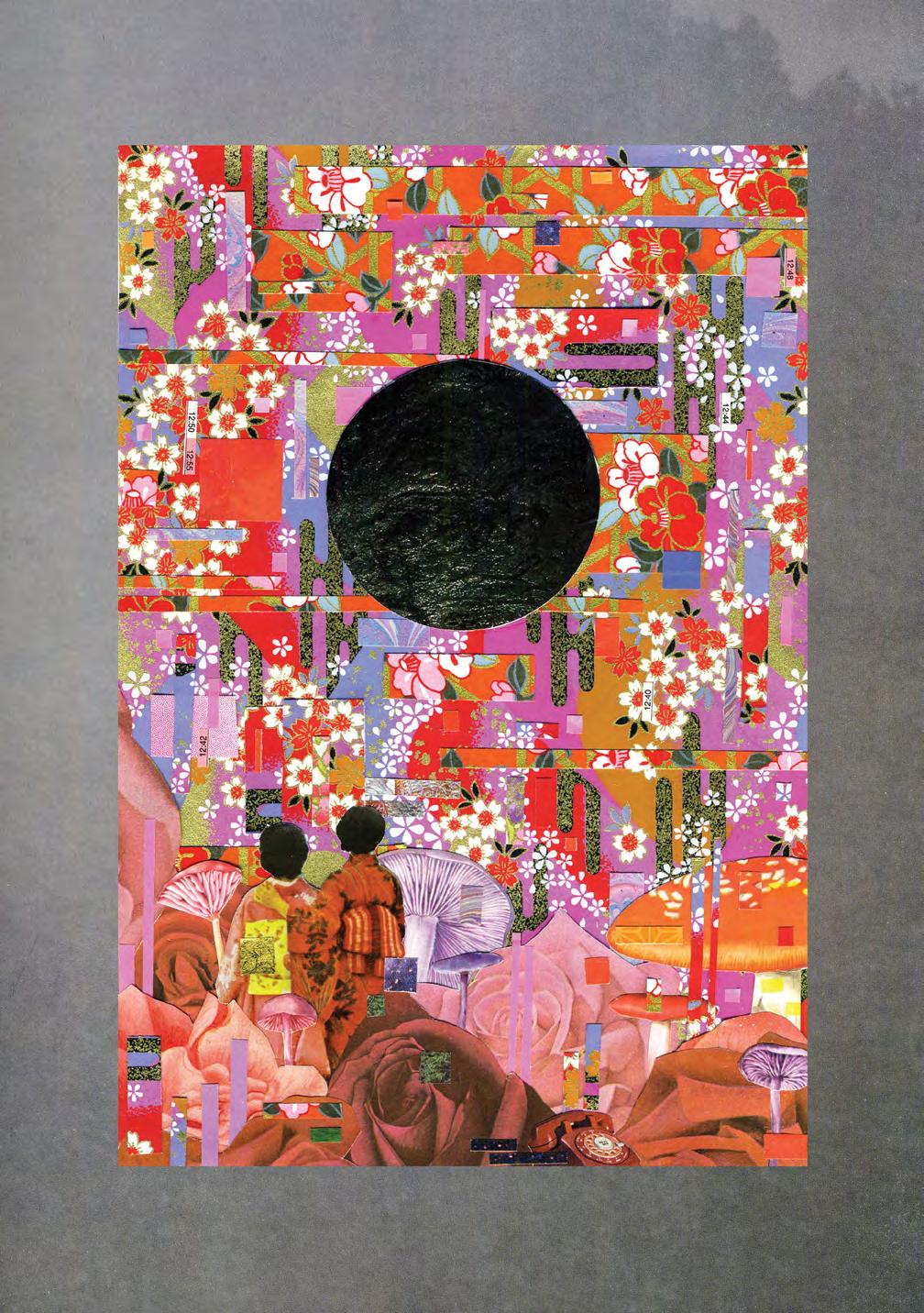
Rebuilding Chicago
An Innovative Project That is Redefining How We Look at Urban Spaces and Reinforcing the Transformative Power of Art
WRITTEN BY: FILIPA ARAÚJO
Rebuild Foundation was founded in 2009 by artist and social innovator Theaster Gates. Founded with the intent to empower communities and support emerging artists, the Rebuild Foundation is a platform for art, cultural development, and neighborhood transformation. The foundation is part of a network of organizations created to uplift the South Side of Chicago. Their vision is based on using art and culture for progress and development.
The foundation empowers the community through different initiatives by providing free art programs, creating new cultural spaces, and developing affordable housing, studios, and work spaces for the community of South Side Chicago. They restore old historical buildings to create new community spaces, blowing life into old forgotten places and inspiring the potential within the community.
THE FACE BEHIND THE FOUNDATION
Theaster Gates is a potter by training and a social activist by vocation. Just like his pottery, Gates enjoys shaping things and the process of turning nothing into something beautiful. His works focus on sculpture, performance, and urban planning and preservation. An international award-winning artist and professor at the University of Chicago in the visual arts department, Gates is a visionary in redefining how we look at urban spaces that serve our communities. The way that Gates blends art & culture with social practice shows us that there are multiple perspectives we can use to look at community engagement and how we connect with art. There’s something quite poetic about reutilizing spaces that are damaged and forgotten by time in hopes of lifting areas that are often damaged and forgotten by society.

TROORA MAGAZINE 200
Theaster Gates, Founder of Rebuild Foundation
STONY ISLAND ARTS BANK

One of the first projects of the Rebuild Foundation was the Stony Islands Arts Bank. An abandoned old bank built in the early 1920s that was restored and repurposed to serve the community of South Side Chicago. A multi-purpose space for art and cultural events, it is used today by local artists and members of the community. It includes an archive collection with a vast variety of media, such as a collection of over 60,000 glass lantern slides covering art and architectural history throughout times and books and publications from the African American Publisher, Johnson Publishing Company, with copies dated since the 1940s. It also includes the personal vinyl collection of Frankie Knuckles, known as the godfather of house music, and the Edward J. Williams Collection, a selection of over 4,000 items of stereotypical images of Black people throughout history. They also host programs like the Arts Bank cinema, a free weekly cinema screening of African American films, and exhibitions from local artists. A place where art, culture, and community meet, promoting engagement between the three parts and allowing residents to access, expand and share their creativity, knowledge, and history.

201 TROORA BLACK HISTORY ISSUE 2023
Stony Island Arts Bank, Chicago
DORCHESTER ART AND HOUSING COLLABORATIVE (DAHC)


Another project of the foundation, in partnership with Brinshore Developers, architects Landon, Bone, Baker, and the Chicago Housing Authority, is based on the idea of creating a living space for locals. In hopes of responding to the continuous abandonment of the neighborhoods in South Side Chicago due to extreme poverty, the project comprised 32 housing units, including a shared space for theater and dance, aimed at
residents that receive low-income housing support in the area. On his website, Gates reflects on the importance of these types of interventions, “As a life practitioner, the possible interventions and engagements are endless. Rather than only intervening with these subjective, museum-based projects, I had to try to do something that had weight in concrete space; black space. While it remains one of the least discussed projects of my practice, DAHC is one of the most relevant and fulfilling for me.”
TROORA MAGAZINE 202
Dorchester Art and Housing Collaborative
EXPERIMENTAL DESIGN LAB


Hoping to impact the fashion and design industry, the Experimental Design Lab project was built in 2021 from a partnership between Prada, the Rebuild Foundation, and Dorchester Industries, a design and manufacturing platform from Gates. The idea with the Experimental Design lab was to support emerging designers of color from Chicago and beyond by expanding their visibility, promoting mentorship and collaboration, as well as building a network of important connections that could potentially support and enhance the works of these artists. From a variety of areas, from fashion to dance, to product design, to culinary arts, the participants of the project were nominated based on their creative potential in their industries. This project is an 18-month fellowship where the participants receive financial and leadership support for their creations.
In an interview with the Chicago Tribute, Gates reinforced the need for projects such as the Experimental Design Lab, “For too long, there has been an evident pipeline and visibility barrier for designers of color working across the creative industries, and the Dorchester Industries Experimental Design Lab not only challenges the notion that Black talent is hard to identify but also serves as an inescapable answer to it. It is a tremendous honor to be able to celebrate, support, and amplify the work of these designers working to enrich our collective understanding of and interactions with design.”
203 TROORA BLACK HISTORY ISSUE 2023
HOW YOU CAN SUPPORT THE FOUNDATION
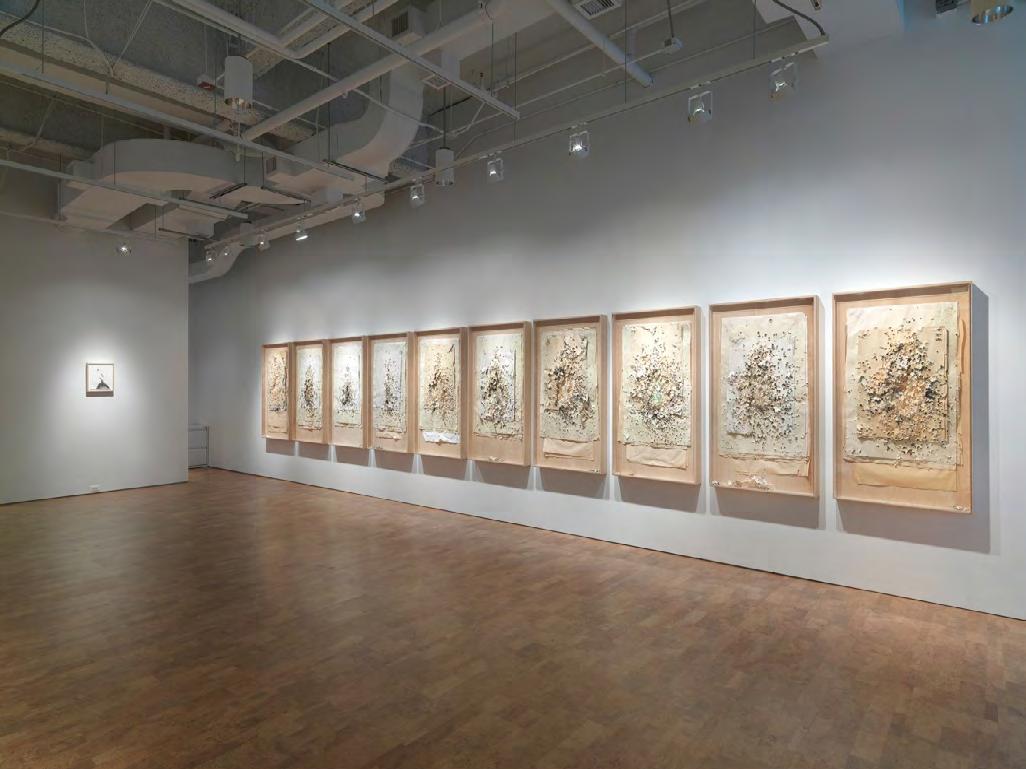
The Rebuild Foundation is currently working on its biggest project so far, the transformation of a former elementary school in Chicago into a new Arts Incubator space. A 40,000 square foot building set to open in 2023 that will include classrooms and co-working spaces and will offer different programs, MasterClasses, feature art exhibitions, and create a multi-purpose space that will allow people to learn new skills and crafts, learn about entrepreneurship and how to create a business.
To support the Rebuild Foundation, you can donate on their website: rebuild-foundation.org/donate and contribute toward initiatives that have a powerful impact on the community, culturally, socially, and economically.

 Installation view of Retreat, The Black Artists Retreat, 2017
Installation view of Retreat, The Black Artists Retreat, 2017
@FINDING_FILIPA @REBUILD_FOUNDATION THEASTERGATES.COM REBUILD-FOUNDATION.ORG TROORA MAGAZINE 204

“Our mission is to demonstrate the impact of innovative, ambitious, and entrepreneurial cultural initiatives and is enriched by three core values: Black people matter, Black spaces matter, and Black objects matter.”
205
-THEASTER GATES
Gift Sets

Wine & Grind Gift Set
Wine with a Catalyst for Change


Crafting

onehopewine.com
unforgettable wine that makes an impact
Vintner Cabernet Sauvignon Minis Gift Set
Vintner Chardonnay Minis Gift Set
Artist Dameon Priestly focuses on times and events of social and cultural change


dameon.co.uk
PHOTOGRAPHED BY MICHAEL DAKS




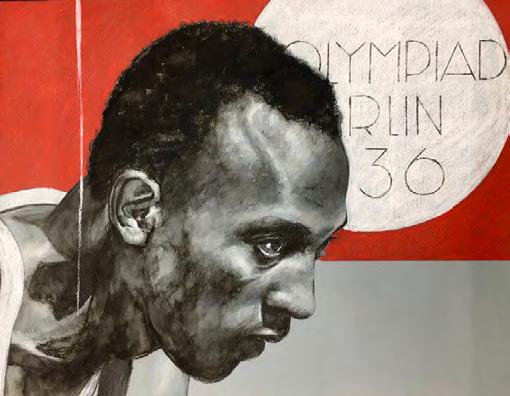

Challenging the Status Quo
 WRITTEN BY: FILIPA ARAÚJO
WRITTEN BY: FILIPA ARAÚJO
TROORA MAGAZINE 210
PHOTO CREDIT: MOHAU MODISAKENG STUDIO

211
An Insider’s Look Into Mohau Modisakeng’s World and All Its Intricacies
Making waves in the international art world is contemporary artist Mohau Modisakeng. Through different channels, including photography, installations, video, and performance, Modisakeng explores the depth of the impact of a post-colonial Africa and how the violent past of South Africa presents itself in today’s society, using symbolism and the black body as a tool to express his messages. Modisakeng aims to restore the collective memory of Africa, specifically South Africa, while challenging us to own our truths, reevaluate our roles in this civilization, and question the narratives imposed by colonialism.
An award-winning artist, Modisakeng has showcased his art in many different countries, from South Africa to the United States, as he continues to expand its reach. His work transcends multiple realities and has the ability to create a connection between different communities around the world by paralleling experiences of displacement, segregation, and oppression that are familiar to so many people across the globe.
GROWING UP IN SOUTH AFRICA
Born in South Africa in 1986, Modisakeng grew up under the Apartheid regime when oppression and violence were the norm for people of color living in South Africa. Originally from Soweto, a township on the outskirts of Johannesburg, Modisakeng’s upbringing played a significant role in his journey through art and life. “We lived in an informal settlement where most of the violence played itself out between neighbors, opposing parties, different ethnicities, blacks, and the white government. I grew up witnessing and being subjected to the social repression of a colonial power that was threatened by a mass revolt.”
From an early age, Modisakeng was intrigued by art and the beautiful intricacies of purely creating. Even before starting school, young Modisakeng was the type of child that would draw on any possible blank space or surface he could find. His parents quickly noticed that he was an artsy kid and provided nourishment to feed his creative soul. He started using pencils and oil pastels and experimenting with the world of art. He reminisces about when his curiosity for art and how different elements can shape and influence it started developing: “I recall a ‘mural’ I drew on a rusted metal sheet that made up part of our house. I used broken pieces of oil pastels to draw on the wall and would notice the various images were changing over the seasons as warmer temperatures would melt the oil pastel marks, making new images.”
As Modisakeng grew, so did his passion for the visual arts. He eventually went on to study fine art at the Michaelis School of Fine Art in Cape Town in 2009, where he also completed his Fine Arts Master Degree in 2014.
 Mohau Modisakeng
Mohau Modisakeng
TROORA MAGAZINE 212

213

TROORA MAGAZINE 214
“As an African person in this society, one is perpetually disconnected from their memory. This is the space I want to operate in, where my contribution would mean working towards restoring lost histories through storytelling modes that in some way unearth and ‘re-membering.”
THE PROCESS OF CREATING
It’s undeniable that Modisakeng’s art is abundant with symbolism. Born from intuition and memories that linger on, Modisakeng’s creations are both provocative and breathtakingly powerful.
His creative process is multilayered, and symbolism plays a significant role in this. Motivated by global contexts and influenced by the spiritual dimension of his culture, Modisakeng’s inspiration often comes from visions or messages that transcend the physical world.
Modisakeng honors the knowledge passed down for generations through rituals and symbols that add depth to his works. “There is a reservoir of knowledge that has been kept and passed on through cultures and traditions that have been in practice for thousands of years on the African continent. In my own experience, this knowledge is channeled through oral history, customs, rituals, and rites of passage. In the space of spirituality, the living commune with ancestral memory through divination and dreams. The language of spirits in the Southern African context derives from the images and network of relations we generate in the subconscious state. Many of my works have departed from visions.”
Modisakeng uses a variety of mediums to express his concepts and visions. Sculpture, photography, film, installations, and performance are some of the mediums he has used to achieve the best vessel to convey his message.
Modisakeng first started exploring with a self-portraiture project that allowed him to play around with a variety of concepts, using his image and, later, photography as a way to visualize other characters and contexts. “Over time, the way I frame subjects extended to include other figures, characters, and people that help to anchor various narratives. But at various points, I explored the use of different mediums, so one could say the practice has been ever evolving as some ideas might demand physical objects in space, cinema, or canvas.” His style continually evolves and shifts, almost guided by where the different creations take him. When asked what drives him toward performance, Modisakeng reflects that performance is sometimes the best vessel to deliver works that touch memory and spirituality. “In some instances, an idea calls for a performance. Where space, object, body, and witnesses conspire to create a particular place in time. The ephemeral and resonant nature of a performance allows one to experiment with time and space to mark moments in powerful ways.”

215
ART AS A TOOL FOR RESTORING MEMORY
It is often said that all art is political. Art and politics have always been intertwined and have had the power to influence and shape each other throughout history. Experiencing life in a country that encapsulates a violent past within a divided and often racially segregated nation grants space for art to be tied to the representation of displacement and injustice.
One thing that drives Modisakeng to create is the ability to use his art as a medium to restore memories and honor (the true) history of South Africa. “Living in South Africa in the ‘post-colonial’ era means that one has to grapple with the legacy of erasure and voicelessness engendered by a long history of dispossession and exploitation.”
To produce art that speaks of restoring erased history is unapologetically political. In his quest to own this truth, an artist has a responsibility to oppose the existent false narratives and help the collective to remember.

“During the height of tensions in South Africa, decisions were taken to avert the threat of a racial war by ushering in the so-called ‘rainbow nation,’ a well-orchestrated myth about a new society where all races would live in harmony. For this notion to work for as long as it has, the
entire population was co-opted to consent and support the myth. As such, most South Africans chose to forgive and, more importantly, forget. This forgetting means that there are large chunks missing from our stories about our country and ourselves, and so then the work of the artist is to search, excavate, restore, in an act of ‘remembering’ not only for oneself but also for the collective. ”
One of his pieces, “Land of Zanj,” is a performance piece that links the collective trauma of displacement caused by the African Diaspora with the racial segregation felt in South Africa during Apartheid. A choreographed performance and procession, named after the island of Zanzibar or Azania, is an ancient term used to describe various parts of southeastern Africa.
When asked about the intent behind works like the “Land of Zanj,” Mohau refers to the importance of restoring lost memories of Black history in the hopes of reclaiming the power of those affected by the destructive past of displacement and oppression. “A work engaging such themes attempts to draw on the many similarities in the experience of black bodies under oppressive regimes throughout history. In all these historic migrations, there are traces of our humanity with stories that have the potential to restore that which for centuries has been misplaced.”
“The symbolism of my work represents the intersection /relationship between the creative process, storytelling, and the resonance of ancestral memory kept alive through ritual.”
TROORA MAGAZINE 216
TRANSCENDING REALITIES AND GENERATIONS
One of the most powerful things about art is the ability to move us humans in different ways but at the same time as a symbiotic collective, independent of who we are or where in the world we are located.
One of the powerful aspects of Modisakeng’s art is the dynamic between the deeply personal side of his visions and the relatability to various communities.
With one piece, is it possible to tap into different realities that share the same concept? For Modisakeng, “The balance between the personal and the collective is often what makes the artwork legible to people that might have lived through the same socio-political challenges.”
Passage 17’ is a work that reflects this perspective clearly. A commissioned work by the South African Department of Arts and Culture for the 57th International Art Exhibition in Venice.
Passage 17’ is a “three-channel projection that meditates on slavery’s dismemberment of African identity and its enduring erasure of personal histories.”

In this work, Modisakeng reflects the reality of African displacement and the gradual consequences of this on one’s body, mind, and soul. A hauntingly beautiful piece of work has the ability to connect to so many different people and remain relevant from distinct perspectives.
This work also happened to fall into the time frame of the height of the refugee crisis. In 2017, thousands of refugees were washing up on the coasts of Europe in overcrowded boats that often sank or capsized. So, from a different perspective, this work can also speak to the reality of forced migration due to a lack of basic resources or safety issues.
217
From yet another perspective, it can also speak to those seeking intentional displacement. The ones who chose to leave their countries and homes, buy a one-way passage and leave life as they know it, often slowly leaving behind the pieces that connected them to their homelands. This displacement of culture and self, whether forcibly, naturally, or intentionally, forms a connection bound by artworks like these that transcend cultural boundaries, realities, and generations.
Modisakeng reflects on the poetic opening of Passage in Venice, “This work premiered at the 57th Venice Biennale in 2017. The screening opened to the public on the 10th of May, which happened to fall on a full moon during an altar lunar where the city of Venice gets overflooded due to heightened tides. So, viewers would enter the immersive installation where they would watch the 18 min film, which revolves around a sinking boat, then spill out into the streets of Venice where the water had risen. I think this experience made the work memorable.”

TROORA MAGAZINE 218
CURRENT PROJECTS
In his latest project, Modisakeng reflects on the hardships that come hand in hand with the spiritual journey of reconnecting with ancestral memory. At the same time, he brings awareness to an issue affecting a sacred site in South Africa. “Madimatle, the title of the exhibition, is borrowed from the name given to a sacred mountain and network of caves in South Africa where African people have, for thousands of years, been making pilgrimages for spiritual and cultural reasons. The mountain has since come under the control of a multinational corporation that threatens to mine the sacred site, thus disturbing its nature.”
Throughout his career, Mohau Modisakeng has continued to wow us with his provocative work. His pieces transport us to a place where we can grieve and honor history while inspiring us to take a long look at some uncomfortable truths. His work is a true testament to powerful political art.


MOHAUMODISAKENGSTUDIO.COM @MOHAUMODISAKENG @FINDING_FILIPA 219

TROORA MAGAZINE 220


Scan me to Play Video 221 TROORA BLACK HISTORY ISSUE 2023

Innovation • Value • Service Apply now at luxurycard.com or call 844.LUX.CARD
Photo by zhou_xian in Unsplash



Luxury Card marks are property of Black Card LLC. BLACKCARD is a registered trademark used under license. Luxury Card products are issued by Barclays Bank Delaware pursuant to a license by Mastercard International Incorporated, owner of registered trademarks MASTERCARD, WORLD ELITE MASTERCARD and the circles design. All trademarks are the property of their respective owners. © 2019–2020 Black Card LLC


KHANUNBYMIMI SHOP CONSCIOUSLY
be the change.
@khanunbymimi facebook.com/khanunbymimi khanunbymimi.com
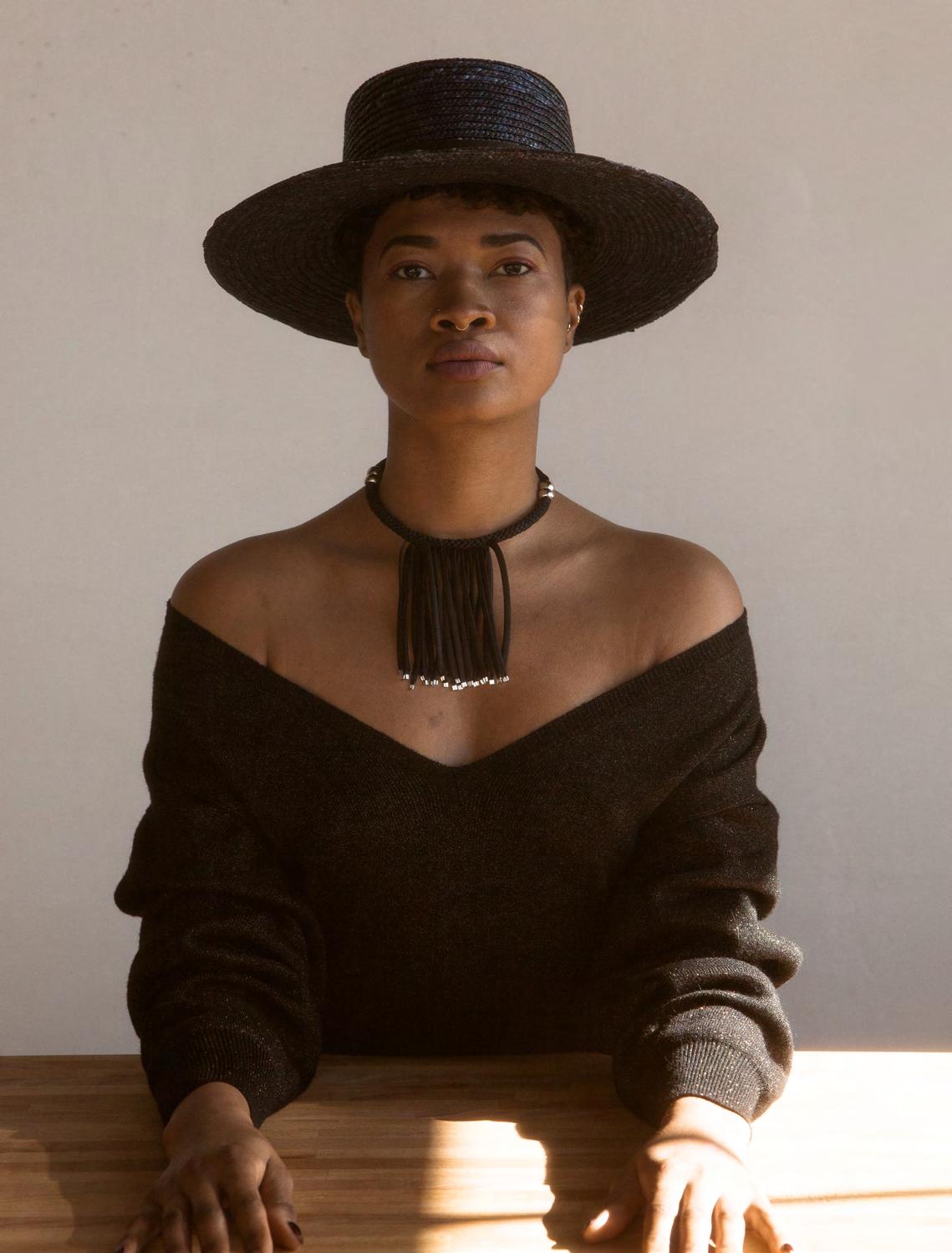

stellafluorescent.com Ig: @stellafluorescent Pinterest: @stellasfsf
Sustainable Materials

Environmental Responsibility

Hand Crafted Jewelry & Accessories


Quality, Design and Functionality. We love creating accessories to be worn year round landabags.com


Fashion & Accessories
232
BLOG TO STREETWEAR THIS COLLECTIVE AIMS TO CHANGE THE PERCEPTION OF AFRICAN CULTURES IN WESTERN SOCIETIES
BY: STELLA POLYZOIDOU
240
FLESH-TONE REQUIRED ERIN CARPENTER IS BREAKING BARRIERS THROUGH NICHE FASHION WITH NUDE BARRE
BY: STELLA POLYZOIDOU
250
MAMI WATA IS THE SPIRIT OF AFRICAN SURF THE FIRST AFRICAN SURF BRAND IS MAKING WAVES THROUGHOUT THE GLOBAL SURF CULTURE
BY: KEVIN JEFFERY
258
WEARABLE MODERN ART FULL OF CREATIVITY, SOPHIA DEMIRTAS HAS TURNED HER PASSION FOR FASHION INTO A LUXURY CLOTHING BRAND BY: STELLA POYZOIDOU
TROORA MAGAZINE 230

231
Blog to Streetwear
This Collective Aims to Change the Perception of African Cultures in Western Societies
PHOTOGRAPHED BY: @EVAROEFS @TOMTEBET @THELIFEOFDANMBO
WRITTEN BY: STELLA POLYZOIDOU
Daily Paper is an African-inspired brand based in Amsterdam, founded in 2010 by three creative minds, Hussein Suleiman, Jefferson Osei, and Abderrahmane Trabsini. Coming from three different African backgrounds, Somalia, Ghana, and Morocco, respectively, all three were raised in the Netherlands as refugee children. Looking always at Africa’s past, present, and future, their primary sources of inspiration have been their roots, nature, technology, music, art, fashion, youth culture, and the street scene in the metropolitan cities. What started as a blog in 2008 soon became an exponentially evolving streetwear empire. Through the blog, the three friends could discuss fashion events, interview prominent people in the streetwear and sneaker industries, share their perspectives about streetwear fashion, host events and exhibitions, and travel around the world. They soon created something tangible for the community to promote the blog and diversify their platform.

TROORA MAGAZINE 232

233 TROORA BLACK HISTORY ISSUE 2023
“Daily Paper is more than a clothing brand; it’s a street movement addressed to the Black community and underrepresented individuals who try to find their voices through fashion.”
They went to American Apparel, printed their logo on a T-shirt, and started selling them to friends and family. It wasn’t until the t-shirts they were selling to family and friends became more popular than the blog that they switched their business model to a clothing brand. Slowly people became more interested in their merch than the blog. After four years, the brand officially released its first collection of five t-shirts—five different designs, 150 pieces each—in 2012, thus putting its name into the fashion map.
As a result, a huge demand for a more extensive collection was created; thus, the team decided to transform their four-yearold blog into a brand. They knew they had to implement their backgrounds in their collections and offer something new to the world to stand out. Each collection combines European and African elements with urban and modern designs. From quilted bomber jackets and tracksuits to oversized tailoring and printed T-shirts and shorts, Daily Paper stays true to its unique brand aesthetic.


On top of its carefully designed collections, the brand has adopted an inspiring and eco-conscious mindset.

TROORA MAGAZINE 234
What drives them the most is the community, their friends, family, and colleagues, and in general, the youth culture inspires them a lot. Loved by fashion celebrities and superstars like J Balvin, Lil Nas X, Jorja Smith, Lil Baby, Issa Rae, and Lupita Nyongo, to name a few, Daily Paper keeps gaining a reputation among crème de la crème.
The brand is also known for top-notch collaborations with Havana club, Puma, the Van Gogh museum, Zenology, Surf Ghana, Virgil Abloh, and Alpha Industries, expanding into every market.


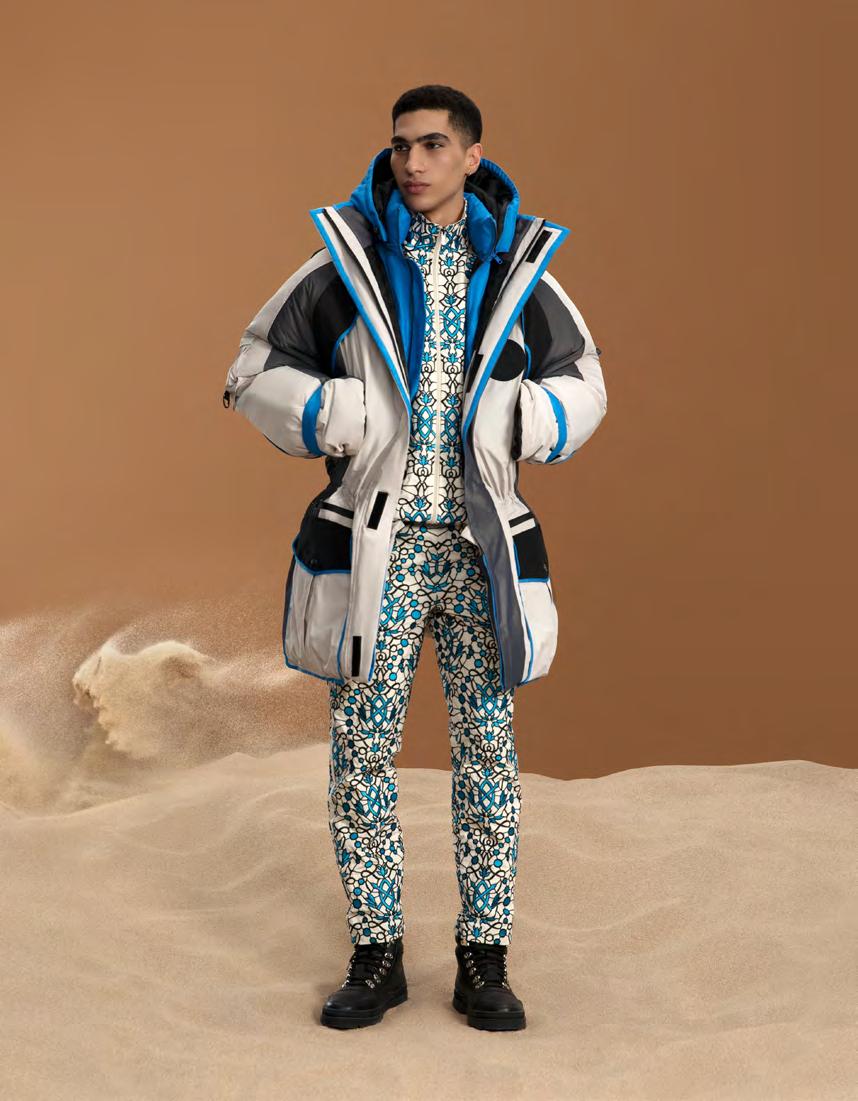
As third-culture kids, apart from paying a continuous homage to their roots, they give back to African communities via charitable initiatives, highlight various artists and industries
around Africa, and hold yearly pop-ups in Johannesburg and Accra to sell dead stock to local youth at affordable prices.
Daily Paper is more than a clothing brand; it’s a street movement addressed to the Black community and underrepresented individuals who try to find their voices through fashion. Amid a global fashion industry with more and more clothing brands popping out every day, it’s essential to support those who represent a message, more than just clothing, and break the stereotypes.
@DAILYPAPER @PAPAGHANA @HUZANE @CAPTAINAOSHIMA 235
NEW LUXE LEATHER TOTE BAGS


VEGETABLE-TANNED VACHETTA LEATHER
NATURAL, NON-TOXIC CHEMICALS
 Archer Bag Blue Metallic
Archer Bag Blue Metallic

 Archer Bag Copper Metallic
Archer Bag Copper Metallic


Our mission is to remake, reuse, recycle, and repurpose for a prolonged life cycle. diarrablu.com


Flesh-Tone Required
ERIN CARPENTER IS BREAKING BARRIERS THROUGH NICHE FASHION WITH NUDE BARRE
PHOTOGRAPHED BY:
@NOEMIEMARGUERITE @JAQLINMEDLOCKPHOTOGRAPHY
WRITTEN BY: STELLA
POLYZOIDOU
STYLED BY: NUDE BARRE
standards crucial. To solve a typical issue that girls and women of color face daily, Erin Carpenter, founder and CEO of the revolutionary brand Nude Barre, started her company back in 2009 in New York City.

Global colonization, the slave trade, and marginalization have affected how the world sees people of color, which has been damaging for people's self esteem. Unfortunately, this discrimination remains in the fashion and beauty industries , where clichés like light skin color are still considered the gold standard for being beautiful. Darker-skinned women continue to be underrepresented, making work to redefine beauty
Nude Barre is a women’s empowerment brand that provides eco-friendly tights and intimates in 12 signature nude shades to match all skin tones, from fairskinned to medium skin and deeper or darker skin tones with a size ranging from S/M to 4XL/5XL.
The brand’s mindset relies on the fact that for years, women of color struggled to find the
TROORA MAGAZINE 240
Founder Nude Barre Erin Carpenter

241
“It’s not about trying to fit into the tights and the hosiery anymore; it’s about getting one that fits your skin tone and size.”
proper color foundation to match their skin tone the same way as their stockings. Besides that, nude was considered one shade, and the options for nude hosiery were limited on the market.
Nude Barre’s mission is to fight colorism in the undergarment industry and offer authentic representation to people of all hues. A pioneering line in the shade inclusion movement that redefines the color nude by delivering 12 shades of nude instead of the classic five. Allowing people to have this perspective that nude is individual and personalized, Nude Barre aims to personalize that for humans across the world. It’s not about trying to fit into the tights and the hosiery anymore; it’s about getting one that fits your skin tone and size. Therefore, when embracing your true color, you’re embracing yourself.

Starting her career as a ballet dancer, Carpenter was always required

TROORA MAGAZINE 242
to have nude or flesh-toned tights, underwear, panties, bras, and sometimes shoes that would match her skin. Going to stores only to find that the only option for her was the beige shade that wasn’t even right. After a series of embarrassing and frustrating moments, Nude Barre came to life. To empower women to love their skin, feel included, and give a more personalized experience in their undergarments, Carpenter launched Nude Barre to celebrate all the beautiful hues, and she is taking the stockings industry by storm!
What’s special about these products is their durability, design, and variety, with 12 different nude shades representing diverse skin tones. The color is also a time of daylight, starting at 7 AM and to midnight. Based on her experience as a dancer, Carpenter paid attention to the longevity of the stockings, making them durable enough for the active woman on the go. Celebrities such as Wendy Williams, Doja Cat, Lizzo, Tyra Banks, and Laverne Cox have long favored these stockings and intimates, giving Nude Barre great credibility.

After giving birth to her daughter, Carpenter wanted to launch a children’s line to empower young girls of color and eliminate all these issues about self-esteem, body image, and colorism. Nude Barre is truly changing the game for the Black community, addressing products for their needs.

NUDEBARRE.COM @NUDEBARRE @_ERINCARPENTER_ 243


apotecafashion.com





REGENERATIVE AND JUST. zero-waste, fair fashion tonle.com
Ethically Handmade and Sustainable Jewelry Made in Spain

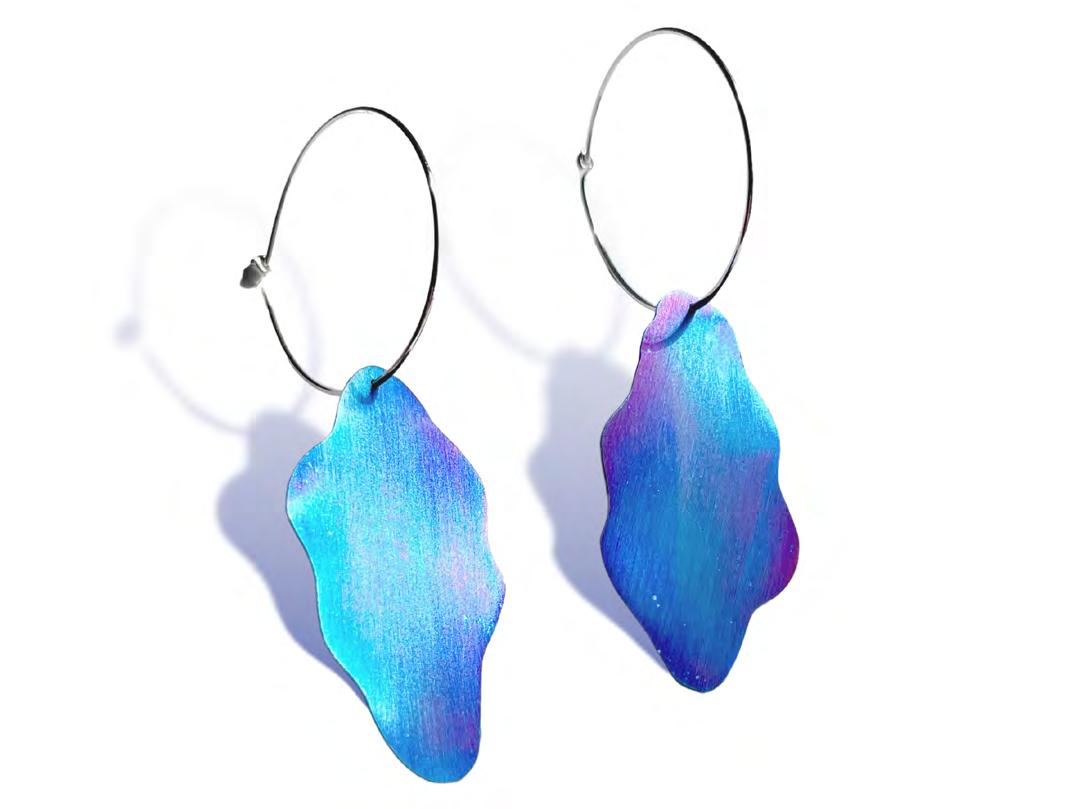
lolamohe.com


Mami Wata is the Spirit of African Surf
The First African Surf Brand is Making Waves Throughout the Global Surf Culture
 WRITTEN BY: KEVIN JAMES JEFFERY
PHOTO CREDIT: @MAMIWATASURF
WRITTEN BY: KEVIN JAMES JEFFERY
PHOTO CREDIT: @MAMIWATASURF
TROORA MAGAZINE 250
Mami Wata

251 TROORA BLACK HISTORY ISSUE 2023
For many, surfing is more than the act of riding a curling body of water breaking near the shore. Some see it as a cultural wave that can spread throughout communities and change people’s lives. What began with the Polynesians back in the 12th century and was popularized in the 1950s and 1960s in California and elsewhere has spread worldwide. Surfing has not only become a hobby and professional sport but has a significant influence on music, art, film, literature, and fashion.
One of the companies making a huge splash in the African surf culture and throughout the world is Mami Wata. The brand’s name comes from the African water spirit that comes in the form of a mermaid with a serpent wrapped around its body. From Morocco to Madagascar, Mozambique to Liberia, Mami Wata (Mama Water) is known to abduct her followers and return them wealthier, more attractive, and with a new spiritual understanding of life.
What began in 2017 by cofounder and CEO Nick Dutton and his partners out of Cape Town now sells globally. Known as an African Surf lifestyle brand, a significant part of Mami Wata’s success can be attributed to Dutton’s previous experience in advertising global leaders such as Volvo, Jaguar, and Snickers in South Africa and the UK. His 20-year career, coupled with his global adventures, inspired him to create an African surf lifestyle brand that would help people view and understand Africa through a different lens.

So what exactly is the African surf lifestyle? For Mami Wata, it’s more than the products they sell—it’s manufacturing in Africa, supporting African youth surf therapy organizations, and strengthening African surf communities and tourism. These initiatives are part of the company’s mission to be a creative force in Africa. The proceeds from Mami Wata’s award-winning book AFROSURF go towards African surf therapy organizations as well as Waves4Change and Surfers Not Street Children.
Another of Mami Wata’s co-founders, Selema Masekela, remembers a time when Black surfing in South Africa was unheard of. His father was from the country, but Masekela grew up in California and New York and decided to come to South Africa postapartheid. Even though legislation that segregated
non-whites had been lifted, it was still unprecedented to see a Black man surf for fun—and that’s exactly what Masekela did. He recalled the other kids looking at him as though he had just stepped off a spaceship.
“The police tried to arrest me in Durban because they were so perplexed at what they were seeing,” he told Vogue in 2021.
One of the other owners of Mami Wata is the creative director and artist Peet Pienaar. Like Masekela, Pienaar believes in the power of “Afrosurfonomics” and the positive impacts of surfing on local communities.
“When a place has a great surf break, let’s say in some remote location in Gabon, that break has the potential to generate sustainable income for the community living there. It’s surf tourism,” he told Forbes last year. “We believe that if done right, surf can play a massive economic role in Africa similar to the role a ski slope plays in Europe.”
With the massive surge of African culture starting to hit the West, Mami Wata wants surf culture to be a part of that wave. Pienaar says that Africa is not a forgotten continent anymore; it’s part of the globalized world. And it’s not just modern culture that comes along with this reconnection; it’s all the excluded art and culture over thousands of years. “Surf is one of the many overlapping connections between the West and Africa. I strongly believe that this overlap is where our power lies,” he says.
The type of apparel, accessories, and surfboards Mami Wata creates are reflective of the slogans, graphics, and patterns of African culture. Not only do they come up with their designs, but Pienaar also collaborates with African artists inspired by local South African culture. They also sell hoodies and prints with popular surf spots throughout Africa. For example, Masekela says you have to check Jeffreys Bay in South Africa off your list if you’re a hardcore surfer. “It’s one of the eight wonders of the world,” he claims.
For those living in the United States who want to get their hands on a piece of African surf culture, Mami Wata also has a shop in Venice Beach, California, and an online shop. Their Robertsport Surf Club Liberia collection includes hoodies, tees, and a surfboard, in which all of the profits fund surf therapy in Liberia. They also plan to launch towels, beach bags, and more. With more collaborations in the works, Mami Wata hopes to keep pushing boundaries and opening up people’s perceptions of African surf culture.
TROORA MAGAZINE 252
“We believe that if done right, surf can play a massive economic role in Africa similar to the role a ski slope plays in Europe,” says co-founder Peet Pienaar.

@MAMIWATASURF 253
swim and lounge wear sustainable and inclusive designed for fit, comfort, and versatility
boldswim.com




Passion for travel and exquisite apparels.

« People come, live and go ».
And we are here to celebrate the diversity of the world.
alledjo.com

Wearable Modern Art
Full of Creativity, Sophia Demirtas has Turned her Passion for Fashion Into a Luxury Clothing Brand
PHOTOGRAPHED BY: COURTESY OF FANM MON
WRITTEN BY: STELLA POLYZOIDOU STYLED BY: SOPHIA DEMIRTAS
One of the best parts of starting a new hobby is the ability to turn something you love into a profitable business. That is the case for Fanm Mon—a Turkish fashion label that launched in 2013. Behind this vision is the Haiti-born, Turkey-based designer Sophia Demirtas who, along with her husband, has created a brand of bold and colorful ready-to-wear.
Demirtas worked at a homeless shelter in New York City before moving to Turkey and pursuing her dream in the fashion industry. What makes this brand unique is the different backgrounds combined into modern silhouettes. Fanm Mon embraces the craftsmanship of masterful artisans from Ukraine and Turkey and the rich cultural heritage of Haiti.
Known for a mix of delightful colors, bold patterns, and handmade embroideries weaved into beautiful garments, Fanm Mon offers modern alternatives to traditional styles. Each piece has been carefully handembroidered by skilled craftsmen at the brand’s headquarters in the US, Turkey, and Ukraine.
Originally, Demirtas got involved with jewelry making, but within two years, she transitioned to womenswear, realizing that brought her greater joy. The pivot was born from a need to showcase her jewelry with eccentric garments. “It really started out of personal necessity to make designs that were reminiscent of my childhood. Having been born and raised in Haiti, I got into these interactions with color, pattern, and texture,” Demirtas says on a Zoom call.
The brand offers intricate handmade pieces inspired by the cultures of Haiti and Africa. Through each collection, the designer pays homage to her Haitian heritage, roots, and community. The home feeling inspires her most, accompanied by a love for nature and admiration for women. “Nature is my main source of inspiration and my childhood memories. I grew up surrounded by many women who embrace their femininity with floral prints, bold, vibrant colors,” she explains.
Growing up in Haiti, Demirtas could see firsthand what her grandmothers, aunts, and neighbors wore, which was a strong point of reference later in her life. This feminine energy is now mirrored in the brand’s creations.
 Fanm Mon Founder
Fanm Mon Founder
TROORA MAGAZINE 258
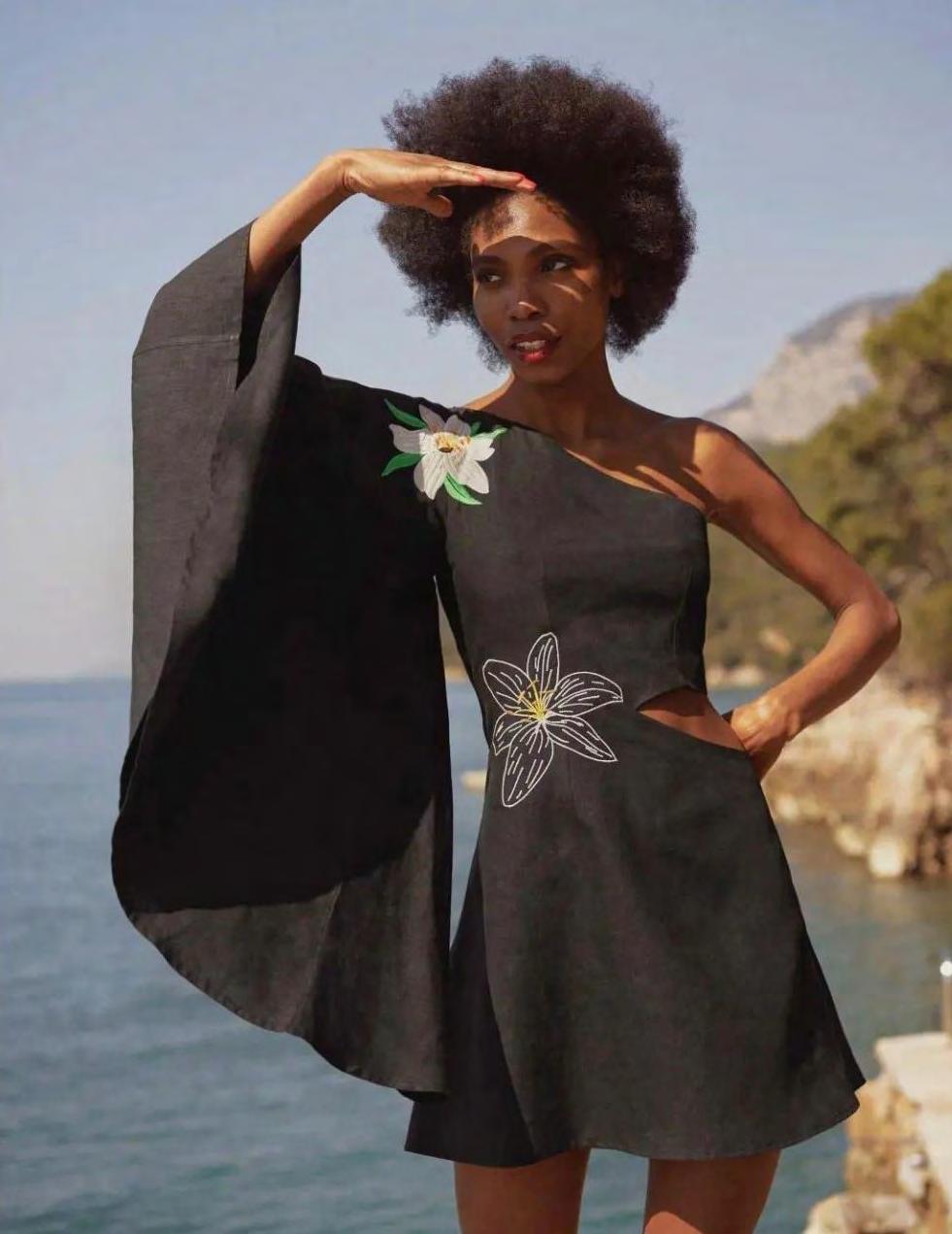
259
The choice of the name Fanm Mon couldn’t be random. Fanm Mon is a Haitian phrase that means “peasant woman,” a nurturer intertwined with nature. The term is used to describe all these women rooted in their village’s upbringing. Demirtas has given a new interpretation to this colloquial expression. “Fanm Mon signifies the woman that nurtures and understands nature and is one of the most powerful beings on earth. For my brand, I wanted to highlight the feminine aspect of our culture, the significance of the Mon people, especially the women,” she highlights. After leaving Haiti at a very young age, Demirtas kept in mind the value of these women, and as she grew up understood that their spirit was universal. Her creations are works of art that stand out for their exquisite craftsmanship, unique embroidery, and romantic silhouettes, three characteristics of the brand. Everything is a thoughtful process with a focus on each step. “Design came into being a part of my daily life. First, I started the business on a made-toorder basis, and everything happened at a digestible pace for me, which helped the business become a part of my life and vice versa,” adds Demirtas. Everything is produced at her facility, which allows her to keep the orders on track. “Having our production atelier in Turkey allows me to compose my specific linen quality from scratch. The softness, durability, and breathable, lightweight linen texture is a result of making Fanm Mon’s linen from thread,” she explains.


TROORA MAGAZINE 260
“For my brand, I wanted to highlight the feminine aspect of our culture, the significance of the Mon people, especially the women”
Besides using primary linen, Fanm Mon also incorporates sustainable and eco-conscious practices into its business model. “In Haiti, we are always thinking of ways to reuse things or re-purpose them in new ways,” she adds. Demirtas explains that her approach is centered around sustainability, with most of the work done by hand and using only natural fibers—flax, cotton, and silk—from local suppliers. However, the founder’s vision is more than delivering something appealing to the eye. It’s about making people relate with her, evoking emotions, and sharing a common mindset with her customers.“I didn’t feel the need to become a different person to start creating clothes or selling a narrative that didn’t match my mindset,” she explains.


Demirtas describes Fanm Mon as a symbol of femininity, a mix of modernity, heritage, and freedom. As a result, she focuses on creating long, airy, flowing, and lightweight embroidered dresses with a fluid movement, perfect for a Sunday brunch or soirée. “I’ve learned the importance of caring for what you create, especially what goes on in peoples’ bodies. The point of reference will make people stick with you and have transparency and confidence,” she denotes.
As a woman of color, mother, and creative CEO of her brand, Demirtas feels extremely proud of her heritage and all the strong points of reference that have influenced her journey. She is a source of inspiration for all the young entrepreneurs who have just started, especially for women of color who are underrepresented in the fashion and beauty industries.
When asked what impact she wants to have in the world, she answered, “It would be vital to get to a point where the color of our skin isn’t necessarily attached to everything we produce. Thinking of women as multifaceted and not monolithic, what I design is addressed to women of that aesthetic who could appreciate the detailing and history that comes with those garments.”
FANMMON.COM @FANMMON @PIERRE_SOPHIA_ATELIER
261
Sustainable jewellery made out of recycled and eco-friendly materials

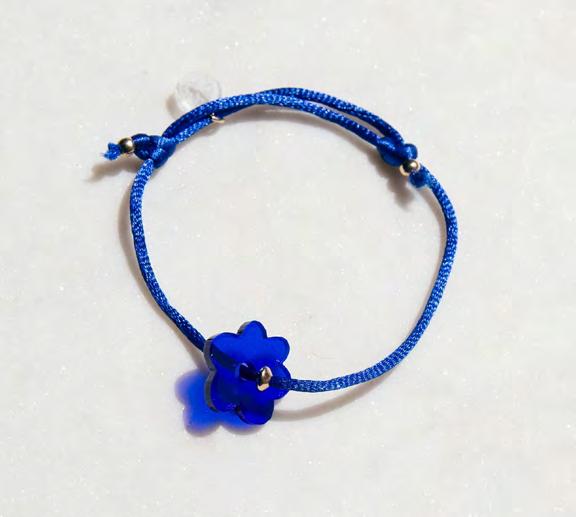

ayrtan.com
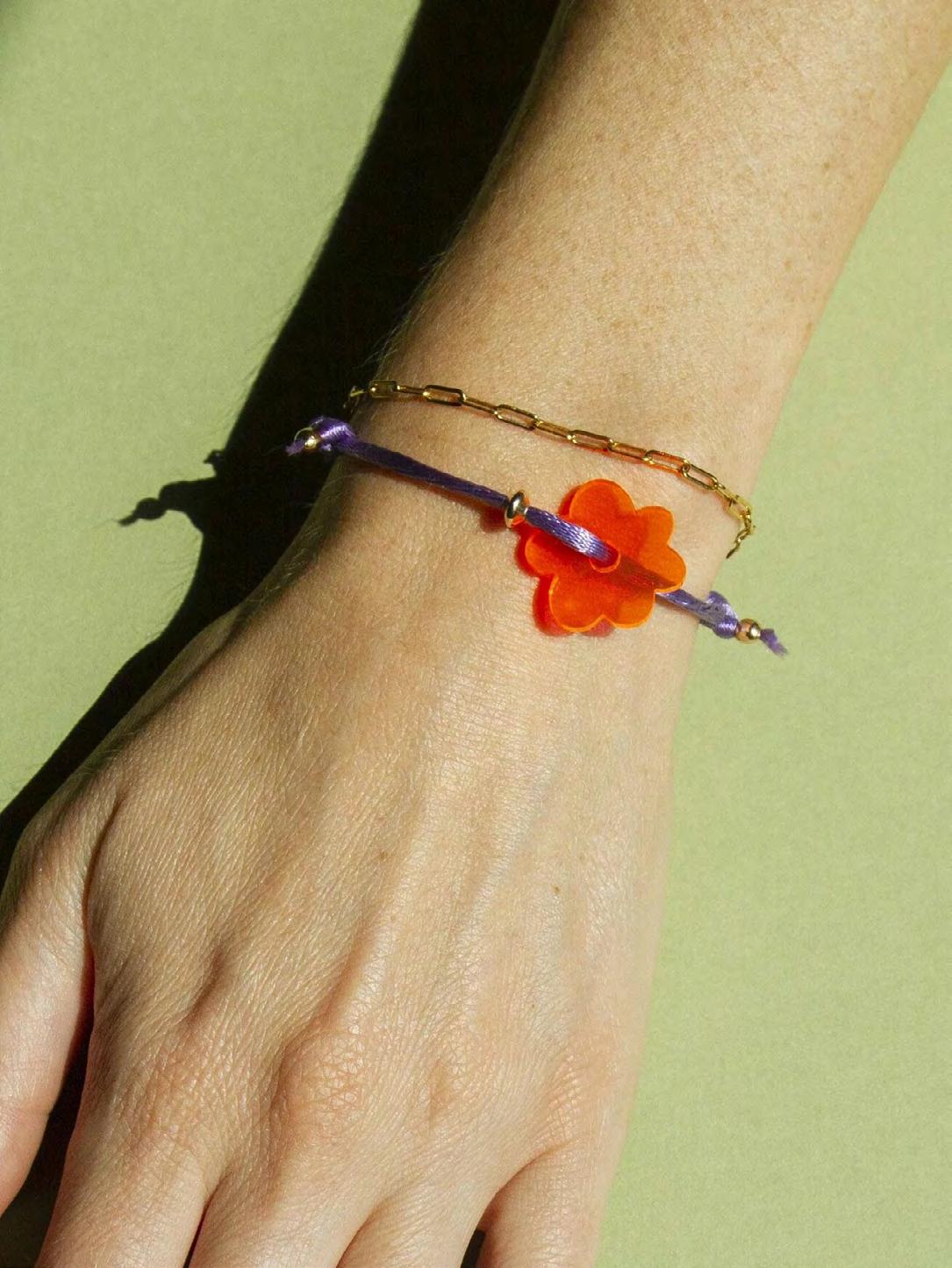

reclaimsl.com
Breathing New Life Into Antique Fabrics
A Sustainable Take On Luxury



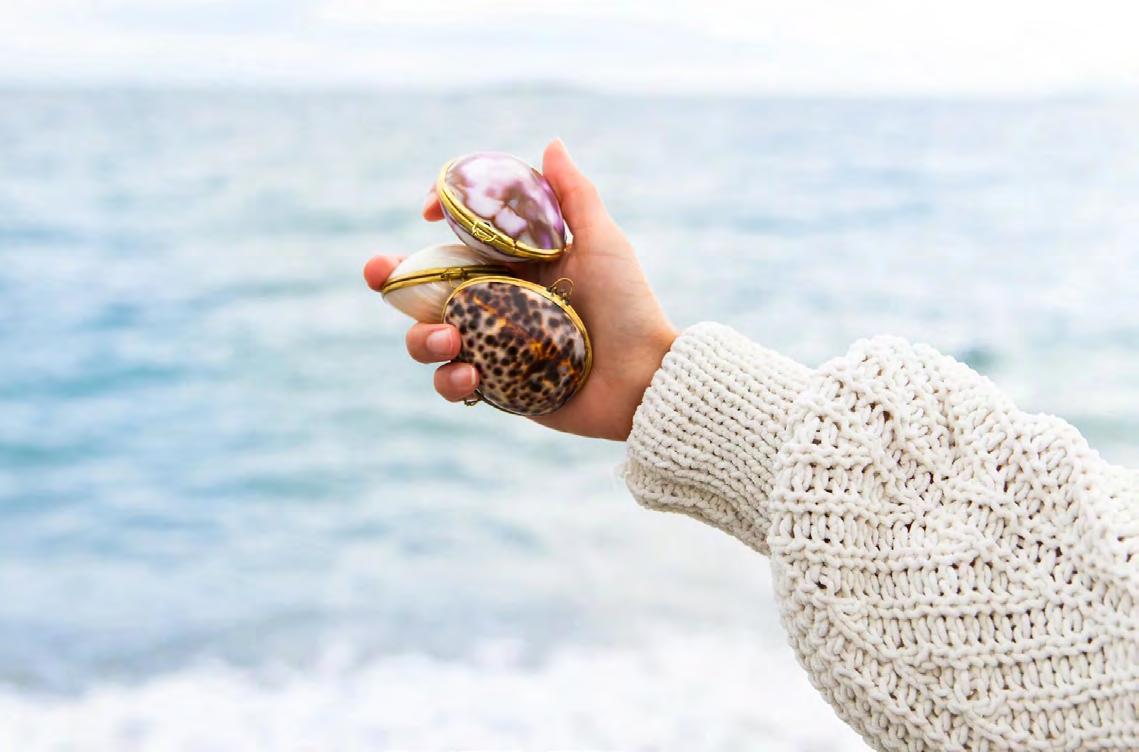

earthtuface.com Created in California, our all natural, sustainably sourced skincare is formulated with the recognition that we are all part of the earth. What is good for the Earth is good for us.
Skincare is self-care


FROM CJ WALKER TO RIHANNA
BLACK WOMEN WHO TRANSFORMED THE BEAUTY INDUSTRY
BY: NEHA SURADKAR
270
Beauty TROORA MAGAZINE 268

269
From CJ Walker to Rihanna
Black Women Who Transformed the Beauty Industry
WRITTEN BY: NEHA SURADKAR
The beauty industry promises to enhance people’s appearances and lives with magical products and formulations. However, prejudice has always affected Black women, from not having options for skin tone or using chemicals that damage their skin to the non-availability of hair products. Only recently have cosmetics started to provide more extensive choices. Much more has to be done in terms of diversity in beauty, yet progress is being made. From the beginning, beauty has always been about fair skin and brighter complexions. White women have long been the focus of the beauty business, giving women of color fewer options and more reasons to feel excluded, except when advertising skinlightening creams, the mainstream beauty business primarily targeted Black women. As a result, Black consumers experience the beauty industry in a way that is noticeably more frustrating than other consumers and is rife with several friction points. The Black is Beautiful movement of the 1960s and 1970s introduced many concepts of beauty to the general audience. Henceforth, cosmetics companies like MAC and Bobbi Brown began to offer products for a broad spectrum of skin tones. Black women have always been the changemakers and innovators primarily due to the necessity. This is important for the representation of people of color in the beauty industry as well as for the usage of harmless ingredients in product formulations. Powerful Black women have been working to alter the narrative for future generations in skin care, hair care, and makeup. History has witnessed Black women contributing to the beauty industry by formulating products for people of color.
PHOTO CREDITS: DAZZLE JAM, TURNBO FAMILY, JOHNSON PUBLISHING COMPANY, THE PAT MCGRATH LABS, TAYLOR HILL, BALANDA ATIS
TROORA MAGAZINE 270

271
The pioneer, Annie M. Turnbo Malone, born in Illinois to enslaved parents, used her love of chemistry to create hair products under the supervision of her aunt, who was a herbalist. Her goal was to create a solution that, in place of the then-common components like butter, oils, and lye, would straighten coiled hair while maintaining a healthy scalp. Being a Black woman, she could not use the conventional distribution channels that other brands could. Therefore, she had to sell her goods door-to-door. Malone established Poro College in 1918, the first beauty school in the United States teaching Black cosmetology, and made $14 million by 1920.

Madame C.J. Walker was born Sarah Breedlove on the plantation where her parents had previously been enslaved. Breedlove was motivated to develop her product line after suffering from scalp irritation and hair loss. She tried Malone’s hair products and joined her sales team as well. After changing her identity to Madam C.J. Walker, she spent just $1.25 to launch her hair care line, which included an ointment, a heated comb, and a scalp massage. Within a short period, her innovation generated over $500,000 in sales. Through self-promotion, door-todoor sales, and product demonstration, she brought in the trend of speaking directly to the consumer. Her approach differed significantly from then-dominant white men’s firms promoting hair straightening treatments that did not aid with hair loss.

Eunice Walker Johnson, another name in FUBU (For Us, By Us) beauty, curated the prestigious Ebony Fashion Fair in 1961. The mobile fashion show that served as a charity fundraising platform included Black models. In 1973, Johnson established Fashion Fair Cosmetics, which is still in business today and offers lipsticks and face powders developed for Black women’s varied complexion.
 Annie MaloneThe Turnbo family
Madame C.J. Walker
Annie MaloneThe Turnbo family
Madame C.J. Walker
TROORA MAGAZINE 272
Eunice Johnson
Pat McGrath, one of the most coveted, respected, and influential makeup artists, began her career in the 90s by creating makeup looks for runways, ad campaigns, and magazine editorials. She has conceptualized the launch of various cosmetics lines of luxury brands, from Giorgio Armani to Dolce & Gabbana. In 2016, she introduced Pat McGrath Labs, her namesake beauty company that produces highend, dramatic lipsticks, eyeshadows, and foundations for women of all skin tones. In 2019, McGrath was listed as one of Time’s 100 most influential people.


Rihanna, nine-time Grammy award-winning artist, shook the beauty industry by launching Fenty Beauty with 40 shades of foundations “so that people everywhere would be included.” The brand has now transformed into a multi-faceted fashion empire celebrating people of all shades and sizes.

Balanda Atis, Director of Face & Multicultural Beauty lab at L’Oreal, shared her love of makeup and science. To help create more inclusive shade options, Atis performs on-theground research by measuring various skin tones around the nation. She is leading the development of a brand-new category for all L’Oréal products that will offer a wide range of hues for Black women.
The beauty industry cannot forget the Black supermodels and cover girls—Naomi Sims, Tracey Norman, Iman, Beverly Johnson. These women appeared on the coveted covers of Vogue, Elle, and Harper’s Bazaar and walked the runway for various fashion weeks, reinforcing the Black is Beautiful movement.
When it comes to racial discrepancies in the beauty industry, the adage “beauty is just skin deep” takes on a new meaning. While much work is still to be done, many beauty queens are attempting to close the gap and make beauty more inclusive.
Pat McGrath
Rihanna
273 @NEHASURADKAR
Balanda Atis



LOVE THE WAY YOU LOOK LOVE THE WAY YOU FEEL. loveiguehi.com




boldswim.com Clean Conscious Skin Care Cruelty Free, Vegan, Organic, Inclusive for all Skin Types Get Your Glow On
Wellness 280
STAND IN LOVELAND YOU ARE NOT ALONE; THE LOVELAND FOUNDATION STANDS BY YOU BY: STELLA POLYZOIDOU
TROORA MAGAZINE 278

279
Stand In Loveland
You Are Not Alone; The Loveland Foundation Stands By You
PHOTOGRAPHED BY: COURTESY OF LOVELAND FOUNDATION
WRITTEN BY: STELLA POLYZOIDOU
STYLED BY: LOVELAND FOUNDATION
Given the social injustice, the subsequent Black Lives Matter protests, and the police brutality in response to those events, African Americans have been traumatized over the last few years. Because of the stigma attached to the difficulties people who suffer from mental health issues experience, it is more important now than ever for the Black community to get the most effective support possible. Especially women of color who experience mental health issues that are often misunderstood and perceived as complex and problematic. When they find the courage to ask for help, they rarely receive any because there’s a prevalent and ingrained stigma surrounding mental health, and the mental health of Black women is still considered a taboo subject. With therapy sessions in the U.S. typically costing anywhere from $80 - $250, it’s hard to find a therapist you can afford through insurance or just paying out of pocket. There’s often a lot of trial and error involved, and it can be even harder for Black women and girls in a marginalized community to access therapy when needed. Due to the lack of conversation and knowledge surrounding mental health, receiving proper care is a long and high-priced process.

TROORA MAGAZINE 280
Founder Rachel Cargle

281 TROORA BLACK HISTORY ISSUE 2023
The Loveland Foundation was created to provide resources to communities of color, especially Black women and girls, to address the issues and end the stigma surrounding mental health.


The mastermind behind this non-profit organization is the lecturer and activist Rachel Cargle. After her successful birthday wish fundraiser, Therapy for Black Women and Girls, she raised a huge amount, making it possible for Black women and girls nationally to receive therapy support. The fundraiser was a massive success— it raised over $250,000, and Cargle decided to continue even when the fundraiser was over.
The Loveland Foundation was established in 2018, and since then, it has been committed to showing up
for communities of color in unique and powerful ways. Cargle has devoted her work to exploring the intersection between race and womanhood while dealing with addressing historical injustices that need to be rectified for the thriving of people of color.
To promote its vision, the Loveland Foundation offers therapy funds— vouchers for free for women and girls of color to receive therapy, ensuring they receive the help they need to deal with racial trauma. Moreover, the Foundation cooperates with mental health professionals who provide high-quality care and are also aware of the cultural beliefs and valuesof the Black community.
TROORA MAGAZINE 282
From its establishment to this day, the Foundation has managed through fellowships, residency programs, and listening tours to make therapy more affordable and accessible. In addition to raising and distributing money, the Loveland Foundation also has partnerships with organizations such as Therapy for Black Girls, National Queer & Trans Therapists of Color Network, Talkspace, and Open Path Collective— all of which are working towards various aspects of Loveland’s goal.
It’s important to remember that every dollar that goes toward the Loveland foundation is not just going toward the treatment and healing of one person; it’s going toward the Black community and the future of that community as a whole. For Black women and girls to have access to therapy, not only will they

greatly benefit from this, but future generations will also experience the effects of this healing.
Their motto is: “We see you, hear you, and invest in your healing.”
Through having meaningful conversations and sharing mental health resources with the youth community, it’s now possible to truly educate and prevent others from experiencing struggles in life.
TO @SADGIRLSCLUB
THELOVELANDFOUNDATION.ORG @MORGANHARPERNICHOLS @THESTORYTELLERCO CREDITS
@THELOVELANDFOUNDATION @RACHEL.CARGLE
283 TROORA BLACK HISTORY ISSUE 2023



Live the Life You Were Meant to Lead life-organized.com

A holistic healing collective founded on the principles of Chinese and Functional medicine.
A blend of modern health principles and ancient wisdom, to curate a personalized, multi-disciplinary healing experience.

TROORA MAGAZINE 286
magnoliawellnessoc.com



Health & Fitness
290
LOGGING ON TO HEALTHY LIVING A PIECE ABOUT THE SERVICES, EXPLOITS, AND GOALS OF BMT AS A SOLUTIONS PROVIDER
 BY: JESSE ADUMA
BY: JESSE ADUMA
294
BLACK HEALTH MATTERS A DIVE INTO THE LIVES AND ACCOMPLISHMENTS OF THE FOUNDERS OF BLACK HEALTH MATTERS, A BLACK OWNED ORGANIZATION
BY: JESSE ADUMA
TROORA MAGAZINE 288
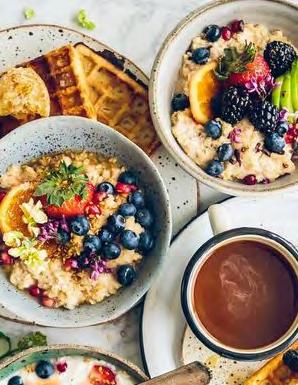
289
Logging On To Healthy Living
A Piece About The Services, Exploits, And Goals Of BMT As A Solutions Provider
PHOTOGRAPHED BY: BMT CONSULTING SERVICES
WRITTEN BY: DR. BETH THOMAS
BMT Consulting Services is a consulting agency that collaborates with purpose-aligned digital health and virtual care platforms. If your goal is to keep fit and healthy, you don’t have to look any further.
The organization specializes in providing health services for women; they also provide services focused on helping digital healthcare and wellness companies leverage effective, evidencebased content, course, and collaboration solutions for faster growth and bigger impact.
Some of these services may include; prenatal weight management and nutrition for positive pregnancy outcomes, menopausal weight management and nutrition for optimal symptom management, and women’s weight management for improved metabolic health and increased quality of life.
ABOUT THE FOUNDER
Dr. Beth Thomas is a digital health consultant, CEO of BMT consulting services, LLC (previously BMT coaching), and a medical expert board member for Verywell Health. She is also a clinical advisory board member for Mae, a digital health platform dedicated to driving positive pregnancy outcomes for Black expectant mothers. Additionally, Dr. Beth is a licensed pharmacist and certified nutritionist with over 14 years of experience in multiple settings. Quite easy to see that Dr. Beth is a woman of remarkable skill/talent and is a force to be reckoned with. Her goals are clearly within reach, thanks to her efforts to make this a reality.
Dr. Beth’s weight struggles motivated her to start her company to help other women, particularly those in the Black community, achieve optimal health throughout all the stages of their lives. She created a fivephase coaching system to help women harness the power of nutrition for permanent health and weight transformation.
After experiencing coaching success, Dr. Beth became passionate about expanding

290
Dr. Beth Thomas
her reach to serve organizations with all she has created so they can multiply her results through their platforms. It is also important to note that in 2020, Dr. Beth’s company was named by the American Fitness Professionals (AFPA) as one of the seven Black-owned health and fitness businesses that are changing the industry. Well-versed in different medical fields, Dr. Beth uses her knowledge to improve the lives of women across the world.
“BMT consulting was born as my way of sharing everything I learned, both during my weight loss journey and in my work as a pharmacist, to create effective and proven programs to help other women to improve their health. Now I partner with digital health and wellness organizations to take those programs to the masses.” -
 Dr. Beth Thomas
Dr. Beth Thomas
As the premier digital health consultant, the BMT consulting team provides action plans for growth, implementation audit support, exclusive health education content, custom clinical pharmacy solution, and white-label health coaching programs.

“I don’t feel like I’ve been run over by a truck all the time. Before, when I got home from work, I’d plop down on the couch and I would be so tired and feel like I couldn’t do anything else for the rest of the day. And now, I feel like I have the energy to go all the way into the night. So it’s definitely been life-changing! I can’t even explain how different I feel. I’m not feeling like I am walking around with chains holding me down, fighting against lethargy, and being so tired. I love that feeling; I am eating the stuff my body likes and needs.” - BMT coaching client.
Women (especially women of color) find it difficult to access high-quality and effective health solutions due to the current ineptness of the health and wellness industry. Due to this major problem, the need for a solutions provider has arisen, and BMT Consultant Services comes in to cater to this need. The company was built for the primary purpose of aiding women in their fitness journeys, helping them keep fit all through the stages of
their growth, with a vast service range spanning women worldwide. BMT’s mission is to come alongside purpose-aligned digital women’s health and virtual care platforms for maximum profit and influence because they believe companies that focus on improving the healthcare landscape for women are worth championing. We have several achievements and positive reviews to prove that there is major progress towards achieving our goal.
Some of the ways the company supports clients include;
Content: Keeping up with the content demands of operating an organization can be challenging. To smooth these operations, BMT steps in as trusted professionals to contribute to your content needs so that you spend less time creating content and more time attending to your clients. Some of the content may include; videos, blog posts, podcast episodes, live social media interviews, etc.
Courses: Creating proven, effective, evidencebased programming takes time, effort, and money. BMT can be regarded as efficient in this area as they help save time by licensing already proven programs for use with your clients and patients. These programs may include access to our ready-made, tested programs, Custom program development using our proven framework.
Collaboration: “Many hands make light work. That is why I love to support organizations by stepping in as a clinical advisor to help them support their clients and patients” Dr. Beth. Some ways in which BMT collaborates with clients may include; data collection and reporting, Black healthcare focus, Operational process, and implementation.
Licensed and verified in the following fields, BMT is sure to aid, support, and deliver quality services to clients who require the services of Product trainers, Weight Management Specialists, Nutrition and Wellness Consultants, and Licensed Pharmacists.
“Many hands make light work. That is why I love to support organizations by stepping in as a clinical advisor to help them support their clients and patients”
DR. BETH
291
Naturally perfect.



A new squeeze on healthy hydration! lemonperfect.com
Black Health Matters
A dive into the lives and accomplishments of the founders of Black Health Matters, a Black-owned organization.
 PHOTOGRAPHED BY: BLACK HEALTH MATTERS
WRITTEN BY: JESSE ADUMA
PHOTOGRAPHED BY: BLACK HEALTH MATTERS
WRITTEN BY: JESSE ADUMA
Answering the call to cater to the high-neglected health needs in the African American and Afro-Latin communities, Black Health Matters has emerged as a pillar of support dedicated to improving the overall health conditions in these lackluster environments.
Maintaining a unique video-centric delivery method with a multiplatform health education network produced for diverse populations, the company provides muchneeded and vital information about health and wellbeing from a service-oriented perspective.
TROORA MAGAZINE 294
About BHM
A health-inclined organization primarily dedicated to African Americans, the company is aimed at helping to better the health of its patients, helping spread healthrelated information to African Americans in need of said information, and in doing so, helping increase the rate of health literacy amongst African Americans.
Black Health Matters is a Performance-based multimedia company dedicated to serving and uplifting African American and Afro-Latin patients. Launched in November of 2022, the company has proven that it possesses the skills, platform, and expertise to deliver impactful and engaging multi-channel marketing programs.
According to BHM, the number of African Americans that stay ignorant of preventive measures to improve their health is quite alarming, and this is where BHM comes in, working and hoping to greatly reduce the number of African Americans in this category.

“African Americans have poor health outcomes on nearly every disease index; we are either at higher risk for developing an illness or we die from it in great numbers. While access to health insurance and socioeconomic status play a significant part in these health disparities, our lack of awareness about a lot of preventive steps we could take to better our health is also a major reason for said health disparities, and we are in denial of this sad truth. Black Health Matters will provide information about health and well-being from a service-oriented perspective with lots of upbeats, positive solutions tips.”
Taken from BHM website.
Black Health Matters targets adults between the ages of 35-54 and will skew 60% female and 40% male.
The company’s platform consists of components specially designed to work together to deliver consumer engagement programs that are efficient and drive ROI, the company holds between 11-50 employees, and the headquarters are located at Heldon, NJ.
BHM specialties include communications, health literacy, social media, digital campaigns, African American health virtual programs, and clinical trial recruitment.
“We have taken conscious steps to make our Goal come to fruition, and this set goal is well within our reach.”
Roslyn Daniels, President.
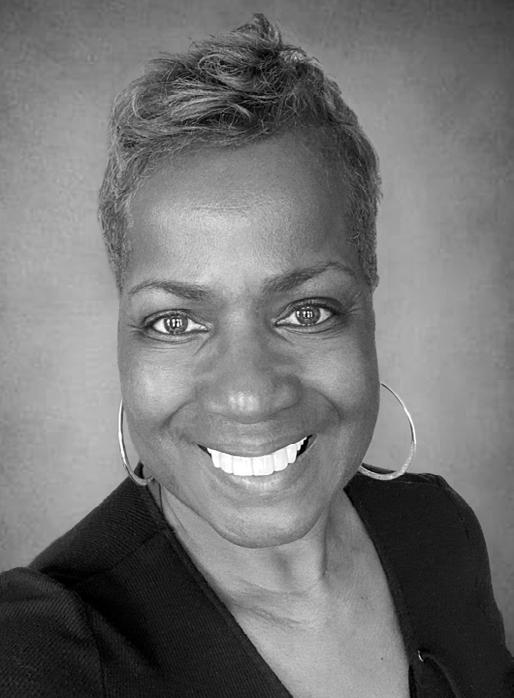
295
About The Founder
Roslyn Young-Daniel is the award-winning president and founder of Black Health Matters. As a nationally respected health strategist with over 20 years designing and implementing crosscultural health education programs and initiatives, Daniels has also strived to create the leading health promotion and disease management online platform serving the needs of many consumers, patients, and physicians. She is a tireless advocate for eliminating health disparities by improving health literacy among African American consumers and patients.
In 2018, she launched the Black Health Matters summit, a multiplatform initiative featuring live Ted Talk-inspired presentations by leading clinicians and health advocates. Over 15,000 have registered, and over 9,000 attended and viewed the webinars 45,000 times in 2021. Utilizing Black Health Matters’ ecosystem, the sessions are being shared on social media, via newsletters, and live on the website. An unprecedented number of community and professional organizations are stakeholders of the summit.

Some of these organizations are Kappa Alpha Psi Fraternity, Inc.; Alpha Kappa Alpha Sorority, Inc.; The Links, Incorporated; the National Coalition of 100 Black Women; and the A.E.A.O.N.M.S. Prince Hall Shriners, Inc.
Daniels has had quite a number of impressive accomplishments, some of which include: Receiving the digital diversity networks social entrepreneur award in 2017 and conceiving and implementing two programs with original content adopted by the national medical association (prescription for exercise, the NMA breastfeeding medical alliance).
Moreover, Daniels is a graduate of Boston University and retains a certificate from the top diversity business program.
The Managing Director
Lesley Fontenot is an award-winning communication and marketing executive with 20+ years of cooperative and agency experience. Fontenot is currently the managing director for Black Health Matters (BHM), a 10-year-old, women-owned, integrated media and communications company dedicated to improving health outcomes in the African American community.
Fontenot oversees operations and marketing strategies across Black Health Matters (BHM) digital and social platforms and prominent pharmaceutical, healthcare practitioners, and biotech companies to help create authentic and impactful connections with the BIPOC communities.

TROORA MAGAZINE 296
She honed her expertise as a corporate and agency brand marketer working with fortune 1000 companies across multiple product categories, including hospitality, beauty, health, consumer packaged goods, and financial services. She is known for her key insight and attention to detail.

Fontenot is also a graduate of Boston University School of Communications. Living in Atlanta, Georgia, she enjoys tennis and biking. A proud mother of two young adults, she is honored to serve as a member of the Psi Omega chapter of Alpha Kappa Alpha Sorority, Inc. Even though the information offered by the company does not constitute medical advice, offer diagnosis, or recommend treatments, BHM seeks to educate the public of the African American and Afro-Latin communities in matters of health. And by doing so helps to bring about reform in these communities while bettering the lives of their clients and consumers.

297

Allergen Free 100% Plant-Based Delicious & Tasty liveowyn.com
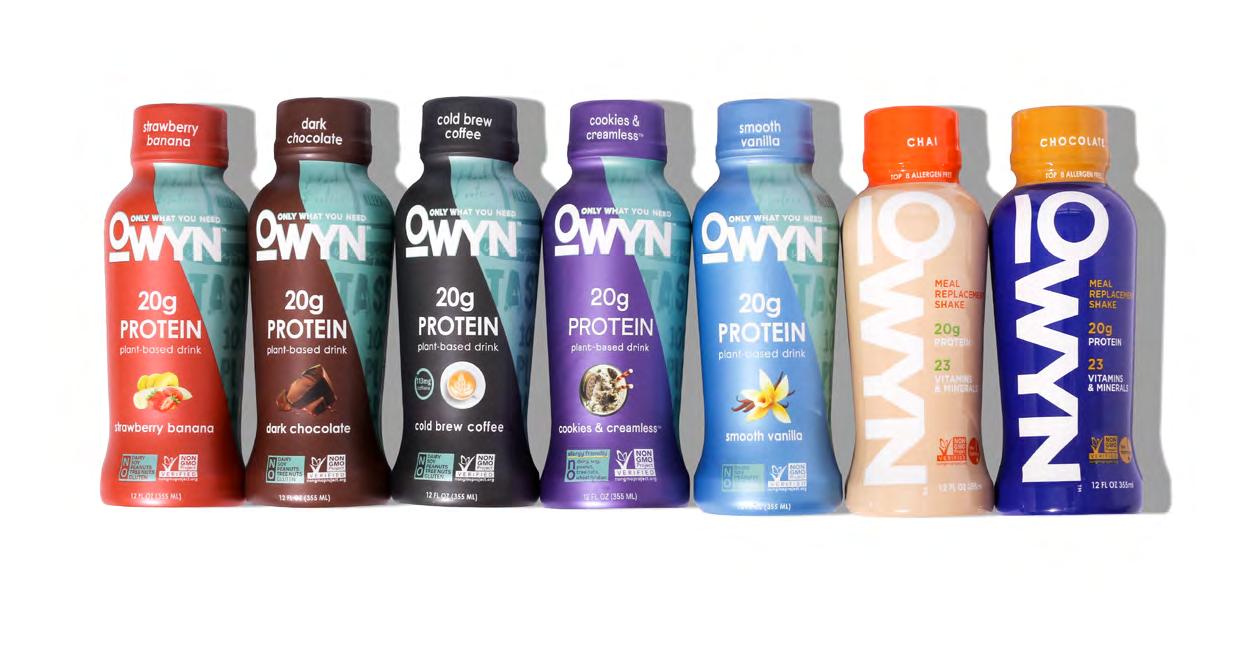


Pure, complete nutrition. Made with only the good stuff.
Science & Innovation
54 GENE EQUALIZING PRECISION MEDICINE AND BUILDING DIVERSE DATA SETS ACROSS AFRICA
 BY: CRISTINA DEPTULA
BY: CRISTINA DEPTULA
302
TROORA MAGAZINE 300

301
54 Gene
Equalizing Precision Medicine and Building
Diverse Data Sets Across Africa
PHOTOGRAPHY BY: 54GENE
WRITTEN
BY:
CRISTINA DEPTULA
4 Gene, a biotechnology company headquartered in Lagos, Nigeria and Washington D.C., is dedicated to including genomic data from African nationals into the databases used to inform precision medicine.
By doing this, they intend for the benefits of the burgeoning technology to equitably benefit Africans and all people around the world. According to their website, “We are reimagining a world where precision medicine is equalized, and everyone can live longer.”
Currently, only three percent of the data used in precision medicine research comes from residents of the African continent. Given the significant percentage of the global population who lives in or is descended from Africans, this is a serious injustice, which 54 Gene’s international team of experts wishes to correct.
54 Gene is currently focused on both noncommunicable and infectious diseases.
These include cancer, endocrine disorders, cardiovascular conditions, neurodegenerative diseases, and sickle cell disease. As for infectious diseases, they are interested in illnesses prevalent in African countr ies, including HIV, malaria, tuberculosis, hepatitis B, and Lassa fever.
BIOBANKING TO HARNESS THE PROMISE OF PERSONALIZED MEDICINE
Personalized medicine promises to improve the effectiveness of medicines and other medical treatments for each patient by observing how various groups of people respond differently to treatments. For example, if patients of African descent with a particular condition respond better to a different dosage of the appropriate medicine, doctors will know to adjust the dosage.
54 Gene is a commercial biobank, described on their site: “A commercial biobank operates solely for the purposes of collecting, curating, storing, and sharing data and biospecimens with commercial and noncommercial entities, for health or non-health related uses.”
They make money when other research entities compensate 54 Gene for their work collecting and aggregating the biological data.
They are interested in collaborating with entities (drug companies, academic institutions, and medical nonprofits) working to develop diagnostics and treatment solutions to improve human health.
“A data and sample access committee will review and make decisions about whether to provide access to data and samples based on availability and the objectives of the proposed research use.”
They have set up policies to ensure that African nationals will benefit from any research involving their
5
TROORA MAGAZINE 302

303 TROORA BLACK HISTORY ISSUE 2023
54 Gene works by “developing accurate and lower cost diagnostic tests to consider specific gene variants and frequencies in the African population, paving the way for accessible precision medicine for all.”
collected samples. In the event that they collaborate with a medical research organization and receive proceeds for providing access to data, between five to 20 percent of the profits from the research contracts will go to a foundation in each country in which the research organization operates. A committee of scientists and leaders will decide where the money goes.
Also, if they are involved with a research collaboration that leads to the co-development of a new drug, they will work with all relevant parties to provide preferential access to such drugs for nationals of all African countries.
GOALS OF 54 GENE’S PERSONALIZED MEDICINE
54 Gene’s objectives include assisting with drug discovery, molecular diagnostics, and clinical trials. Drug discovery is the process by which academic institutions and pharmaceutical companies develop new medicines. This research often starts by observing how an existing substance acts on patients’ bodies or genomes or by noticing the mechanisms by which disease progresses in the
body. Including more biological data from people of African descent will aid this process for those of African heritage and all of humanity.
Molecular diagnostics involves looking at someone’s genome to diagnose their health conditions.

54 Gene works by “developing accurate and lower cost diagnostic tests to consider specific gene variants and frequencies in the African population, paving the way for accessible precision medicine for all. We are disrupting the healthcare delivery landscape by empowering patients, healthcare providers, and payers with more accurate and meaningful data that can aid clinical decision-making and significantly improve health outcomes for all.”
Finally, 54 Gene is committed to developing costeffective, workable clinical trial solutions for patients in African nations. They do this by collaborating with local and global partners, harnessing infrastructure already on the ground throughout Africa.
They offer logistical support to partners seeking to navigate the scientific and regulatory environments of different African nations to set up and operate clinical trials.
TROORA MAGAZINE 304
ENSURING PATIENT PRIVACY
54 Gene does not retain personal information about the clients from whom they collect biological samples.
They ensure that they “manage their data in accordance with the regulations of the Data and Sample Access Committee. This is based on the terms of a fully executed Material Transfer Agreement, endorsed by the National Health Research Ethics Committee.”
In all instances, people who have contributed specimens to the 54 Gene biobank can ask 54 Gene to withdraw their samples at any time, and 54 Gene will honor those requests and destroy the specimens.
RECENT COVERAGE
54 Gene has most recently been featured in TechCrunch, Bloomberg, and Business Insider, in articles highlighting the scientific and humanitarian need for their approach to human diversity in personalized medicine.
They have also been recognized as one of the World Economic Forum’s Technology Pioneers of 2021, and their CEO, Anasi Ene-Obong, was featured in TIME Magazine in the same year.


The future looks bright for 54 Gene, and they remain committed to including African nationals and their descendants in lifesaving research into personalized medicine.
FACEBOOK.COM/54GENE TWITTER.COM/WEARE54GENE INSTAGRAM.COM/WEARE54GENE
Chief Operating Officer Delali Attiogbe Attipoe
305 TROORA BLACK HISTORY ISSUE 2023


Make Reusable the Standard
Let’s



lastobject.com
310
BRIDGE TO SUCCESS NEW PARTNERSHIP HELPS BLACK ENTREPRENEURS BY: CRISTINA DEPTULA
316
BLACK GIRL MAGIC CELEBRATING WOMEN OF COLOR EXCELLING IN VARIOUS FIELDS. BY:
GEORGE DIKE
322
BLACK HISTORY MONTH ORIGIN AND INFLUENCE IN THE BLACK AMERICAN COMMUNITY
BY: GEORGE DIKE
328
COLOR OF LOVE INSPIRATIONAL BLACK POWER COUPLES BY:
GEORGE DIKE
334
NOMADIC PRESS
SCRIBE TO THE SF BAY’S CURRENT BLACK HISTORY BY: CRISTINA DEPTULA
340
TOWARDS WAKANDA CHADWICK BOSEMAN’S PASSING AND THE POWER AND LIMITS OF AFROFUTURISM
BY: CLARE CORBOULD
344
POCHINO PRESS GROUNDED IN THE SF BAY’S BIPOC COMMUNITIES BY: CRISTINA DEPTULA
Special
TROORA MAGAZINE 308
Interest

309
Bridge to Success
New Partnership Helps Black Entrepreneurs and Marginalized Diverse Creatives Seize The American Dream
WRITTEN BY: CRISTINA DEPTULA PHOTOS COURTESY OF: TROORA MAGAZINE, ISTOCK & NATIONAL BLACK ENTREPRENEURS PROJECT
One of the pillars of the proverbial American Dream, and the dreams of many people around the world, is the chance to succeed by launching and running a business.

Entrepreneurship represents a pathway out of poverty for many people, particularly those who lack connections or the right background for traditional employment.
This pathway is particularly important for Black people in the U.S., 19.5 percent of whom were living below the poverty line in 2021, more than twice the number of other racial groups. Poverty is defined as single people earning less than $12,880 per year and families of four earning less than $26,500. The U.S. had the third highest poverty rate of all OECD (The Organization for Economic Co-operation and Development) countries in 2019, and women, children, and racial minorities were the most affected. California, the 5th largest economy in the world, had the highest number of people living below the poverty line in 2020.
Main Street’s minority owners need loans to grow, but access to capital remains inequitable. Unfortunately, underserved communities, especially Black people in the U.S., struggle to access the resources that make entrepreneurship possible. That is not for lack of effort or creativity but a result of systemic injustice.
According to the Stanford Institute for Economic Policy Research, only 1% of Black business owners could obtain loans in their founding year. Black-owned businesses get only 66% of the funding that they request from banks, compared to 80% that White-owned businesses get for the same requests. Additionally, the average loan size for small White-owned firms was over $30,000 higher than for small BIPOC-owned firms. Black Americans are turned down for loans at a rate more than double that of their White counterparts. This is even worse in the venture capital industry, particularly if you are a Black woman. Since 2009, Black women have received just 0.0006% of the total $424.7B in venture capital funds invested in tech companies. Overall, Black women receive 0.34% of all VC funding each year.
TROORA MAGAZINE 310
The fact is that Black-owned small businesses are statistically less likely to receive financing. “Lenders and VC firms do not visit or host events in marginalized communities,” points out Chris Horton, founder and executive director of the National Black Entrepreneurs Project.
Not only do many Black entrepreneurs lack helpful relationships within the business community that could provide tools, resources, and expertise, the United States’ history of discrimination has left many Black people with a mistrust of institutions outside their communities.

Horton and Cunningham plan to bring wisdom and coaching to every entrepreneur, particularly those in the Black community, as all business owners need supportive conditions to flourish. Through an exhaustive public-private collaboration of stakeholders spearheaded by Eugene “Gene” Cornelius from the Milken Institute and Trystanne Cunningham’s multifaceted media agency TrooRa Magazine, the National Black Entrepreneurs Project will build a supportive ecosystem from the ground up.
Horton, with the National Black Entrepreneurs Project, along with Cunningham, through TrooRa, will change the narrative and work to rectify hundreds of years of systemic injustice and break through barriers. Their shared goal is to build lasting generational wealth within underserved communities, especially Black communities.
SBA LENDING BY MINORITY GROUP 2006-2017

311 TROORA BLACK HISTORY ISSUE 2023
“Black people launch thousands of new businesses every year,” says Horton. “Eight out of ten of these fail, though, within the first 18 months, and these statistics are pretty much the same across industries.”
Horton points to several factors contributing to the failure of many Black-owned businesses: lack of market research, entering a field with a highly competitive landscape, lack of team chemistry, lack of positive cash flow, inability to modify the business plan in response to key market trends, taking on more business than one can handle, and poor management.
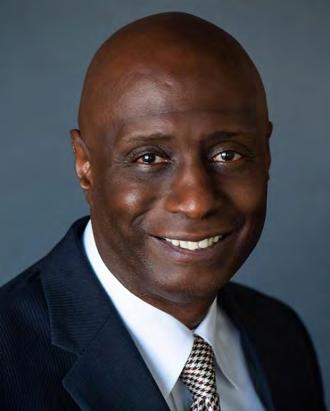

Many of these issues can be remedied through investment, coaching, and mentorship.
As Horton says, “The lack of witnessing entrepreneurship in action or having access to an entrepreneur to ask questions leaves the solopreneur out on an island without a map to navigate the choppy waters.”
Horton wishes he’d received advice and referrals at the beginning of his own entrepreneurial journey. “I wish I’d known to connect with the Chamber of Commerce, the Service Corps of Retired Executives (SCORE), and the Small Business Development Center, and to try crowdfunding.”
This supportive ecosystem, a long cherished dream for Horton and Cunningham, will advance equitable lifelong access to one-on-one advisory services covering all phases of the business lifecycle (pre-venture planning, startup, growth, maturity, and transition). The program will also help business owners find debt/equity funding, mentorship, mental health services, and financial wellness education.
“We’re going to help folks earn more money and keep more of it in their pockets,” says Horton. The partnership will also provide resources for transportation/housing, education, basic survival needs, legal problems, taxes, and emergencies.
Horton explains that many marginalized entrepreneurs don’t know some of the basic nuts and bolts of starting
a new business venture. “I’m not talking about growing, scaling, or expanding. Simply starting,” he says. These include choosing the appropriate legal structure and separating personal banking from business banking.

Entrepreneurs they serve will be able to access financial planning services and cohort business training that will support wealth creation.
“The pathway to operating a thriving business is not dependent on learning by osmosis but setting founders up with the right planning, market research, marketing, media, management, and flexibility. Through this new and desperately needed venture, Black-owned businesses will have a better chance of success,” say Horton and Cunningham.


TROORA MAGAZINE 312



EXTENDINGAHELPINGHAND.ORG MILKENINSTITUTE.ORG LINKEDIN.COM/COMPANY/THENBEP 313



wearandall.com Welcome to your new Favorite shirt
 The Digital Oxford Shirt Modern prints, gender-free fit and responsibly made from fiber to thread.
The Digital Oxford Shirt Modern prints, gender-free fit and responsibly made from fiber to thread.
Black Girl Magic
Celebrating Women of Color Excelling in Various Fields
 WRITTEN BY: GEORGE DIKE
WRITTEN BY: GEORGE DIKE
If you ever look up the term “Black Girl Magic” in the dictionary, you'll noticed it isn’t there, at least not yet. But we’re sure you’ve seen or heard the phrase plenty of times in recent years and are wondering what it means.
Black Girl Magic is a phrase used to illustrate the universal awesomeness of Black women. It is about celebrating anything particularly inspiring or mind-blowing about African American women. Black Girl Magic is about Black women expressing solidarity.
PHOTO CREDIT: CASHAWN.COM
CaShawn Thompson
TROORA MAGAZINE 316
It may currently be seen majorly online, but in reality, it embodies something that has been done for years by several Black women. That is, forming communities of support based on mutual goals, beliefs, and struggles.
“Black Girl Magic” was started by CaShawn Thompson in 2013 when she launched the movement #BlackGirlsAreMagic, which has since been shortened and popularized to #BlackGirlMagic. It celebrated Black women’s beauty, power, and resilience. In a think piece for Black History Untold, CaShawn talks about Gloria Richardson, a civil rights worker and warrior, as her main inspiration behind the movement. Gloria was an embodiment of Black civil rights drive and power throughout her lifetime. That fighting spirit was duly portrayed in a photo of her in Maryland, shoving a bayonet at a protest.
CaShawn notes that that particular image motivated her to start a woman-led revolution. And then, the #BlackGirlMagic movement was born. She used digital activism with the help of social media to celebrate Black history and Black women in ways that had never been done. Today we raise our glasses in a toast to Gloria, CaShawn, and all of the beautiful Black women who have made their mark on the world.
“Black Girl Magic” has drawn criticism from outside and within the African American community. Essence Magazine once published a special edition highlighting “Black Girl Magic.” It featured three prominent Black women on its covers: actresses Teyonah Parris, Yara Shahidi, and one of the “Black
Lives Matter” movement leaders, Johnetta Elzie. They all spoke favorably about the phrase.

A few days after, Elle Magazine ran an article by Linda Chavers entitled: “Here’s my problem with Black Girl Magic. Black girls aren’t magical. We’re human.” She argued that the phrase holds Black women to unfeasibly high standards by celebrating them when they achieve but criticizing them when they don’t. However, this argument has been dismissed by most African American women. Phrases like #beingaBlackgirlislit, #blackgirlmagic, and #melaninpopping are still being used by Black women among each other to affirm their beauty and intellectual prowess by unapologetically celebrating every inch of themselves and each other.
February marks Black History Month, and as we celebrate Black women every day, we are encouraged to promote and celebrate #BlackGirlMagic, around the country and around the globe too. We remember all of the remarkable Black Women of the past and raise a glass to the queens of the present. Through the #BlackGirlMagic movement, a foundation for positivity and empowerment is set for women of color worldwide.
While pioneers like Madame CJ Walker, Dorothy Dandridge, Hattie McDaniel, Shirley Chisholm, and countless others laid the foundation, plenty of women are also breaking barriers today. Black women make history daily in education, politics, music, sports, and film. Here’s a look at some of them who have made history with some “firsts” in recent years.
Gloria Richardson
317
PHOTO CREDIT: BLACK HISTORY
UNTOLD
Tamron Hall - In 2014, Tamron Hall became the first Black woman to co-anchor The Today Show.
Paulette Brown - In 2015, she became the first African American female American Bar Association president.
Lupita Nyong’o - First Black spokesperson for Lancome.
Carla D. Hayden - First Black Librarian of Congress.
Halle Berry - First Black woman to win an Oscar for best actress.
Maritza Correia - Is the First Black woman to earn a place on the U.S. Olympic swim team.
Misty Copeland - First Black performer appointed principal dancer for the American Ballet Theater.
Michelle Obama - First Black woman to become First Lady of the United States.
Ava DuVernay - First Black female director to receive a Golden Globe Award.
Loretta Lynch - First Black female United States Attorney General.
Mia Love - In 2017, she became the first Black female Republican elected to Congress.
Rihanna - First Black woman to be the face of Dior.
Shonda Rhimes - The first Black woman to create and executive produce a top 10 network series.
Gabrielle Douglas - First Black woman to become individual all-around Olympic champion.
Simone Biles - First Black all-around world champion.
Nikuyah Walker - Became the first Black woman mayor of Charlottesville, VA.
LaToya Cantrell - She is the first Black woman to be elected mayor of New Orleans.
Tonya Boyd - She is the first Black woman to be named Deputy Chief of the NYC Fire Department.
Lena Waithe - In 2017, Lena became the first Black woman to win an Emmy for comedy writing.
Beyonce Knowles-Carter - First African American woman to headline Coachella, giving rise to the nickname Beychella. Also, the first artist ever to have six albums debut at Number 1 on the Billboard charts.
Oprah - In 2018, Oprah became the first Black woman to receive the prestigious Golden Globe Cecil B. DeMille Award.


Lorna Mahlock - First African American woman U.S. Marine Corps general officer, in 2018.
Stacey Abrams - First African American woman to be a major party nominee for State Governor.
Kamala Harris - In 2020, Kamala became the first African American Vice President.
TROORA MAGAZINE 318
PHOTO CREDIT: SIERRA KODER
Undoubtedly, Black women have pushed beyond all barriers to provide us with excellence in various fields.
For us, Black Girl Magic is more than a phrase. It’s a feeling, a look, a mood. The term embodies all that the African American woman is, breaking the rules and changing stereotypes.
This reminds all the Black women in our society that you will always bring magic to every occasion. So, Be Trooly You!

319 TROORA BLACK HISTORY ISSUE 2023
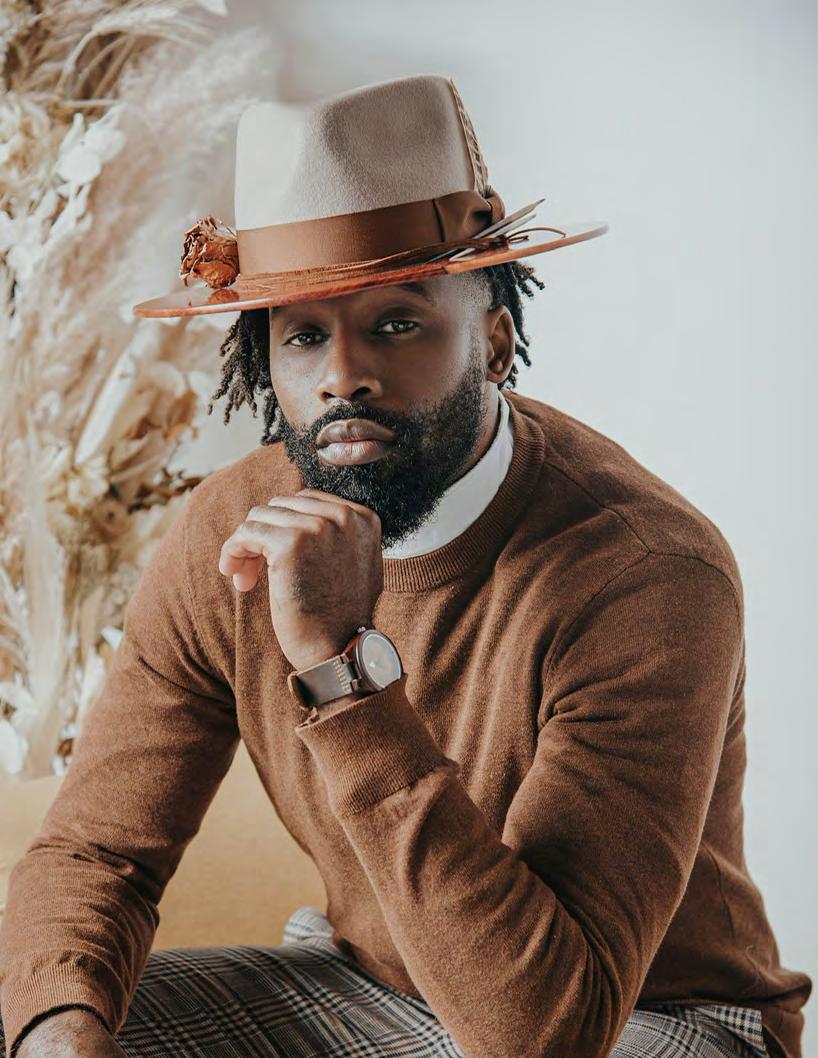
dapperrenaissance.com


FINE WOOD BRIM HEADWEAR & APPAREL
A revival of sophistication, elegance and confidence in the style of dress.
Black History Month Origin and Influence in the Black American Community
 WRITTEN BY: GEORGE DIKE
WRITTEN BY: GEORGE DIKE
February 1st marks the first day of Black History Month in the United States. Every year, Americans set aside this month to reflect on African Americans’ accomplishments in the United States. Black History Month celebrates African American achievements and an opportunity to recognize their significant role in American history.
The celebration, also known as African American History Month, evolved from “Negro History Week,” created by acclaimed historian Carter G. Woodson and other prominent African Americans.
Since the inaugural Negro History Week in 1926, other countries, including Canada, the United Kingdom, Germany, and the Netherlands, have joined the United States in honoring Black people and their contributions to history and culture.
THE ORIGIN OF BLACK HISTORY MONTH
Carter G. Woodson ignited the movement of Black History Month. Woodson was born to former slave parents. He spent his childhood working in Kentucky coal mines until enrolling in high school at twenty. He graduated in two years and eventually earned a Ph.D. from Harvard.
In his research, Carter G. Woodson was horrified to discover that history books mainly neglected the Black American population. These books only talked about African Americans in ways that reinforced the lower social status they were assigned at the time.
Due to the public’s lack of knowledge of Black people’s achievements, historian Carter G. Woodson co-founded the Association for the Study of Negro Life and History in 1915. In 1926, the Association for the Study of Negro Life and History named the second week of February “Negro History Week” to honor African Americans’ contributions to American history.
TROORA MAGAZINE 322
The week was selected because it coincides with the birthdays of Frederick Douglass, an abolitionist, and former United States President Abraham Lincoln. The response to this was overwhelming as Black history clubs sprang up; teachers demanded materials to teach their pupils, and progressives and philanthropists stepped forward to endorse the effort.
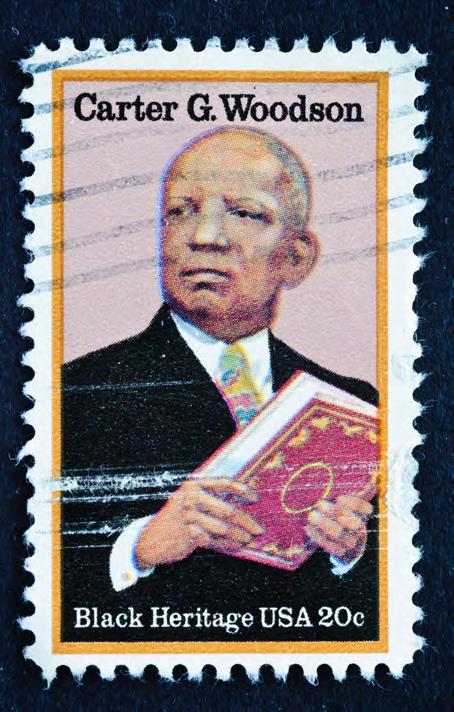
In 1976, President Gerald Ford declared February Black History Month to “celebrate the too-often overlooked contributions of Black Americans in every field of effort throughout our history.” This was fifty years after the first celebration. Since then, February has been designated Black History Month in the United States. Initially, Black History Month was intended to educate school children and young people about the accomplishments of African Americans and other minorities because that history had mainly been forgotten. Yet, it became an essential part of the national story. It is now considered a celebration of those who have touched the country and the world with their activism and achievements. The month-long focus in February in the United States is a time for people to connect with Black histories, go beyond racism and slavery, and celebrate Black leaders and achievements.
Some critics of Black History Month say that dedicating a whole month to a single race group is unjust. Others argue that we should commemorate Black History every day of the year because setting aside just one month allows people to ignore the past for the remaining 11 months.

323
WHAT IS THE ESSENCE OF BLACK HISTORY MONTH?
It is a time to honor the historic leaders of the Black community and highlight the best of Black history. The unpleasant parts of African American culture and communities are frequently discussed, like poverty, jail, high school dropout rates, images of rowdy athletes, and raunchy reality TV personalities modeled as Black success. Therefore, Black History Month allows us to focus on the many positive strides of African-Americans. For instance, African American Women continue to thrive in business and entrepreneurship despite many challenges. These heroes deserve to be celebrated for their bravery and contribution to the Black community. Their sacrifices and suffering played a massive part in achieving racial equality. Other important reasons why we mark and celebrate Black History Month is because:
It Helps Create Awareness
Unfortunately, Black History is frequently lost in time and current discussions. When we commemorate Black History Month, it gives people of all races the chance to learn about the past and people they are wrong about. This helps to reeducate and eliminate some stereotypes about the Black community.
It Reminds Us All That Black History is OUR History
People are wrong to dismiss Black History Month since Black History (like Hispanic, Asian, European, and Native History) belongs to all black and white men and women, young and old. The contribution of African Americans to our country is ingrained in our collective memory. When celebrating Black History, we all become mindful of our country’s tremendous and diversified history.
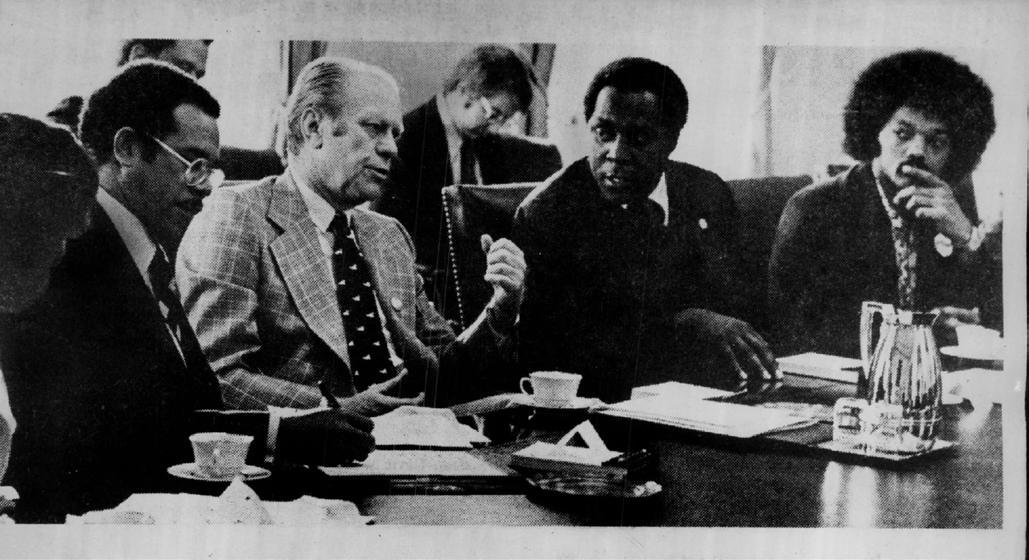
Black History Month started to bring attention to African Americans’ achievements in the United States. Today, it pays tribute to all Black people in the United States, from the earliest enslaved people from Africa in the early 17th century to today’s African Americans. Among the notable figures often highlighted during Black History Month are:
• Madam C.J. Walker, the first self-made female millionaire in the United States
• Dr. Martin Luther King, Jr., who fought for equal rights for African Americans during the 1950s and 1960s
• Thurgood Marshall, the first African American justice appointed to the United States Supreme Court in 1967
• Phyllis Wheatley, the first African American poet and woman to publish a book
• Mae Jemison, the first female African American astronaut to travel to space in 1992
• Barack Obama was elected the first-ever African American president of the United States in 2106… …and a host of other key figures from the Black community. Black History Month encourages everyone to focus on and celebrate the greatest of African American achievements.
TROORA MAGAZINE 324
BLACK HISTORY MONTH 2023
The Association for the Study of African American Life and History (ASALH), an organization committed to investigating and publicizing achievements by Black Americans and other peoples of African heritage, selects the topic for Black History Month each year.

The theme for 2023 Black History Month is “Black Resistance.” It examines how African Americans have resisted oppression since the country’s early days. From leaving the plantation to overcoming poverty and fighting for equitable access to housing, education, and voting rights, the resistance continues into the twenty-first century,
No history of the United States of America can be regarded as a true story unless it includes the contributions of people of color. Every racial group, including African Americans, played in our country’s democracy today can not be forgotten. African Americans continue to thrive in every aspect of America’s socio-economy, including sports, tech, medicine, politics, and all other fields.

Legalized slavery and segregation marred much of the first two centuries of the American story. Despite obstacles like poverty, racial prejudice, inequality, and brutal suppression, the Black community contributed greatly to the country’s growth in political, artistic, athletic, scientific, and all aspects.
As we celebrate Black history, let us all reflect on these incredible accomplishments achieved by African Americans and play our part in spreading awareness of the importance of our Black community.
325 TROORA BLACK HISTORY ISSUE 2023




buttahskin.com
Color of Love Inspirational Black Power Couples
 WRITTEN BY: GEORGE DIKE
WRITTEN BY: GEORGE DIKE
February is Black History Month. It is also the month of love, and what better way to celebrate both occasions than to remember and honor our Black couples who are leading examples for couples to follow. First, we celebrate Black Power couples who have shown the importance of love and togetherness in fighting for justice and equality.
These couples have contributed to the Black community, and their legacy lives in today’s society. From Raymond and Rosa Parks to Martin Luther and Coretta Scott King, here are our top 3 Black Couples who helped shape the History of African Americans.
Raymond and Rosa Parks
On December 18, 1932, Raymond Parks married Rosa McCauley. Rosa Parks was arrested on December 1, 1955, in Montgomery, Alabama, for refusing to give her seat to a white male passenger on a segregated bus upon the bus driver’s demands.
Four days later, on December 5, the Montgomery Bus Boycott began and lasted 381 days. Mrs. Parks’ courage catapulted her into world history, where she is affectionately referenced as the “Mother of the Modern-Day Civil Rights Movement.”
Raymond Parks backed his wife’s fight against inequality. They urged young people to seek a high education to support themselves and their families and end prejudice in the United States. Mrs. Rosa Parks co-founded the Rosa and Raymond Parks Institute for Self-Development in February 1987 in honor of Raymond Parks (1903–1977). It is the legacy of two people who dedicated their lives to advancing civil and human rights.
328
Betty Shabazz and Malcolm X

Malcolm X and Dr. Betty Shabazz were committed to raising the political awareness of African Americans by whatever means necessary as the Nation’s most conspicuous proponents of Black Nationalism. Malcolm X was an important symbol of the Nation of Islam even before he married Betty in 1958.
He posed a challenge to the mainstream civil rights movement and Martin Luther King, Jr.’s peaceful goal of integration. By 1960, the Nation of Islam had grown from 400 members to 40,000 members, thanks mainly to his efforts. In 1964, Malcolm publicly quit the Nation and traveled to Mecca, where he was incredibly impressed. Upon his return, he created the Organization of Afro-American Unity, a pro-Black identity organization.

Malcolm X was slain before his pregnant wife, Betty, and their four children. This was while speaking at a rally in New York City on February 21, 1965, one week after his home was firebombed. Betty raised six children on her own after Malcolm’s death, earned a Ph.D. in education, continued to promote his memory by publishing his speeches, writings, and likeness, and had a successful career at Medgar Evers College.
Some Black couples have become iconic symbols of love, family, and Black power in our present-day pop culture. As we look to the past for guidance, we celebrate these present couples leading in the 21st century. They prove to the world that love can still be pure, genuine, and long-lasting. Here are our top three:
Coretta Scott King and Dr. Martin Luther King Jr. MLK and Coretta Scott King are undoubtedly the most well-known figures in the Civil Rights Movement. They dedicated their lives to human rights advocacy and action. Married in 1953, they had four children who left active legacies of their own. While Dr. King took the lead, Coretta made it apparent that she was more than a wife; she was a partner and worked with her husband at every turn. Even after his killing, Coretta exhibited the power of love by establishing a national holiday in his honor, constructing the Martin Luther King Center in Atlanta, and fighting for universal human rights until her death in 2006.
Martin and Coretta King
329 TROORA BLACK HISTORY ISSUE 2023
Betty Shabazz and Malcolm X
The couple made history when they became the first Black president and first lady of the United States. Since they left the White House, they’ve created a multi-media empire that includes Netflix shows, books, and speaking arrangements. The former President and First Lady were a power couple even before they entered the White House. Still, now that they’ve returned to public life, we’ve only learned more reasons to love them.

They met in Chicago, married in 1992, and forged a longlasting love as they pursued their dreams. They can always be seen in each other’s embrace, holding hands. They serve as a shining example of what true love can be.
She’s the most powerful woman in music and the greatest living entertainer. He is considered by many to be the greatest rapper alive and a successful businessman. These superstars have dominated the music industry for over a decade. Some argue that they’re the closest thing to royalty in America.
Unlike many couples who founded businesses together, Beyonce and Jay-Z individually had flourishing careers long before tying the knot. Beyoncé first captured the public’s eye as the lead vocalist of the R&B group Destiny’s Child. She later established a solo career, becoming one of music’s topselling artists with sold-out tours, endorsement deals, and a slew of awards.
Initially unable to get a record deal, Jay-Z co-founded RocA-Fella Records. From there, he released seven platinum albums before launching Roc-A-Wear apparel and the 40/40
Barack and Michelle Obama
Barack and Michelle Obama
Jay-Z and Beyoncé
TROORA MAGAZINE 330
club. Married in 2008, the “dangerously in love couple” is among the most influential and wealthiest from charttopping albums, sold-out tours, and multiple ventures.

Oprah Winfrey and Stedman Graham
We all know Oprah Winfrey as one of the few Black woman billionaires on this Earth. She and her partner, Stedman Graham, have never married, and Oprah is unapologetic about her desire to remain unwed.
However, Stedman has no problem letting Oprah be herself, not just his woman. This partnership is a beautiful example of how men can and should show up for women, even if they’re as successful and self-sufficient as Oprah.
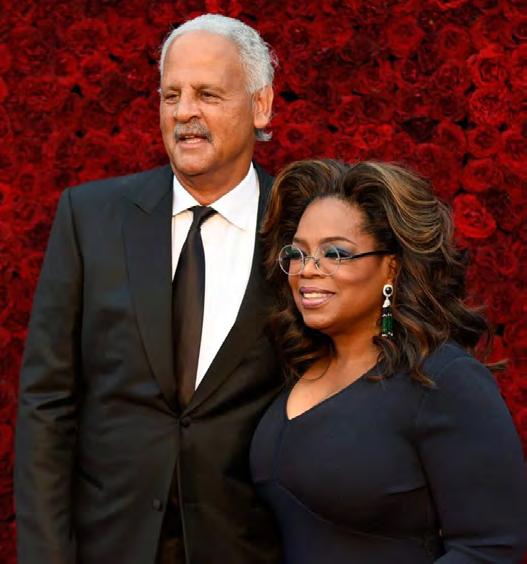
We’re celebrating Black History Month by paying tribute to African American couples that epitomize true love. These couples and a host of others have kept love alive through the ups and downs of their jobs and lives, and we commend them for it.
There are no ideal relationships, but these Black power couples inspire us to think anything is possible. These relationships are about more than love and picture-perfect shots. They show that an ideal relationship, like everything else, requires effort and a strong will to see it through.
Jay-Z and Beyoncé
331 TROORA BLACK HISTORY ISSUE 2023
Oprah Winfrey and Stedman Graham



lunelvintage.com

Renewing glasses into sunglasses
Nomadic Press: Scribe to the SF Bay’s Current Black History
omadic Press, headquartered in Oakland and Philadelphia, is determined to harness its limited resources to serve communities of color and amplify their voices.

They recently won the Community of Literary Magazines and Presses (CLMP)’s 10K Constellation Award, a national recognition for presses that champion the writing of people of color.
Nomadic Press founder J.K. Fowler introduces the press and their mission, “Through publications, events, and active
N
PHOTOGRAPHED BY: NOMADIC PRESS
TROORA MAGAZINE 334
WRITTEN BY: CRISTINA DEPTULA
community participation, Nomadic Press collectively weaves together platforms for intentionally marginalized voices to take their rightful place within the world of the written and spoken word. Through our limited means, we are simply attempting to help right the centuries-old violence and silencing that should never have occurred in the first place and build alliances and community partnerships with others who share a collective vision for a future far better than today.”
WORKS AND FUNDS REFLECTING THEIR MISSION
One Nomadic Press collection in line with their mission, Painting the Streets: Oakland Uprising in the Time of Rebellion, focuses on murals that appeared on the streets of Oakland, CA during the 2020 struggle for racial justice. The book includes interviews, poetry, and essays from various writers active during the Black liberation struggle.
Activist Angela Davis praises Painting the Streets: “Oakland is a city of artists and of people who appreciate the vital role of art in accelerating social change. Painting the Streets is an enduring reminder that we caught sight of the future in the murals and art that radically transformed Oakland during the protests in the summer of 2020.”
Nomadic Press has also set up a special fund to benefit its Black writers, and $1 from each sale of Painting the Streets will go into that fund. The rest of the proceeds from the title go towards a fund for visual arts programs in schools in Oakland’s flatlands (the lower-income areas in which more BIPOC community members live).
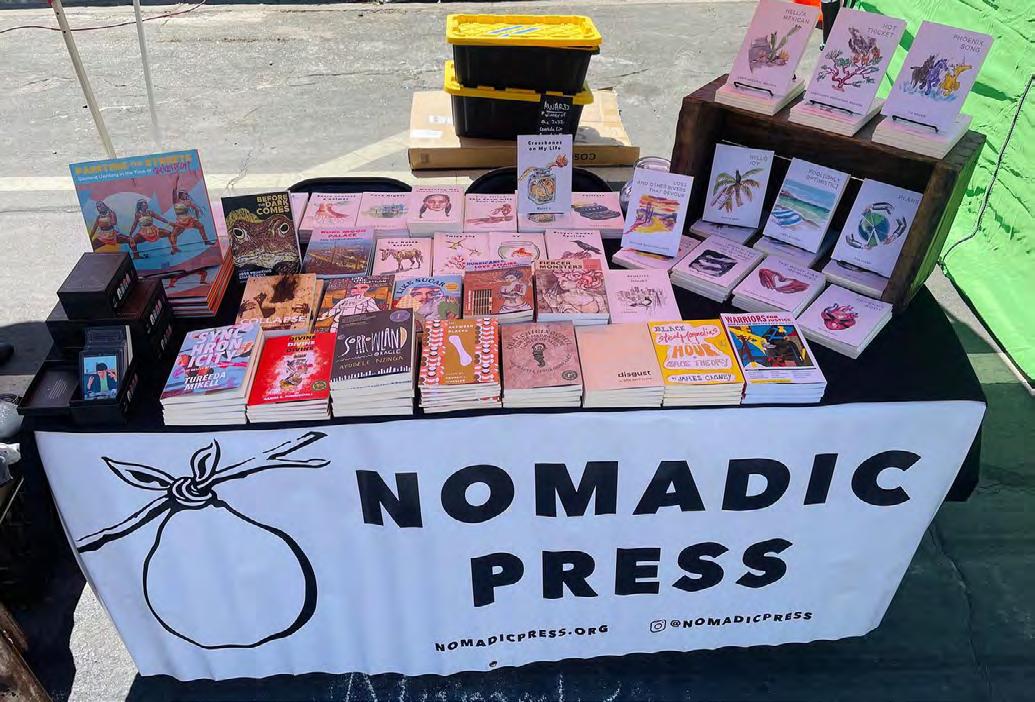
The press has a variety of funds for various purposes, to which people who attend their literary events or buy their books can donate. In addition to the funds for Black writers and for local arts education, there is one to support any of the writers they have published or any of their contractors who find themselves in need of assistance, and another to help fund the travel of any Nomadic Press author to their recently established retreat center in Xalapa, Veracruz, Mexico.
They are currently working on establishing a cafebreria—a combined coffee shop and bookstore, complete with a firepit— at the retreat center.
AN INVITATION TO THE LITERARY COMMUNITY
Nomadic Press finds the word “submission” inauthentic and claims that inviting authors who desire publication to “submit” to them grates against their values. So, instead, they encourage writers to “invite” the press to publish their work each year from January to February.
“Any way you cut it, the word ‘submit’ grates against who we are and what we stand for. It feels inauthentic to continue to use this word. We want to instead offer that this is a process of sending us an invitation—an invitation into a relationship, an invitation to work together, an invitation to experience your art with you, an invitation into a space most sacred. We may accept this invitation. We may decline this invitation. Regardless, we are grateful. It is truly an honor to receive an invitation. So we want to simply pause and thank you for considering our press.”
335 TROORA BLACK HISTORY ISSUE 2023
They also extend gracious words to those they will publish and to those they will inevitably have to decline.
“Our reality is that we must decline the invitations of many, some of whom we know and see at community events regularly. This is difficult. We know it is also difficult to receive declines to any invitation. We know this because we, too, are writers and receive numerous declines.
A declined invitation may mean it is simply not the right time. It may mean that your work simply does not fit within the scope of what the press hopes to accomplish in that given year. It may mean any number of incalculable things. We want to offer some advice that can, of course, be freely disregarded: try to send your invitation without expectation or attachment to whether or not the invitation is accepted or declined. There is immense power and beauty in simply extending the invitation. Everything
else is so often outside of our control. Resilience is innate.” As for general advice about what they publish, general manager J.K. Fowler suggests, “Folks ask what we look for in our writers. Authenticity. Alignment with core. Writing that aims to further connection. Commitment to community engagement, to something larger than ourselves. A desire to work toward change on a personal level and in our communities.”
Notable Black authors published through Nomadic Press include accomplished poet and flautist Yeva Johnson (Analog Poet Blues), Oakland’s first poet laureate Ayodele Nzinga (Sorrowland Oracle), famed poet and musician Norm Mattox (Black Calculus), and artist and poet James Cagney (Martian: The Saint of Loneliness), poet and activist Dee Allen (Plans) and notable spiritual writer Tureeda Mikell (Synchronicity: The Oracle of Sun Medicine).

TROORA MAGAZINE 336
CURRENT AND UPCOMING NOTABLE NOMADIC PROJECTS
Other ventures of Nomadic Press include Nomadic Coffee, a collaboration with Thomas Landry’s Nomadic Coffee Roasters, in which poetry from Nomadic Press authors is printed and included within bags of organic coffee.
Nomadic Coffee is available on the Nomadic Press website and at various writing conferences, including the major annual academic gathering, the Association of Writing Programs.
The press also hosts public open mics for poets and prose writers every Friday at 6 pm Pacific time. These started during Covid and have been a way for editors to meet talented writers from around the world and connect with these people over Zoom.
Nomadic Press is also in the process of working with Parcel Projects to provide programming for a development in Oakland, CA on central Telegraph St, a seven-story building that will include several floors of affordable housing, with more than half the units set aside for transitional-age youth (people beginning their careers, who may have aged out of foster care). They will host programming, literary, and cultural events on the first two floors.
According to the Parcel Projects site, “2301 Telegraph is part of an ongoing investigation into the ways in which architecture can be utilized to encourage cultural expression, collaboration, economic opportunity, and justice, as well as promote access to resources, re-connection and empower those who have been severed from opportunity. The project is intended to support a more equitable urban environment, given concrete expression by the experience and stories of those who inhabit it.
We are excited about the potential of this project to serve as a model for new thinking about community-based design processes and see the building itself as a test site to explore innovative ideas about programming and engaging neighborhood networks...a counterpoint and an example of how and for whom to build in cities like Oakland now.”
Nomadic Press also sponsors a program, Pass the Mic, teaching young people (teens and college students) how to organize cultural events. In addition, they perform at a peace and justice festival in Oakland, participate in a “mixtape” event called Bay to Brooklyn that connects cultural creatives on both coasts, and open up their Oakland office space to organizations and literary series that they believe reflect their mission to amplify underrepresented creative voices.
EXPANSIVE FUTURE FOR NOMADIC PRESS
Nomadic Press currently has nodes in Philadelphia, Pennsylvania, Des Moines, Iowa, and Brooklyn, New York. They are determined to serve writers of color and other people under-represented in the literary ecosystem in Oakland, CA and around the world.

@NOMADICPRESS
337 TROORA BLACK HISTORY ISSUE 2023


The first device to hack your metabolism
The first device to hack your metabolism



Enhance fat burn, lose weight & boost energy naturally
Enhance fat burn, lose weight & boost energy naturally
lumen.me
lumen.me
Towards Wakanda Towards Wakanda
Chadwick Boseman’s Passing and The Power and Limits of Afrofuturism
If you’re not a comics fan, you may have been surprised at the extent of the heartfelt grief expressed following the death of actor Chadwick Boseman.
One explanation lies in the extraordinary power of the 2018 movie Black Panther, in which Boseman starred as T’Challa/Black Panther, to address racist stereotypes about Africa and Africans.

Boseman’s character was heir to the hidden kingdom of Wakanda, a mythical African nation free of European colonization. The film’s subtext explores African Americans’ varying identifications, past and present, with Africa and a global Black diaspora.
DARK CONTINENT
Westerners’ ideas about Africa are steeped in myth. The United States, wrote German philosopher Georg Hegel in 1830, was “the land of the future.” Africa, by contrast, was “the land of childhood” where history was meaningless. European powers dubbed it the “Dark Continent,” as if its people could never make progress.
Fields of science emerged to classify human beings, relying on simplistic notions of evolution and psychology. They all agreed “black” people inhabited the ladder’s bottom rung.
“We must find a way to look after one another … as if we were one single tribe.”
PHOTO CREDIT: ELSA YOUNG/ BUREAUX WRITTEN BY: CLARE CORBOULD
TROORA MAGAZINE 340
IMAGE CREDIT: WAKANDA MOVIE IMDB. CHADWICK BOSEMAN.
These (pseudo) scientific and cultural stereotypes underpinned colonization. They served Western extraction of Africa’s natural resources, enslavement of Africans and of their descendants all over the Americas.
BREAKING CHAINS AND FORGING LINKS
Such ideas meant that when Black Americans broke slavery’s chains, starting in the 1820s in northern US states and ending in 1865, it was not straightforward to claim African allegiance. The Atlantic and internal slave trades had devastated ties between families and communities on either side of the Atlantic Ocean.
Black Americans had, instead, forged ties between themselves in the United States. This meant few people (roughly 12,000) were keen to migrate to Liberia, established by the American Colonization Society in 1816.
Read more: From Louisiana to Queensland: how American slave owners started again in Australia
By the 1920s, with memories of enslavement and the preservation of older people, Black Americans began once again to forge links to Africa. Marcus Garvey’s Universal Negro Improvement Association suggested a global Black United States of Africa. When Italy invaded Ethiopia in 1935, African Americans were incensed.
In the 1960s–70s era of Black Power, accelerated by film and television, ties to Africa became more prominent again.
Activists changed their names: Stokely Carmichael became Kwame Ture; Cassius Clay chose Muhammad Ali; and JoAnne Byron’s rebirth was as Assata Shakur. More widespread was the adoption of dashikis and “natural” hairstyles.
Interest in Africa spiked dramatically with Alex Haley’s Roots: the Saga of an American Family. The book (1976) and the miniseries (1977) told the story of Haley’s “furthest-back ancestor,” Kunta Kinte, and his generations of American descendants.
In more recent decades, Black American tourism to Africa has soared as people seek out their own roots.
Read more: Growing Up African in Australia: racism, resilience and the right to belong
A DIFFERENT WORLD
In Black Panther, Chadwick Boseman – along with a host of other wonderful actors, and director and screenwriters Ryan Coogler and Joe Robert Cole – brought to life a “splendidly black” utopian vision. The film, which reverses stereotypes about Africa, delighted many African American fans.
In Wakanda, the fictional metal vibranium is the bedrock of a society in which wealth is distributed so justly that both men and women thrive and King T’Challa can stroll the city streets unnoticed.
Vibranium represents the resources of the 54 countries of Africa, whose extraction has not, on the whole, benefited Africans. It is mahogany, ivory, rubber, diamonds, salt, gold, copper, and uranium.
Black Panther draws on an artistic movement known as Afrofuturism, in which knowledge about past violence and injustice inform an imagined future built on equality. Afrofuturists have included novelists Sutton E. Griggs and George Schuyler in the early days, and later Octavia Butler, Samuel Delaney, and Ishmael Reed, and now N. K. Jemisin and Colson Whitehead.
Afrofuturist musicians include Sun Ra, George Clinton and P-Funk, and recently Janelle Monáe.
BLACK IS KING
Beyoncé’s new visual album, Black Is King, also draws on the Afrofuturist tradition.
It has been criticized for prioritizing aesthetics over politics. In particular, Beyoncé’s effort to reclaim colonial stereotypes linking Africans to flora and fauna by donning couture animal prints has drawn mixed responses.
Dedicated to her son, Black Is King falls into a long tradition of romanticizing Black ancestors as kings and queens. Criticizing this tendency, historian Clarence Walker has asked: “If Everybody Was a King, Who Built the Pyramids?”
But kingship is also a metaphor for the power of history, properly told. “History is your future,” Beyoncé tells the film’s young king. An exchange following the track "Brown Skin Girl" starts with a male voice saying, “Systematically, we’ve had so much taken from us”. A second voice responds:
Being a king is taking what’s yours. But not just for selfish reasons, but to actually build up your community.
King T’Challa comes to the same realization and at the end of Black Panther, we see him leave his tech-whiz sister at the helm of a new Wakandan outreach center in Oakland, California.
In both Black Is King and Black Panther, global connections underpin a reimagined future universe – a marvelous one, even – where disadvantage and injustice stemming from racism are overcome. Wakanda forever.
This article is republished from The Conversation under a Creative Commons license. Read the original article.
341
“We must find a way to look after one another … as if we were one single tribe.”



alicebow.com
Beautiful shoes should be confortable too

Pochino Press: Grounded in the SF Bay’s BIPOC Communities
 PHOTOGRAPHED BY: POCHINO PRESS
WRITTEN BY: CRISTINA DEPTULA
PHOTOGRAPHED BY: POCHINO PRESS
WRITTEN BY: CRISTINA DEPTULA
The mission of Pochino Press is to publish works that illuminate stories from the intersections where hybrid cultures meet.
Based in the San Francisco Bay Area, they focus on building and connecting communities of color, locally and internationally, through the works they choose to publish.
Their publications include collaborative art books with an Emmy Award-winning painter, a vegan Persian cookbook, a collection of short stories, fiction set in San Francisco’s Mission District, art by an East Oakland tattoo artist, and a look at Chicano hip-hop in Taiwan.
As professor and community educator, and press cofounder, Daniel Zarazua, explains, “We don’t publish for the sake of publishing, but rather, each work is seen as an opportunity to create another platform for people who’ve been historically silenced and to bring together communities who might not ordinarily share space.”
Zarazua says that Pochino’s writers and artists challenge assumptions around identity, often drawing from multiple communities to create new perspectives and storylines. This includes people who identify as multi-racial or third culture (raised in a culture different from that of their parents.)
“I’d add that all three of our founders are people of color, two of whom are women (Xiomara Castro and Daniel’s wife, Monica Zarazua). Our lived experiences differ greatly
TROORA MAGAZINE 344
from most people we’ve met in the publishing world. Collectively, we also have dozens of years of work in education and youth development, so view publishing as an extension of our community work,” he points out.
REFLECTING THE LOCAL BIPOC COMMUNITIES
Pochino Press aims to have every aspect of their business reflect their local community, which is primarily Black, Indigenous, People of Color (BIPOC). This includes whom they publish and hire, where they hold their events, and the vendors with whom they collaborate.

“We do our best to make our events attractive to our community, which is incredibly diverse. This includes people from all backgrounds who don’t see themselves as readers and don’t ordinarily visit bookstores. In addition to the places you would typically expect to find book lovers, such as book fairs, we’ve done events at a local fashion store, have an ongoing open mic series with a Blackowned barbershop, have partnered with high schools for writing workshops, and prioritize relationships with library branches directly serving our community,” says Zarazua.
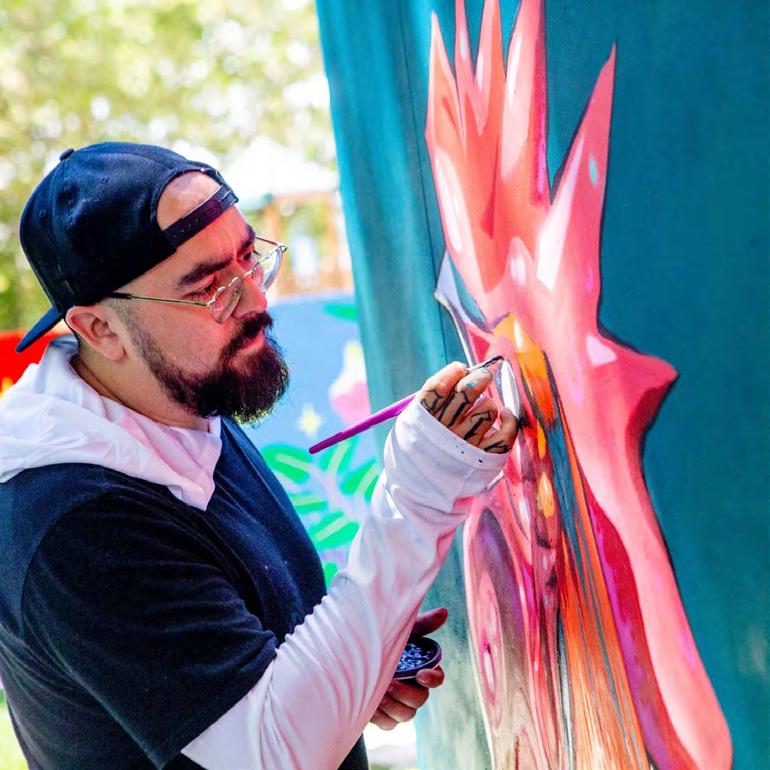
Some publishers say they would love to publish more writers of color, but either don’t receive enough submissions from BIPOC writers or don’t think they can successfully market books about the BIPOC experience to their customer base. Zarazua says that if you want more submissions from writers of diverse backgrounds, you need to pay attention to how you interact with diverse communities and how you present yourself. This has always been a goal of Pochino Press.
In terms of their customer base, Pochino acknowledges there’s always a financial reality to consider. They quickly saw that marketing some of the books they were excited to publish would be a challenge.
“There are works that we’ve loved and published, knowing there was little to no financial reward, but that’s not sustainable. A pivot we did was to become a non-profit so we could apply for grants, giving us more freedom to focus on the work and not worry as much about sales,” Zarazua says.
345
COLLABORATION WITH AUTHORS
Pochino Press focuses on working with authors and developing personal creative relationships that are not merely transactional.
“Writers, artists, and readers can read that energy. In some ways, just treating people with basic respect has been key to our success, but I certainly don’t want to minimize people coming to a place where they hear people talking in familiar ways and other cultural markers that make people feel at home,” says Zarazua. The press collaborates as much as possible with the writers and artists on small details and larger matters, from choosing paper types for the books to planning release parties. They say the personalized approach and the agency the authors have while working with Pochino Press helps them to attract writers and artists with impressive histories as a small press.

Cornelius Harris, contributing writer and manager for the Underground Resistance record label, says, “I’d say it begins with relationships, that we’ve known you for over 20 years now, and the work that everyone at Pochino has done previously is impressive and inspiring. But beyond that, an independent press is a place where new and different ideas can be codified and shared in a unique way. Pochino has demonstrated this in their prior work, but more directly, through Daniel Zarazua, what we do with Pochino is much more collaborative than what would happen anywhere else.”
CONSCIOUS, DATADRIVEN EXPANSION AND DEI
In terms of internal diversity, equity, and inclusion (DEI) initiatives among their management and staff, they have recently started looking more broadly at their hiring procedures. They initially relied on personal referrals and connections to bring people aboard and are now seeking new revenue streams to fund conscious growth.
“DEI is central to our personal and professional lives, so we look at both qualitative and quantitative data to see what we’re doing well and where we need to grow,” says Zarazua. These initiatives began before George Floyd’s murder and the resurgence of the Black Lives Matter movement. Zarazua explains that while the murder received well-justified attention, Pochino Press’s founders and affiliates are from communities where these issues are nothing new.
“In our day jobs, we’re all veteran educators and activists as it was drilled into us from a young age to get involved in our communities, including challenging institutionalized inequities. Our team’s impetus for founding the press is rooted in both the traumas and organized struggle we learned about and experienced in our day-to-day lives,” says Zarazua.
Pochino Press scaled back its business in 2020, doing fewer publications and events to strengthen its business model and practices.
“We want to have a strong enough financial model that we’re tangibly impacting our communities by contributing to the economic ecosystem in a meaningful way. We hope our work helps address the conditions that led to George Floyd’s murder and that of others like him,” says Zarazua.
One way they have recently pivoted is by refocusing on Bay Area writers. “Aside from anthology contributors and cover artists, we’ve shied away from publishing creatives outside of our geographical area. We simply don’t have the infrastructure to properly support them. In our early years, we tried, but it simply wasn’t sustainable.The vibes were good, but financially it was challenging,” Zarazua says.
TROORA MAGAZINE 346
While it seems like a limitation, this new mission has helped to strengthen the ties Pochino has built with local writers and surrounding communities. The Bay Area is home to many immigrants and children of immigrants, and having the local focus allows them to stay connected with different local diaspora communities.

INSPIRATIONS FROM BLACK HISTORY, FOR BLACK HISTORY MONTH
As it is Black History Month, Zarazua has several favorite Black authors and says that their work inspires him to continue with the mission of Pochino Press.
“There are so many! I’ll narrow it down to four, with each representing different reasons.
1. Black Noise by Dr. Tricia Rose. At that time, I had no idea that hiphop had a place in academia. 2. Various titles by Octavia Butler. As a fantasy/speculative fiction nerd, to have her normalize diversity in a beautifully written and complex way was mind-blowing.
3. Negroes With Guns by Robert F. Williams. Alongside The Autobiography of Malcolm X, this book really got me thinking about social resistance in more complex ways, both domestically and internationally. 4. Searching for Zion by Emily Raboteau. Her global search for a homeland strongly resonated with me, as did her critical lens around some generally accepted narratives.”
As for books from Black authors published by Pochino Press, he has a few shout-outs:
“Author Aqueila M. Lewis-Ross: I love how open and vulnerable she is with her writing. In my role as a high school teacher, I’ve seen firsthand how impactful her writing is for young women.
Emmy Award-winning artist James Gayles: For me, he’s a living legend, and we’re incredibly

humbled that he chose to work with us on multiple art books. His work speaks for itself, and one of my true joys is hearing his perspective and thoughts on jazz, history, and just life in general. His books have attracted some amazing writing contributions from cities as diverse as Addis Ababa, Taipei, and of course, Oakland, which is a testament to how respected he is in the creative community. The local centering, yet international feel, of his work epitomizes what our press is all about.”
As for new projects in the wings, Zarazua says, “We have some exciting projects in the works, including a collaboration with an Afro-futurist collective from Detroit and one that includes an exploration of Black identity in Asia. I can’t share specifics yet, but we think these works will add some fresh ideas to existing conversations. Stay tuned!”
FACEBOOK.COM/POCHINOPRESS INSTAGRAM.COM/POCHINOPRESS 347




honuaskincare.com Uniquely Hawaiian Skincare From Soil to Skin to Soul
The Black History Issue 23

The TrooRa Gift Guide is Trooly Unique with meticulously curated exquisite rare gems from our exclusive partners throughout all corners of the globe. Happy Shopping & Gifting!
FROM FOUNDER TRYSTANNE CUNNINGHAM AND TEAM TROORA
Black Owned Brands We Love! Troo Gifts
Written by: Trystanne Cunningham, Stella Polyzoidou, Kevin James Jeffery, Partica.
Photographs courtesy of: iStock, Partica, Alledjo, AShley Adams, Bold Skin, Bold Swim, Buttah SKin, Cocoacentric, Stella Fluorescent, Nubian Skin, Knature, Estelle Colored Glass, Diarrablu, Keeyahri, Eight Royale, Talley & Twine, House of Aama, Dapper Renaissance, Kube Ice Cream, Love Iguehi, 54 Thrones, Dehiya Beauty, Savant & Scholar, Hanifa, Trade Street Jam, Sancho's, Vicnate, Jungalow, BLK + GRN, Alaffia.


B
lack History Month!
It’s one of my favorite months of the year. We get to celebrate America’s diversity and raise a glass to those who helped make this country great. Without diversity, America would be just as boring as Pinot Grigio. Lucky for us, we have options… and lots of them. With diversity, no one wine is the same as the next, nor do they all come from the same place. However, it does have one major similarity: wine brings people together.
With that being said, here are a few very influential leaders in the wine industry doing just that…bringing people together.
Toast to Black History in Wine TROORA MAGAZINE

352
ANDRÉ HUESTON MACK: WINEMAKER
Ahh Corporate America. It’s not for everybody –especially this guy. Mack left his suit and tie back at Citicorp and headed to Texas to become a sommelier. Quickly earning the title “Best Young Sommelier in America”, Mack’s career rapidly shifted and opened an opportunity to work as the head sommelier for Thomas Keller’s Per Se in New York City. From there he pursued a real interest of his: winemaking. Through building a brand Mouton Noir (aka Black Sheep), Mack’s creativity in design and marketing has risen him to be a trend setter in the wine industry. His playful wine labels and clothing brand helped take wine away from snobby to just outright hilarious, fun and witty. ANDREMACK.COM
MARBUE MARKE: WINEMAKER AT CALDWELL VINEYARDS

At the age of 15, Marbue was the first in his family to leave Africa. In doing so, he attended UC Davis for medicine and eventually decided, “Blood and selfishness weren’t going to work for me.” So he switched his degree to Enology (winemaking) and went on to attain his MBA from Sonoma State. Working under some of the best names in the wine industry, Marbue began to define himself and craft his own wines under the “Caldwell” brand. Even though he is thought to be one of the most talented winemakers in the world, Marbue keeps a low profile. You can still find him in the cellars of Caldwell, handcrafting small lots of fine wine every year.

MARKEWINECONSULTING.COM 353 TROORA BLACK HISTORY ISSUE 2023
IRIS RIDEAU: OWNER OF RIDEAU VINEYARDS
New Orleans native Iris Rideau happens to be one of the first African American female winery owners in the United States. Iris, who was born into poverty back in the 30’s, has built a well deserved name for herself. She produces award-winning wines and is recognized from her work as a local activist in Los Angeles back in the 60’s and 70’s, where she helped secure jobs for ethnic minority women. Her winery, Rideau Vineyards, in Santa Ynez, CA focuses on Rhone varietals and refuses to grow. With a production size of less than 8,000 cases, a bottle of her wine is rare to find. Iris is, truly, a great representation of the American dream.
DYLNN PROCTOR: SOMMELIER

Most famous for his appearance in the documentary Somm: Into the Bottle,Proctor has become a recognized figure in the wine (and fashion) industry. His dapper suits and immense wine knowledge are just a few things that make him a stand out in the wine world. Proctor has not only proven that wine can be easily approachable, but shows the industry is becoming more diverse and a younger generation is slowly taking over.Proctor now represents the finest wine brand in Australia, Penfolds, and travels the world doing what he loves most: sippin wine and spittin knowledge.
Your
Nicholas Ducos. A graduate of the Culinary Institute of America and a Certified Sommelier, Nicholas has worked in many prestigious restaurants in Miami, Florida. As a chef and as a sommelier, he is dedicated to creating a memorable dining experience and making wine relatable to others in a witty yet refined style. Nicholas is currently traveling the world learning the art of winemaking and plans to create his own label in the near future. Follow Nicholas’s latest adventures through his website and Instagram.
likethisgrape.com
RIDEAUVINEYARD.COM
DLYNNOFFICIAL.COM
#SommNextDoor:
TROORA MAGAZINE 354
Black-Owned Brands to Fall In Love With
HERE’S A GUIDE WITH CAREFULLY SELECTED BLACK-OWNED BUSINESSES THAT DESERVE ALL OF YOUR LOVE AND SUPPORT
PHOTOGRAPHED BY: BRANDON STANCIELL MYLES LOFTIN @RAHHELWOLDU WRITTEN BY: STELLA POLYZOIDOU

In view of Black History Month, it’s our ritual to honor people of color and brands hidden in plain sight. At the same time, it’s a chance to look at how society treats the Black community and how we collectively can make such a huge impact by supporting Black-owned businesses and Black entrepreneurs today and every day. If you wish to adopt a more conscious mindset and be intentional with your shopping, keep reading to find brands worth investing in.
HOUSE OF AAMA
House of Aama is a fashion storytelling brand founded by a mother-daughter design duo, Rebecca Henry and Akua Shabaka. Each collection comes along with a great story behind it. The Black-owned brand pays much attention to conveying messages through powerful storytelling with a sense of nostalgia and sentimentality. The dynamic duo of mother and daughter make their own textiles and prints, creating something similar to a family legacy that can be passed down through the generations. @HOUSEOFAAM
HOUSEOFAAMA.COM
355
PHOTO BY: MYLES LOFTIN PHOTOGRAPHY
NUBIAN SKIN
Nubian Skin’s motto is ‘’empowering women, embracing our color’.’ Ade Hassan, an award-winning fashion entrepreneur, is the mastermind behind this Blackowned woman’s brand—a truly international fashion brand with a unique purpose. On her mission to empower women by embracing their color, she found it was time to rethink
the definition of the nude color by creating a selection of lingerie and hosiery that caters to women of color. To fill the void for women of color who struggle to find undergarments and stockings to match their skin tones, Nubian Skin offers a wide variety of 10 to 15 different shades of nude. NUBIANSKIN.COM

 PHOTO CREDIT: @CASSMICHAELPHOTOGRAPHY
Nubian Skin founder Ade Hassan
PHOTO CREDIT: @CASSMICHAELPHOTOGRAPHY
Nubian Skin founder Ade Hassan
TROORA MAGAZINE 356
KNATURE
The next brand is a truly hidden gem. Intricate designs inspired by nature and Africa blended with bohemian vibes. The founder, Aneshka Boozer, is a self-taught jewelry designer who got into the entrepreneurial business of her love of repurposing her own vintage pieces. She blends beautifully unexpected materials for an unconventional approach to designing jewelry.


You can find everything from rings to bangles to pendants and bags on her site, whether you’re looking for the next addition to your collection or a great gift for your loved ones.
 PHOTO CREDITS: @RAHHELWOLDU
K Nature Founder
PHOTO CREDITS: @RAHHELWOLDU
K Nature Founder
357
@KNATURETHELABEL GYPSYBK.COM
ESTELLE COLORED GLASS
Searching for the next jewels to adorn your coffee table? Look no further than this Black-owned glassware brand based in South Carolina, but made in Poland. Estelle Colored Glass is a luxury brand of hand-blown vintage-inspired yet refined and modern colored glass.
From cake stands and stemware to martini glasses and champagne flutes, each collection stands out for its exquisite craftsmanship and a mix of jewel tones and soft pastels. Get inspired for your next spring picnic or Sunday brunch with your family!


@STEPHANIESUMMERSONHALL @ESTELLECOLOREDGLASS ESTELLECOLOREDGLASS.COM

TROORA MAGAZINE 358
Keeyahri is a shoe label founded by Keya Martin, whose artistic flair and love of contemporary design led her on a path to creating luxurious shoes that showcase personality and confidence for women around the world. Edgy, bold, statement shoes in curious shapes, inspired by architectural concepts and innovative designs and designed for fearless women who want to feel elevated. A unique fact about the heel of these shoes is that the design was inspired by a building in Hiroshima, Japan.

 @KEEYAHRI KEEYAHRI.COM
KEEYAHRI
@KEEYAHRI KEEYAHRI.COM
KEEYAHRI
359
54 THRONES
54 Thrones is a clean beauty brand handcrafted to celebrate Africa’s richness, diversity, and cultures. Founded by Nigerian American Christina Funke Tegbe to pay homage to her roots, she creates intimate skincare experiences through traditional African beauty rituals. She establishes relationships with artisans and cooperative members to ensure that those at the core of all products receive a fair living wage.



54THRONES.COM
TROORA MAGAZINE 360
54 Thrones Founder
DEHIYA BEAUTY
Next is Dehiya Beauty, founded by social scientist Dr.Mia Che Reddy. Dehiya Beauty is a plant-based, allnatural, 100% organic vegan skincare line influenced by Moroccan folk beauty. Their products are made with ethically sourced, highly active, native, and wild botanical ingredients sourced from all over the world. The brand is also committed to donating 2% annually to organizations regarding women’s equality, human rights, and racial justice.

@DEHIYABEAUTY DEHIYABEAUTY.COM

361 TROORA BLACK HISTORY ISSUE 2023
Dehiya Beauty Founder
SAVANT & SCHOLAR
Savant & Scholar is an innovative Black-owned eyewear brand founded and designed by Jamel Marshall. The brand combines modern “Renaissance” sophistication and futuristic designs. The eyewear is carefully composed of custom components, then beautifully handcrafted, showcasing its precise attention to detail.
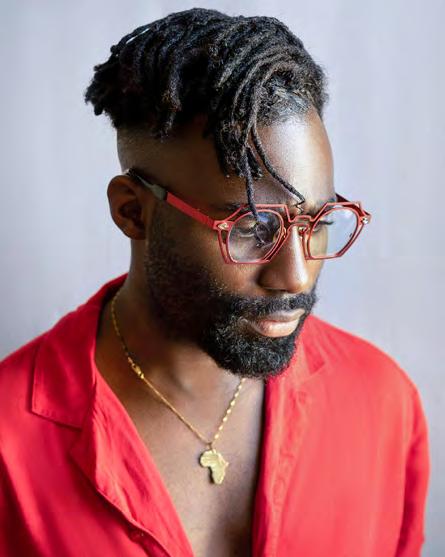
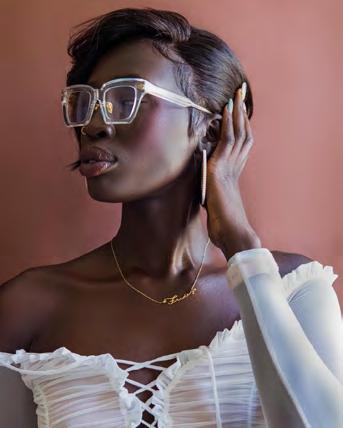
HANIFA
The visionary behind her label, Anifa Mvuemba, founded her clothing brand Hanifa in 2011, and since then, she has continued to deliver impeccable pieces specifically for women of color. She has created a brand of her own at the intersection of tech and luxury addressed to Black women whose curvier bodies are often underrepresented in the fashion industry. Her statement pieces feature an array of colors and textiles that cater to the natural curves of a woman’s body. The brand’s mission is to empower womenowned organizations that elevate fashion through passion, purpose, and social impact. @HANIFAOFFICIAL

 @SAVANTANDSCHOLAR SAVANTANDSCHOLAR.COM
@SAVANTANDSCHOLAR SAVANTANDSCHOLAR.COM
TROORA MAGAZINE 362
HANIFA.CO
Black-Owned Sustainable Brands to Love
ENVIRONMENTALLY-FRIENDLY COMPANIES FROM BLACK MALE AND FEMALE ENTREPRENEURS
How you spend your hardearned money can make a big impact on the world. That goes for ethical initiatives and uplifting the Black community by supporting sustainable Black-owned businesses. With the buying power of $1.2 trillion annually by the Black consumer, according to Nielson reports, there are tons of options when it comes to tapping into the consumer market. To ensure Black business owners and artisans are supported and the wealth in Black communities continues to grow, here are five Black-owned sustainable brands you and anyone else can support.
TRADE STREET JAM
Trade Street Jam Co. is at the crossroads of where Black- and women-owned businesses meet. Founded by a trained chef, owner Ashley Rouse likes to experiment with funky flavor combinations that result in unexpected jams that will become your new favorites. Rouse’s Trade Street Jams didn’t catch on by playing it safe but instead were curated using extensive knowledge about flavors and taking risks.
BY: @TRADESTJAMCO @THEJUNGALOW @SANCHOSSHOP @BLKANDGRN @ALAFFIA
WRITTEN BY: KEVIN JAMES JEFFERY
When you purchase a jar of jam from Trade Street, you don’t have to worry about all that pectin and preservatives. All their jars are cleaned, sanitized, and hot-filled with the freshest ingredients to ensure the least amount of oxygen enters the vessel. That means you can store their jars in your cabinet for up to a year—if necessary. Enjoy bizarrely delicious favorites like Strawberry Chipotle & Fig, Smoked Yellow Peach, Blackberry Mulled Merlot, and many more. All of which are vegan, low sugar, locally sourced, small batch, and freakin’ delicious.

PHOTOGRAPHED
@TRADESTJAMCO TRADESTJAMCO.COM 363 TROORA BLACK HISTORY ISSUE 2023
JUNGALOW
If you’re ever browsing your social media and come across those L.A. bohemian-themed interiors decked out in green plants, cool pots, and eclectic decor, they might be thanks to Justina Blakely. Since starting as a small blog, Jungalow has become a fullfledged, established e-com site full of products like plants, pots, rugs, wall decor, wallpaper, and much more. But at the center of it all are plants—the centerpiece of any boho-centric room with that indoor-outdoor feel.
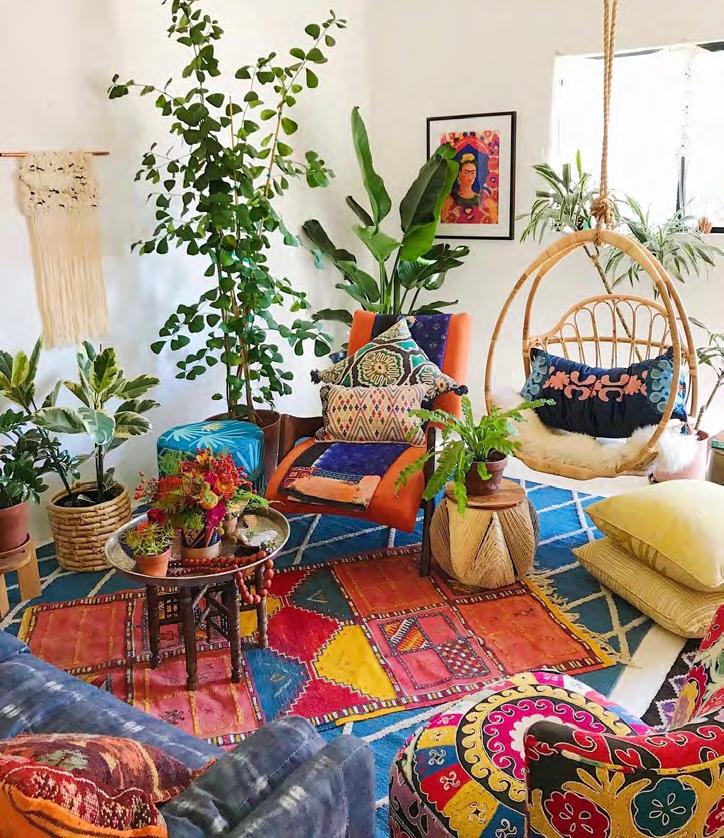
If you aren’t living in Southern California and want a piece of the action, don’t worry, the Jungalow lifestyle brand can now be found in Target stores. Wherever you find Jungalow products, all collections are designed in her Los Angeles studio with selections of artist prints from around the world. All their products are manufactured with the environment and communities in mind. That means ceramics from Vietnam, textiles from India, printed wallpapers from the U.S., and other vendors that look out for people.
SANCHO’S
Established in 2015, Sancho’s set to become a Black-owned, sustainable, affordable clothing and fair trade shop. It’s fair to say founder Kalkidan Legesse has accomplished that and more, as she was recently featured in the documentary series ‘Bossing It’ on BBC ONE. In her episode, she talks about building her sustainable fashion store from scratch and how difficult it is to access finance as a Black female. How exactly does Kalkidan ensure Sancho’s products are ethical and sustainable? It starts with a 5-step process: organic and recycled materials, a three-month guarantee to ensure high-quality, third-party accreditation so that no child labor is used, Black-owned inclusive brands, and helping their customers recycle clothing. From clothing to jewelry to accessories and home products, find everything sustainable and ethical under the sun at Sancho’s. @SANCHOSSHOP

@THEJUNGALOW JUNGALOW.COM
SANCHO'S
SANCHOSSHOP.COM TROORA MAGAZINE 364
BLK + GRN
Founder Dr. Kristian Henderson has gone above and beyond to create not only a Black business but a Black artisan marketplace full of highquality, all-natural brands. Starting in 2017, Henderson used her public health professor background to launch an e-com business that now features 135 Black artisans from throughout the globe. BLK + GRN has also tested and curated over a thousand stockkeeping units of non-toxic, ethically sourced, and cruelty-free products. From eco-friendly cleaners to natural underarm deodorants and plant-based skin hydrating boosters, you can find all sorts of home goods, beauty, and wellness ideas at BLK + GRN. What better way to support Black business owners, shop ethically, and make a sustainable impact on the world all in one place? Thanks to people like Dr. Henderson, it’s easier than ever to live “green” and buy Black all at the same time. See all of BLK + GRN’s products on their website BLKGRN.com.

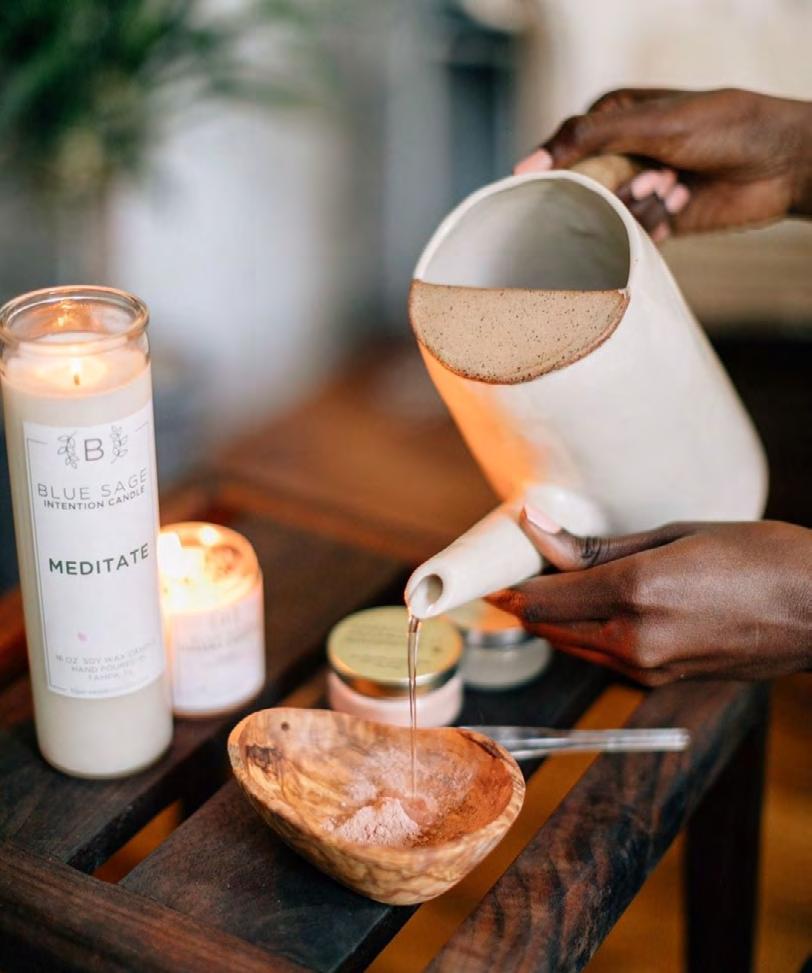
@BLKANDGRN BLKGRN.COM
ALAFFIA
“Alaffia is a greeting that means a state of peace, health, and well-being,” says founder and CEO Olowo-n’djo Tchala. The company out of Togo in Western Africa on the Gulf of Guinea sells clean, green, and fair trade beauty products. When you purchase their luxurious skin and hair care essentials that come from women-led co-ops, you’re helping African communities through its many philanthropies and sustainable products. Popular items include bath and body, hair, facial skincare, babies and kids, beautiful curls, and unscented products.
Alaffia’s story is one of empowerment through the success of their investments in providing resources for African communities. Some of the projects they support include education, maternal health, FGM eradication, eyeglasses, and environmental sustainability projects. Not only are they helping Togolese communities out of poverty, but they are also allowing them to provide their knowledge and skills to the world.
@ALAFFIA ALAFFIA.COM
365
Alaffia Founder
Brands We Love Troo Gifts
FARI DUSTER
Knee-length front kimono style duster

Unlined
½” trim
¾ sleeves
Two front inset pockets
Two side belt loops
Includes 3” wide belts
One size- fits up to 2XL
FABRIC CONTENT: 100% cotton.
Dimensions: Over-all length
PRICE: $147.00
loveiguehi.com @loveiguehi
CONVERTIBLE WRAP- SKIRT/ DRESS/TOP-TULA

Our one-size-fits-all wrap can be worn in multiple ways in any occasion. The Love Iguehi convertible wrap can be worn as a dress, as a skirt, as a vest, as a top and it can even be used as a stylish nursing cover up.
FABRIC CONTENT: Polyester cotton blend.

DIMENSION: Wrap skirt measures 48” x 25” with two long straps
PRICE: $89.99
loveiguehi.com @loveiguehi

TROORA
366
MAGAZINE
PRICE-UPON REQUEST


PALMA 1975 SET
Long sleeve shirt, classic collar, purple and blue print with elastic cuffs

Plus matching flare pants, with elastic waist
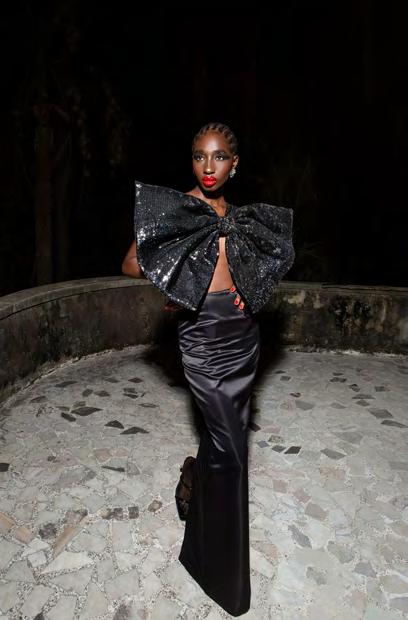

PRICE: €279.00 alledjo.com @alledjostudio
PERLA SILK SET
V neck white silk velvet shirt with small mother-of-pearls buttons + Relaxed matching pants
PRICE: €249.00 alledjo.com @alledjostudio
 Custom Design, Couture design by Nigerian Designer Vicnate
Custom Design, Couture design by Nigerian Designer Vicnate
367 TROORA BLACK HISTORY ISSUE 2023
Ig @vicnateng
SUSTAINABLE MAYA DRESS - SOLID CORAL
Elegant maxi wrap dress with exaggerated sleeves.


Maxi Dress
Available from XS to 3XL
Print designed in-house
Handcrafted in our small atelier in Dakar, Senegal
100% lyocell satin
PRICE: $295.00 diarrablu.com @thediarrablu

SATU DRESS - ATOLL BLU
Off-the-shoulder Maxi Dress
Perfect for an occasion to turn heads
Available from XS to 3XL
Print designed in-house
Handcrafted in our small atelier in Dakar, Senegal
Side slit
100% polyester
PRICE: $225.00 diarrablu.com @thediarrablu
TROORA MAGAZINE 368
SOPHIA ASYMMETRICAL MONIKINI
One-shoulder non-padded top Space for Padding ( Padding not included)
Sarong tie at waist
Couture Fit
Lined
Medium coverage bottom 100% Amni Soul Light (Ivory)

PRICE: $185.00 boldswim.com @bold_swim

BLUE ALLIUM BIKINI TOP AND BOTTOM

A true blue flower is a rare beauty, and so is this vivid, eye-catching suit.
Bandeau top with bamboo ring ties two ways giving every size different support options
Blue Allium is a sophisticated swim bottom. In a brilliant textured light blue terry-like fabric.
PRICE: TOP: $95 - BOTTOM: $95 https://boldswim.com/collections/bikinis
CLEAN SKIN CARE SUN SET
Perfect for Travel, Gift Giving, and an essential part of a healthy skincare routine

Does not contain Gluten, Soy, Nuts, or Dairy Paraben Free
PRICE: $145.00 boldswim.com @bold_swim
369 TROORA BLACK HISTORY ISSUE 2023
DARKNESS
Black Diamond Crown Fedora
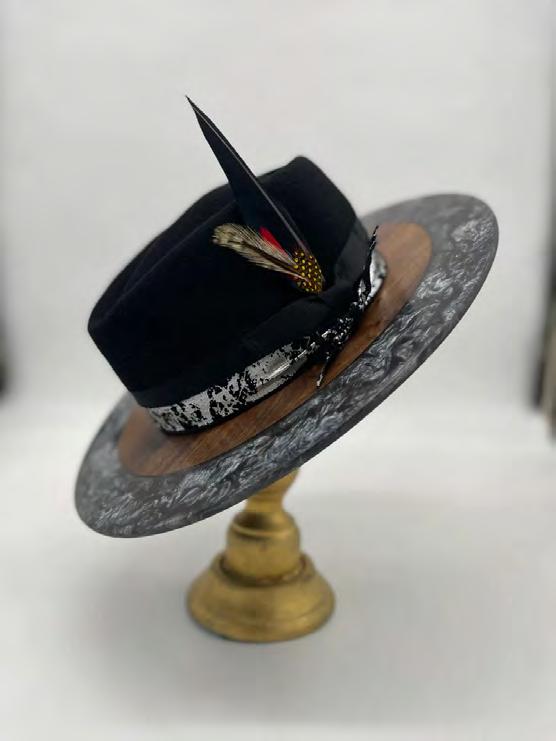
3" Walnut wood and Darkness Full Rim Epoxy
Grosgrain Hat Band w/feather
Custom Silver and Black trimming
PRICE: $500.00
@the_dapper_renaissance
BLUE BROTHERS
Navy Blue Crown
Cherrywood Brim X Navy Blue Epoxy

Navy Blue Hatband
Blue leather trim
Feathers
PRICE: $450.00
@the_dapper_renaissance

SUPREME CUSTOMIZABLE SKIN KIT
get glowing skin as smooth as butter with our customizable skincare kit. Products designed to gently cleanse, exfoliate, protect, and moisturize daily to uncover your best skin. Formulated especially for melanin rich complexions and all skin types. Just select your moisturizer -- to get glowing with Buttah smooth skin.

PRICE: $75.99
buttahskin.com
@buttahskin

370 TROORA MAGAZINE
5 PACK OF 5 OZ
Vegan, artisanal, full-fat coconut ice cream womanufacturer in Oakland, California. We believe you deserve ice cream that brings you joy — and justice.
Bittersweet Chocolate with Cacao Nibs
Coffee Latté
Key Lime
Madagascar Vanilla Bean
Salted Caramel with Toasted Pecans
PRICE: $50.00
kubenicecream.com

@kubenicecream
SIGNATURE COLLECTION

The Signature Collection is part of an Ashley Adams trademark concept established in 2017. The custom color palette is exclusive to her skin tone hues to reflect her biracial background. The abstracted collection style parallels her experience in society – always seen in fragments, never whole.



PRICE: $50.00
ashleyadamsart.com
@ashleyadams.artdesign
371
SEA ROPE CUFF
A silken rope cuff accented with bronze or sterling silver end caps. The Sea Rope Cuff features a thick, hand braided rope made with botanically dyed silk strands and finished with bronze or sterling silver end caps. The Sea Rope Cuff measures 6” around and can be adjusted by bending for a tighter or looser fit

PRICE: $184.00
stellafluorescent.com
@stellafluorescent
DEMI DOME EARRINGS

Celebration of the moon’s splendor, the Demi Dome Earrings are hand forged and hand painted. They measure 1” in diameter, are brass with an oil painted or unpainted inner surface, and feature sterling silver posts and earring backs.
PRICE: $146.00
stellafluorescent.com


@stellafluorescent
SIGNATURE FLATS - GISELLE
Add a pop of color to your shoe collection with the addition of these fabulous cream and yellow flats! The neutral cream colored leather perfectly contrasts the bright neon yellow shade of glossy patent leather for a versatile design that can essentially be worn during just about any season.

PRICE: $128.00
eightroyale.com
@eightroyale
SIGNATURE FLATS - MADONNA
These Madonna ballet flats will surely take your heart away as they can be easily paired with every outfit you own. The chic combination of black, grey, and royal blue colors and the metal studs at the front make the shoes look classy and sassy.

PRICE: $148.00
eightroyale.com
@eightroyale

TROORA MAGAZINE 372
GOLD METAL BAND
High-end double butterfly clasp (also known as a dual deployment clasp) that adds distinction other brands don't have. Fully-functional Miyota chronograph with independent sweeping secondhand ensures accuracy
Size: 46mm

PRICE: $235.00
talleyandtwine.com

@talleyandtwine
LINU DANGLES
A Classic redo, the beloved Paperclip designed as a multi layered geometric dangle earring with pin post. These can effortlessly take on double duty as both edgy and refined. Lightweight, allergy free, pair them with a classic crisp poplin, or t-shirt and jeans and prepare to take over the world!
14K Gold Plated Brass/ Hypoallergenic Pin Post

SIZE:
3”In H x 1” W
PRICE: $48.00
cocoacentric.com
@cocoacentric
XELANI HORN CHOKER

Sleek modern, easy on, open front horn design is a statement all its own. Pair it with our dainty Sana hoop or chic Thiopian Ear Cuffs and be a complete knock out!
Made of 100% Environmentally friendly Brass
18K Gold Plate
Long Lasting Tarnish-resistant

PRICE: $110.00
cocoacentric.com
@cocoacentric

373 TROORA BLACK HISTORY ISSUE 2023

Inspired by a love of vintage pieces, flowing feminine dresses, florals, and life by the sea. cobblerslane.com


self-care
ettaandbillie.com



natural body care
artisanal, organic body care
isn’t a luxury, it’s a necessity for our own well-being


of

basilracuk.com
 Modern style, created by hand. Each piece is bespoke and custom made using the best European tanneries and materials.
Sourced small batches
materials, with the idea that scarcity is the ultimate luxury.
Modern style, created by hand. Each piece is bespoke and custom made using the best European tanneries and materials.
Sourced small batches
materials, with the idea that scarcity is the ultimate luxury.



tomfoolery.la



Photographer: Elias Gurrola instagram.com/eliasgurrola twitter.com/Elias_Gurrola facebook.com/eliasgurroladesign pinterest.com/eliasgurrola/_created eliasgurrola.com


Quality, Design and Functionality. We love creating accessories to be worn year round.




landabags.com
100% NATURAL SOY WAX FREE OF DYES 7 SYNTHETIC FRANGRANCE


PREMIUM BLEND OF FRAGRANCE OILS & ESSENTIAL OILS


HAND-POURED IN SONOMA COUNTY, CA
 CLONE 400 - GRAPEFRUIT, NECTAR, TROPICAL HWY 128 - WHITE TEA, HONEYSUCKLE, CLEAN CLONE 595 - WARM, SENSUAL, AMBER
MINI TRIO CANDLE
CLONE 400 - GRAPEFRUIT, NECTAR, TROPICAL HWY 128 - WHITE TEA, HONEYSUCKLE, CLEAN CLONE 595 - WARM, SENSUAL, AMBER
MINI TRIO CANDLE





 Lucid Motors Luxury mobility company reimagining what a car can be.
Lucid Motors Luxury mobility company reimagining what a car can be.



 Lucid Motors Luxury mobility company reimagining what a car can be.
Lucid Motors Luxury mobility company reimagining what a car can be.

























 Founder Carla Truitt
- GabriellleGabrielle shoes are made of Sumptuous suede and daring good looks for slipping out on a midnight adventure.
Founder Carla Truitt
- GabriellleGabrielle shoes are made of Sumptuous suede and daring good looks for slipping out on a midnight adventure.



























































































































 Founder Francesca Baur
Founder Francesca Baur



















 Peruvian Wall Mirror - Black Sunburst
Peruvian Wall Mirror - Black Sunburst





















 The world’s first highly sustainable and environmentally friendly organic material made of Nopal cactus, also known as the prickly pear.
The world’s first highly sustainable and environmentally friendly organic material made of Nopal cactus, also known as the prickly pear.
 PHOTOGRAPHED BY: LEAH ALEXANDER
WRITTEN BY: CRISTINA DEPTULA
Leah Alexander
PHOTOGRAPHED BY: LEAH ALEXANDER
WRITTEN BY: CRISTINA DEPTULA
Leah Alexander
























 WRITTEN BY: KEVIN JAMES JEFFERY
P HOTO CREDIT: @ABBEYCREEKWINE
WRITTEN BY: KEVIN JAMES JEFFERY
P HOTO CREDIT: @ABBEYCREEKWINE










 Chef Debra VanTrece
Chef Debra VanTrece



 Paella Grits
Lamb Shank
Paella Grits
Lamb Shank

 PHOTO CREDIT: MIA YAKEL
PHOTO CREDIT: JOSH SWINNEY
PHOTO CREDIT: MIA YAKEL
PHOTO CREDIT: JOSH SWINNEY









 WRITTEN BY: CARY WONG
WRITTEN BY: CARY WONG






















 @PHILLIPASHLEY @PHILLIPASHLEYCHOCOLATES
@PHILLIPASHLEY @PHILLIPASHLEYCHOCOLATES



 BY: NIZIE LOKMAN
BY: NIZIE LOKMAN





















 American Beach, 2021
American Beach, 2021


 Woolworth Theater, 2022
Woolworth Theater, 2022


 Bronzeville, 1940s
Bronzeville, 1940s































 PHOTOGRAPHED BY: @JESSICANABONGO
WRITTEN BY: CRISTINA DEPTULA
PHOTOGRAPHED BY: @JESSICANABONGO
WRITTEN BY: CRISTINA DEPTULA






















 PHOTO CREDIT: COURTESY OF INVISIBLE BORDERS TRANS-AFRICAN ORGANISATION
WRITTEN BY: FILIPA ARAÚJO
A moment, a pause. Agbokim Waterfall, Ikom, Nigeria
PHOTO CREDIT: COURTESY OF INVISIBLE BORDERS TRANS-AFRICAN ORGANISATION
WRITTEN BY: FILIPA ARAÚJO
A moment, a pause. Agbokim Waterfall, Ikom, Nigeria



























 Installation view of Retreat, The Black Artists Retreat, 2017
Installation view of Retreat, The Black Artists Retreat, 2017













 WRITTEN BY: FILIPA ARAÚJO
WRITTEN BY: FILIPA ARAÚJO

 Mohau Modisakeng
Mohau Modisakeng


































 Archer Bag Blue Metallic
Archer Bag Blue Metallic

 Archer Bag Copper Metallic
Archer Bag Copper Metallic



















 WRITTEN BY: KEVIN JAMES JEFFERY
PHOTO CREDIT: @MAMIWATASURF
WRITTEN BY: KEVIN JAMES JEFFERY
PHOTO CREDIT: @MAMIWATASURF









 Fanm Mon Founder
Fanm Mon Founder




















 Annie MaloneThe Turnbo family
Madame C.J. Walker
Annie MaloneThe Turnbo family
Madame C.J. Walker
























 BY: JESSE ADUMA
BY: JESSE ADUMA


 Dr. Beth Thomas
Dr. Beth Thomas




 PHOTOGRAPHED BY: BLACK HEALTH MATTERS
WRITTEN BY: JESSE ADUMA
PHOTOGRAPHED BY: BLACK HEALTH MATTERS
WRITTEN BY: JESSE ADUMA










 BY: CRISTINA DEPTULA
BY: CRISTINA DEPTULA

























 The Digital Oxford Shirt Modern prints, gender-free fit and responsibly made from fiber to thread.
The Digital Oxford Shirt Modern prints, gender-free fit and responsibly made from fiber to thread.
 WRITTEN BY: GEORGE DIKE
WRITTEN BY: GEORGE DIKE







 WRITTEN BY: GEORGE DIKE
WRITTEN BY: GEORGE DIKE









 WRITTEN BY: GEORGE DIKE
WRITTEN BY: GEORGE DIKE























 PHOTOGRAPHED BY: POCHINO PRESS
WRITTEN BY: CRISTINA DEPTULA
PHOTOGRAPHED BY: POCHINO PRESS
WRITTEN BY: CRISTINA DEPTULA


















 PHOTO CREDIT: @CASSMICHAELPHOTOGRAPHY
Nubian Skin founder Ade Hassan
PHOTO CREDIT: @CASSMICHAELPHOTOGRAPHY
Nubian Skin founder Ade Hassan


 PHOTO CREDITS: @RAHHELWOLDU
K Nature Founder
PHOTO CREDITS: @RAHHELWOLDU
K Nature Founder




 @KEEYAHRI KEEYAHRI.COM
KEEYAHRI
@KEEYAHRI KEEYAHRI.COM
KEEYAHRI








 @SAVANTANDSCHOLAR SAVANTANDSCHOLAR.COM
@SAVANTANDSCHOLAR SAVANTANDSCHOLAR.COM














 Custom Design, Couture design by Nigerian Designer Vicnate
Custom Design, Couture design by Nigerian Designer Vicnate






































 Modern style, created by hand. Each piece is bespoke and custom made using the best European tanneries and materials.
Sourced small batches
materials, with the idea that scarcity is the ultimate luxury.
Modern style, created by hand. Each piece is bespoke and custom made using the best European tanneries and materials.
Sourced small batches
materials, with the idea that scarcity is the ultimate luxury.













 CLONE 400 - GRAPEFRUIT, NECTAR, TROPICAL HWY 128 - WHITE TEA, HONEYSUCKLE, CLEAN CLONE 595 - WARM, SENSUAL, AMBER
MINI TRIO CANDLE
CLONE 400 - GRAPEFRUIT, NECTAR, TROPICAL HWY 128 - WHITE TEA, HONEYSUCKLE, CLEAN CLONE 595 - WARM, SENSUAL, AMBER
MINI TRIO CANDLE